Tim Notier's Blog, page 7
February 27, 2021
Safety in Africa
By Marisa Notier The Notier Notes Our Sunday Scoop 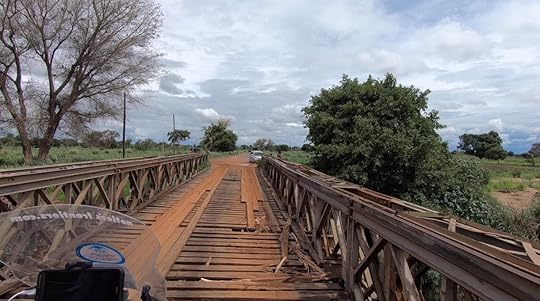 You might have heard a few horror stories about Africa - violence, war zones, corrupt officers and guards, and when it comes to travelers, robberies where people's bikes have been torn apart, and all their stuff stolen. Traveling by motorcycle can always be risky, but we had heard that Africa was on a whole new level. At the same time, we always wanted let the cities and the people within present the truth of the matter, good or bad.
You might have heard a few horror stories about Africa - violence, war zones, corrupt officers and guards, and when it comes to travelers, robberies where people's bikes have been torn apart, and all their stuff stolen. Traveling by motorcycle can always be risky, but we had heard that Africa was on a whole new level. At the same time, we always wanted let the cities and the people within present the truth of the matter, good or bad.
Thankfully, I'm happy to say that so far in Africa, nothing major has happened to us. Someone once tampered with our bike one night in Tanzania (but Tim heard him and scared him away), and there were a few places in South Africa where we didn't feel safe. But besides that, we've been very fortunate. Of course, we're always aware of what could happen, and are always trying to stay one step ahead the game.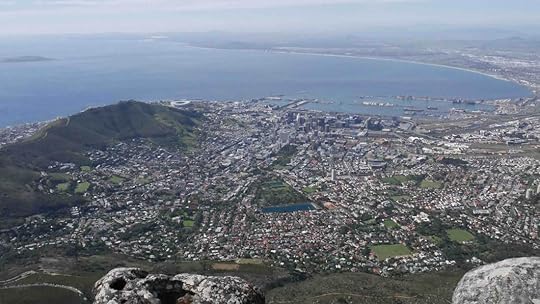 Cape Town sure is a lovely city. South Africa might take the cake for one of the most dangerous countries we've been through. Road safety is pretty good, infrastructure is great, and the people are so wonderful and friendly, but the crime rate there is through the roof. Every hotel and campground was walled in, some with pretty high-tech surveillance. Every house that can afford it has signs advertising the private security team that they employ in emergencies. In fact, I heard a statistic that security is Africa's number one industry. And just from looking around, it seems to be true.
Cape Town sure is a lovely city. South Africa might take the cake for one of the most dangerous countries we've been through. Road safety is pretty good, infrastructure is great, and the people are so wonderful and friendly, but the crime rate there is through the roof. Every hotel and campground was walled in, some with pretty high-tech surveillance. Every house that can afford it has signs advertising the private security team that they employ in emergencies. In fact, I heard a statistic that security is Africa's number one industry. And just from looking around, it seems to be true.
We started our journey in Cape Town where I bought some pepper spray to keep with me. I also carry an alarm key chain on my purse that I can just pull to turn on a high-decibel alarm. I have every emergency number in my phone to the US Embassies in all the countries we go to, and I've also registered with the embassies to receive their safety emails. Those have been great to warn Americans about potential protests, and even things we may not think of, like how wearing camouflage clothing can get you arrested out here (which makes sense in countries with a military presence on the street). This is definitely not safe... As we moved north from South Africa, things started to look less fortified, but of course, certain precautions against attacks and theft were always in place. Every house will have bars over the windows, and parking lots to supermarkets, banks, and other general stores will have armed security guards on watch at all times. Apartment buildings will always have a night guard.
This is definitely not safe... As we moved north from South Africa, things started to look less fortified, but of course, certain precautions against attacks and theft were always in place. Every house will have bars over the windows, and parking lots to supermarkets, banks, and other general stores will have armed security guards on watch at all times. Apartment buildings will always have a night guard.
In Kampala, the capital city of Uganda, everyone etches their license plate number onto their car's side mirrors, windows, and windshield. This is so that if these parts are stolen off their car, they can't be easily resold. But I mean, windshield!
Every time you hop in an Uber, it may be a million degrees out, but they'll tell you to keep your windows rolled up. This is so that people walking by or riding by on a motorcycle can't reach in the car and snatch your phone, purse, or anything else you have in there.
Our home here in Kenya has some extra safety features as well. We have panic switches in every bedroom that sets off a siren and lights on the top of the house.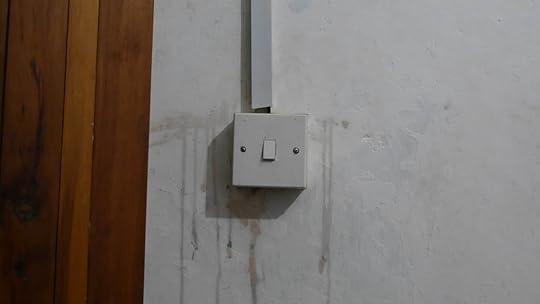 Looks like a light switch, right? And don't ask us what fluids are leaking from it... And then there are those weirdo doors. We've noticed them throughout East Africa, and they take a bit of getting used to, but I guess in the end they make sense.
Looks like a light switch, right? And don't ask us what fluids are leaking from it... And then there are those weirdo doors. We've noticed them throughout East Africa, and they take a bit of getting used to, but I guess in the end they make sense.
First of all, they're always metal. And although they can usually be locked from the outside, most of the locking is happening on the inside. This is just an extra layer of protection to make sure the locks can't be tampered with. But since it's on the inside, that means that in order to access the padlocks, you have to stick your hand through a hole.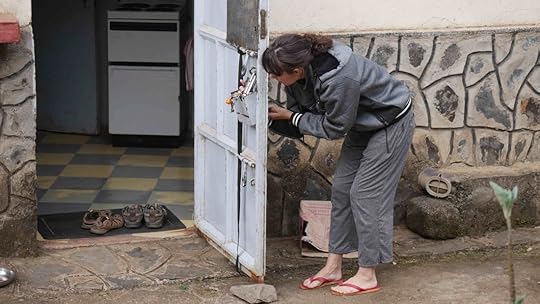 That's right. You open the flap and then put your hand through the hole in the door to blindly mess around with the key and padlock. Not so easy, especially with one hand. Then once you get the padlock off (and assuming you don't drop your key inside which would just be the end of everything), you have to undo the deadbolt, and you're in! Easy as pie, right?
That's right. You open the flap and then put your hand through the hole in the door to blindly mess around with the key and padlock. Not so easy, especially with one hand. Then once you get the padlock off (and assuming you don't drop your key inside which would just be the end of everything), you have to undo the deadbolt, and you're in! Easy as pie, right? 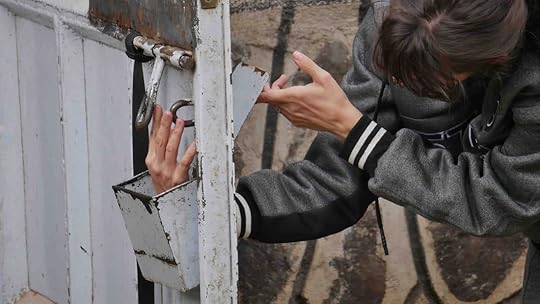 Now having said all this, we actually feel quite safe here in Nanyuki. It's a pretty well-off town with lots of foreigners, and we live down the block from the police station. Also, we pay a monthly fee for a private security team to patrol the area at night, and we have a neighbor who lives in front of our house 24/7 and literally keeps "guard" over everything all the time.
Now having said all this, we actually feel quite safe here in Nanyuki. It's a pretty well-off town with lots of foreigners, and we live down the block from the police station. Also, we pay a monthly fee for a private security team to patrol the area at night, and we have a neighbor who lives in front of our house 24/7 and literally keeps "guard" over everything all the time.
Last week, we had a bonus moat of raw sewage that temporarily kept out any potential thieves, and we have three guard cats to keep us protected at all times.
So we feel very safe and are extremely comfortable. Goats 'baa' throughout the day in our neighbor's yard, and cows leave their special pies in our front yard when they graze on the grass. Life is pretty simple here. People are friendly and we don't feel that we are in any danger. But we like to adhere to common sense, and to not draw attention to ourselves. No flashy jewelry, we don't take out thick wads of currency to pay for tuk tuks (small motorcycle taxis). We just try to blend in with the crowd. It is a great feeling when the women at the grocery store know you by your first name, when they ask how your spouse is doing, and when you feel like you have slowly immersed into the daily lives of everyone in town.
We sometimes feel that we are no longer outsiders, and a natural safety net is being built from the trust and care that naturally evolves when you become part of the community.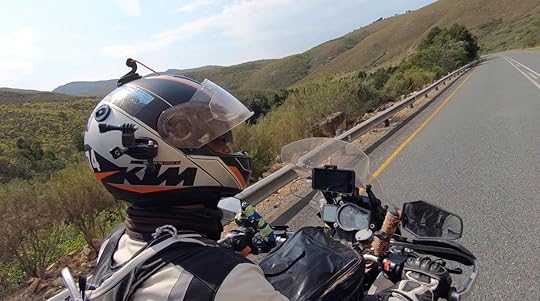 I hope everyone out there stays safe, and is also counting their lucky stars.
I hope everyone out there stays safe, and is also counting their lucky stars.
Next week, I'll go over some of our adventures in Uganda! See you then!
Subscribe to Our Blog
 You might have heard a few horror stories about Africa - violence, war zones, corrupt officers and guards, and when it comes to travelers, robberies where people's bikes have been torn apart, and all their stuff stolen. Traveling by motorcycle can always be risky, but we had heard that Africa was on a whole new level. At the same time, we always wanted let the cities and the people within present the truth of the matter, good or bad.
You might have heard a few horror stories about Africa - violence, war zones, corrupt officers and guards, and when it comes to travelers, robberies where people's bikes have been torn apart, and all their stuff stolen. Traveling by motorcycle can always be risky, but we had heard that Africa was on a whole new level. At the same time, we always wanted let the cities and the people within present the truth of the matter, good or bad.Thankfully, I'm happy to say that so far in Africa, nothing major has happened to us. Someone once tampered with our bike one night in Tanzania (but Tim heard him and scared him away), and there were a few places in South Africa where we didn't feel safe. But besides that, we've been very fortunate. Of course, we're always aware of what could happen, and are always trying to stay one step ahead the game.
 Cape Town sure is a lovely city. South Africa might take the cake for one of the most dangerous countries we've been through. Road safety is pretty good, infrastructure is great, and the people are so wonderful and friendly, but the crime rate there is through the roof. Every hotel and campground was walled in, some with pretty high-tech surveillance. Every house that can afford it has signs advertising the private security team that they employ in emergencies. In fact, I heard a statistic that security is Africa's number one industry. And just from looking around, it seems to be true.
Cape Town sure is a lovely city. South Africa might take the cake for one of the most dangerous countries we've been through. Road safety is pretty good, infrastructure is great, and the people are so wonderful and friendly, but the crime rate there is through the roof. Every hotel and campground was walled in, some with pretty high-tech surveillance. Every house that can afford it has signs advertising the private security team that they employ in emergencies. In fact, I heard a statistic that security is Africa's number one industry. And just from looking around, it seems to be true.We started our journey in Cape Town where I bought some pepper spray to keep with me. I also carry an alarm key chain on my purse that I can just pull to turn on a high-decibel alarm. I have every emergency number in my phone to the US Embassies in all the countries we go to, and I've also registered with the embassies to receive their safety emails. Those have been great to warn Americans about potential protests, and even things we may not think of, like how wearing camouflage clothing can get you arrested out here (which makes sense in countries with a military presence on the street).
 This is definitely not safe... As we moved north from South Africa, things started to look less fortified, but of course, certain precautions against attacks and theft were always in place. Every house will have bars over the windows, and parking lots to supermarkets, banks, and other general stores will have armed security guards on watch at all times. Apartment buildings will always have a night guard.
This is definitely not safe... As we moved north from South Africa, things started to look less fortified, but of course, certain precautions against attacks and theft were always in place. Every house will have bars over the windows, and parking lots to supermarkets, banks, and other general stores will have armed security guards on watch at all times. Apartment buildings will always have a night guard.In Kampala, the capital city of Uganda, everyone etches their license plate number onto their car's side mirrors, windows, and windshield. This is so that if these parts are stolen off their car, they can't be easily resold. But I mean, windshield!
Every time you hop in an Uber, it may be a million degrees out, but they'll tell you to keep your windows rolled up. This is so that people walking by or riding by on a motorcycle can't reach in the car and snatch your phone, purse, or anything else you have in there.
Our home here in Kenya has some extra safety features as well. We have panic switches in every bedroom that sets off a siren and lights on the top of the house.
 Looks like a light switch, right? And don't ask us what fluids are leaking from it... And then there are those weirdo doors. We've noticed them throughout East Africa, and they take a bit of getting used to, but I guess in the end they make sense.
Looks like a light switch, right? And don't ask us what fluids are leaking from it... And then there are those weirdo doors. We've noticed them throughout East Africa, and they take a bit of getting used to, but I guess in the end they make sense.First of all, they're always metal. And although they can usually be locked from the outside, most of the locking is happening on the inside. This is just an extra layer of protection to make sure the locks can't be tampered with. But since it's on the inside, that means that in order to access the padlocks, you have to stick your hand through a hole.
 That's right. You open the flap and then put your hand through the hole in the door to blindly mess around with the key and padlock. Not so easy, especially with one hand. Then once you get the padlock off (and assuming you don't drop your key inside which would just be the end of everything), you have to undo the deadbolt, and you're in! Easy as pie, right?
That's right. You open the flap and then put your hand through the hole in the door to blindly mess around with the key and padlock. Not so easy, especially with one hand. Then once you get the padlock off (and assuming you don't drop your key inside which would just be the end of everything), you have to undo the deadbolt, and you're in! Easy as pie, right?  Now having said all this, we actually feel quite safe here in Nanyuki. It's a pretty well-off town with lots of foreigners, and we live down the block from the police station. Also, we pay a monthly fee for a private security team to patrol the area at night, and we have a neighbor who lives in front of our house 24/7 and literally keeps "guard" over everything all the time.
Now having said all this, we actually feel quite safe here in Nanyuki. It's a pretty well-off town with lots of foreigners, and we live down the block from the police station. Also, we pay a monthly fee for a private security team to patrol the area at night, and we have a neighbor who lives in front of our house 24/7 and literally keeps "guard" over everything all the time.
Last week, we had a bonus moat of raw sewage that temporarily kept out any potential thieves, and we have three guard cats to keep us protected at all times.
So we feel very safe and are extremely comfortable. Goats 'baa' throughout the day in our neighbor's yard, and cows leave their special pies in our front yard when they graze on the grass. Life is pretty simple here. People are friendly and we don't feel that we are in any danger. But we like to adhere to common sense, and to not draw attention to ourselves. No flashy jewelry, we don't take out thick wads of currency to pay for tuk tuks (small motorcycle taxis). We just try to blend in with the crowd. It is a great feeling when the women at the grocery store know you by your first name, when they ask how your spouse is doing, and when you feel like you have slowly immersed into the daily lives of everyone in town.
We sometimes feel that we are no longer outsiders, and a natural safety net is being built from the trust and care that naturally evolves when you become part of the community.
 I hope everyone out there stays safe, and is also counting their lucky stars.
I hope everyone out there stays safe, and is also counting their lucky stars.Next week, I'll go over some of our adventures in Uganda! See you then!
Subscribe to Our Blog
Published on February 27, 2021 22:25
February 20, 2021
Knee-Deep in a Crappy Situation
By Marisa Notier The Notier Notes Our Sunday Scoop 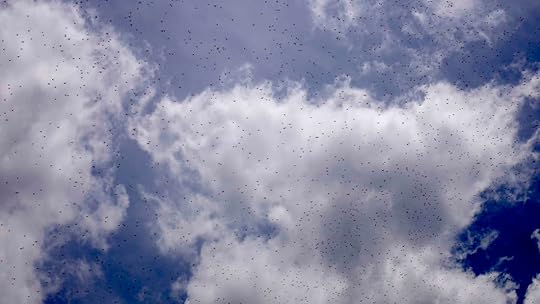 This week has been a lesson for many of us on the power of nature. Back home across much of the US, winter storms have been debilitating, sometimes even deadly. And it just goes to show that no matter how much we try to control our surroundings, every once in a while, nature deals a heavy blow.
This week has been a lesson for many of us on the power of nature. Back home across much of the US, winter storms have been debilitating, sometimes even deadly. And it just goes to show that no matter how much we try to control our surroundings, every once in a while, nature deals a heavy blow.
Here in Kenya, we learned this lesson twice this week, and the first time was with sewage.
We think we have it all under control - we flush our toilets, and it's gone forever. But we don't expect the entire town's sewage line to clog due to storms and washed up debris, and for everything to return to us and back-flow onto our property. But that's exactly what happened.
I was living my life quite happily not ever knowing about the strange things that people flush down their toilets here - batteries, chip bags, large screws, pieces of metal, wires, dirty diapers, and even avocado seeds! Who does that? And how did they manage to flush an entire diaper down the toilet?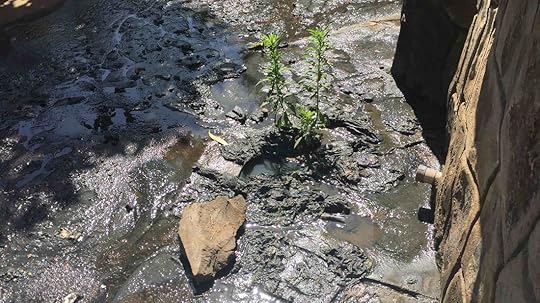 This is after the volcano stopped erupting. You can see the crater that used to be a drain hole. But first came the stench.
This is after the volcano stopped erupting. You can see the crater that used to be a drain hole. But first came the stench.
Then I heard Tim screaming at me from downstairs. And when I arrived at our kitchen door, I saw a sea of sewage creating a stinky moat around the house. It was spewing up out of the nearby drain pipe like a geyser. And it wasn't just water, but lots of garbage and clumps of literal feces. And worst of all, it wasn't stopping.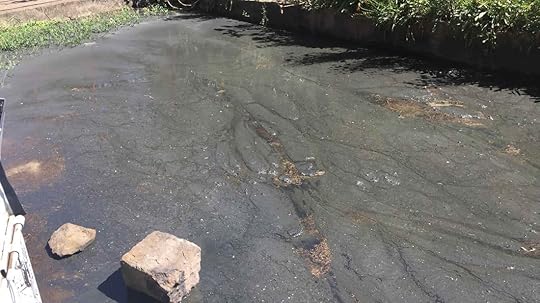 I didn't realize it at the time, but our house is built right over the sewage line for the whole town of Nanyuki. Perfect.
I didn't realize it at the time, but our house is built right over the sewage line for the whole town of Nanyuki. Perfect.
The landlord and plumbers were immediately called, and I'm happy to say that they came right away and fixed the blockage. It was nerve-wracking for a while because the house is not built on any higher ground than the rest of the property, so I was concerned that if the level of sewage raised an additional inch, it would flood the whole house. I watched that line of blackness creep closer and closer to the door, but the workers came, the volcano stopped its eruption, and the house was saved.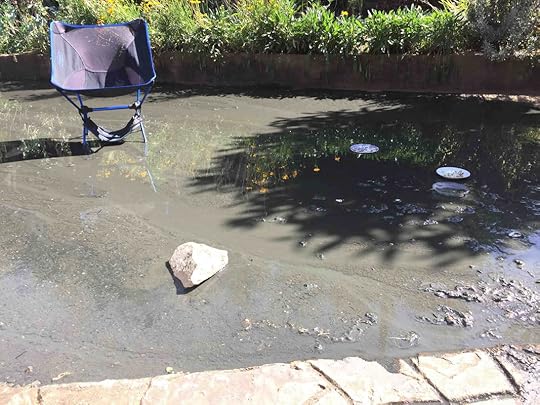 The lovely view from the front door. Next we had to figure out what to do with the lake of muck outside of our front door. I don't know what people do in the States when this happens. I'm assuming sub-pumps and other machinery are involved. But I'm not sure any of that exists out here.
The lovely view from the front door. Next we had to figure out what to do with the lake of muck outside of our front door. I don't know what people do in the States when this happens. I'm assuming sub-pumps and other machinery are involved. But I'm not sure any of that exists out here.
Yet once again, the people of Africa proved to be as optimistic and as helpful as ever, never letting a neighbor suffer. Right away, the neighbors all came by to give a hand. One woman, Sara, grabbed a hose, gave me a smile, and said to me, "Don't worry, we will clean this all up. It will be gone soon." And I was in awe that a neighbor who had nothing to do with any of this, would literally step right into the muck and even smile as she faced the situation. She immediately put me at ease, and she was right - it took a few days, but it all got cleaned up.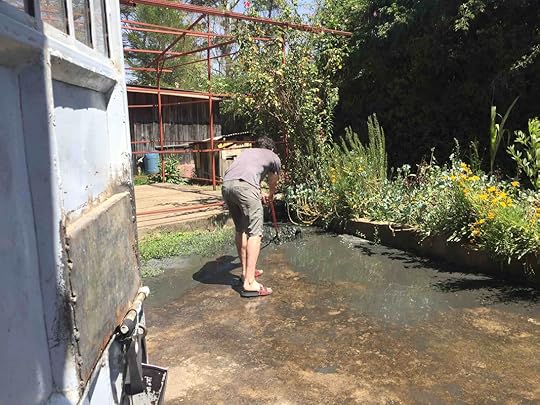 Africa is obviously not the only place in the world with sewage problems. I've had similar things happen to me in Chicago, and I once lived in a new development in the desert of the United Arab Emirates that had some real sewage issues. Proper drainage was not adequately planned for (it doesn't rain much in Dubai), and so when the streets starting filling up with sewage, it just sat there for weeks. You had to drive your car through streets of fecal water that could be as much as a foot deep. The place was called International City, but people started calling it International Shitty.
Africa is obviously not the only place in the world with sewage problems. I've had similar things happen to me in Chicago, and I once lived in a new development in the desert of the United Arab Emirates that had some real sewage issues. Proper drainage was not adequately planned for (it doesn't rain much in Dubai), and so when the streets starting filling up with sewage, it just sat there for weeks. You had to drive your car through streets of fecal water that could be as much as a foot deep. The place was called International City, but people started calling it International Shitty.
So yes, it can happen anywhere. But it's very heartwarming to see so many neighbors come together to help us. Even the landlord with his nice slacks and leather shoes got into the grime to help clean. And for that we're incredibly thankful.
There's still a lingering smell, but Tim bought more incense for the house than the Pope in Rome has ever purchased. And everyday, the stench gets a little bit better.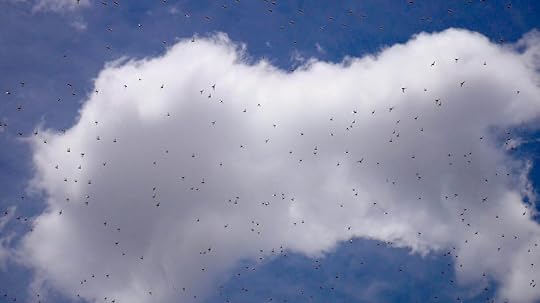 In other end of times news, we also got swarmed with locusts this week. It was the power of nature once again.
In other end of times news, we also got swarmed with locusts this week. It was the power of nature once again.
I stepped outside and noticed these strange little shadows darting across the ground, like shadows of a flock of birds flying overhead. But these didn't stop.
I looked up and immediately realized that it was not birds making the shadows, but giant insects. And thousands of them, no, millions of them! Biblical proportions!
The swarm must have been miles long, bigger than our entire town. They weren't clustered together so tight that they blocked out the sun, but I could see how terrifying it would be if they had been. And even with them spaced out, the whole fifteen minutes or so of them buzzing overhead was creepy. You could hear their little paper wings flapping, and you just felt helpless. Every inch of the sky looked like a pointillism painting, or the static on your television - zillions of dots moving everywhere.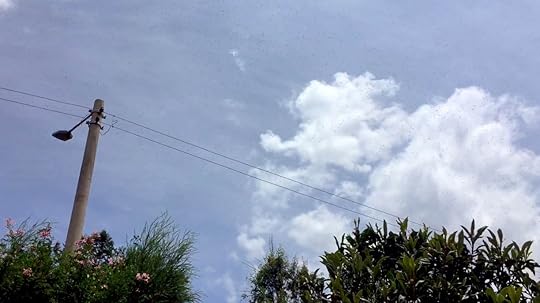 Can you see them all? Even with all the technology we have today, what can we possibly do against a swarm of locusts? How can you stop them all? The fact is, we're not much better off today than we were a thousand years ago. Once a swarm gets this big, there's nothing you can do. It's like a Twilight Zone or Black Mirror episode where the tiny robots are all invading, and you might be able to get a few of them down, but you'll never be able to take them all.
Can you see them all? Even with all the technology we have today, what can we possibly do against a swarm of locusts? How can you stop them all? The fact is, we're not much better off today than we were a thousand years ago. Once a swarm gets this big, there's nothing you can do. It's like a Twilight Zone or Black Mirror episode where the tiny robots are all invading, and you might be able to get a few of them down, but you'll never be able to take them all.
Thankfully, the swarm passed (and they didn't fly into my hair or else I'd be traumatized for life). Though I am concerned for all the surrounding farms, there's really nothing we can do. Just watch in awe at the power of nature.
It definitely gives us perspective. I hope your week has been less eventful than ours, and I hope everyone out there is staying warm, safe, and that your toilets all properly flush!
See you next Sunday! Subscribe to Our Blog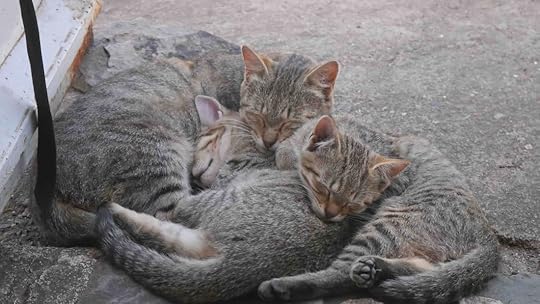 And now... some of the best that nature has to offer - a cuddle of kitties.
And now... some of the best that nature has to offer - a cuddle of kitties.
 This week has been a lesson for many of us on the power of nature. Back home across much of the US, winter storms have been debilitating, sometimes even deadly. And it just goes to show that no matter how much we try to control our surroundings, every once in a while, nature deals a heavy blow.
This week has been a lesson for many of us on the power of nature. Back home across much of the US, winter storms have been debilitating, sometimes even deadly. And it just goes to show that no matter how much we try to control our surroundings, every once in a while, nature deals a heavy blow.Here in Kenya, we learned this lesson twice this week, and the first time was with sewage.
We think we have it all under control - we flush our toilets, and it's gone forever. But we don't expect the entire town's sewage line to clog due to storms and washed up debris, and for everything to return to us and back-flow onto our property. But that's exactly what happened.
I was living my life quite happily not ever knowing about the strange things that people flush down their toilets here - batteries, chip bags, large screws, pieces of metal, wires, dirty diapers, and even avocado seeds! Who does that? And how did they manage to flush an entire diaper down the toilet?
 This is after the volcano stopped erupting. You can see the crater that used to be a drain hole. But first came the stench.
This is after the volcano stopped erupting. You can see the crater that used to be a drain hole. But first came the stench.Then I heard Tim screaming at me from downstairs. And when I arrived at our kitchen door, I saw a sea of sewage creating a stinky moat around the house. It was spewing up out of the nearby drain pipe like a geyser. And it wasn't just water, but lots of garbage and clumps of literal feces. And worst of all, it wasn't stopping.
 I didn't realize it at the time, but our house is built right over the sewage line for the whole town of Nanyuki. Perfect.
I didn't realize it at the time, but our house is built right over the sewage line for the whole town of Nanyuki. Perfect.The landlord and plumbers were immediately called, and I'm happy to say that they came right away and fixed the blockage. It was nerve-wracking for a while because the house is not built on any higher ground than the rest of the property, so I was concerned that if the level of sewage raised an additional inch, it would flood the whole house. I watched that line of blackness creep closer and closer to the door, but the workers came, the volcano stopped its eruption, and the house was saved.
 The lovely view from the front door. Next we had to figure out what to do with the lake of muck outside of our front door. I don't know what people do in the States when this happens. I'm assuming sub-pumps and other machinery are involved. But I'm not sure any of that exists out here.
The lovely view from the front door. Next we had to figure out what to do with the lake of muck outside of our front door. I don't know what people do in the States when this happens. I'm assuming sub-pumps and other machinery are involved. But I'm not sure any of that exists out here.Yet once again, the people of Africa proved to be as optimistic and as helpful as ever, never letting a neighbor suffer. Right away, the neighbors all came by to give a hand. One woman, Sara, grabbed a hose, gave me a smile, and said to me, "Don't worry, we will clean this all up. It will be gone soon." And I was in awe that a neighbor who had nothing to do with any of this, would literally step right into the muck and even smile as she faced the situation. She immediately put me at ease, and she was right - it took a few days, but it all got cleaned up.
 Africa is obviously not the only place in the world with sewage problems. I've had similar things happen to me in Chicago, and I once lived in a new development in the desert of the United Arab Emirates that had some real sewage issues. Proper drainage was not adequately planned for (it doesn't rain much in Dubai), and so when the streets starting filling up with sewage, it just sat there for weeks. You had to drive your car through streets of fecal water that could be as much as a foot deep. The place was called International City, but people started calling it International Shitty.
Africa is obviously not the only place in the world with sewage problems. I've had similar things happen to me in Chicago, and I once lived in a new development in the desert of the United Arab Emirates that had some real sewage issues. Proper drainage was not adequately planned for (it doesn't rain much in Dubai), and so when the streets starting filling up with sewage, it just sat there for weeks. You had to drive your car through streets of fecal water that could be as much as a foot deep. The place was called International City, but people started calling it International Shitty.So yes, it can happen anywhere. But it's very heartwarming to see so many neighbors come together to help us. Even the landlord with his nice slacks and leather shoes got into the grime to help clean. And for that we're incredibly thankful.
There's still a lingering smell, but Tim bought more incense for the house than the Pope in Rome has ever purchased. And everyday, the stench gets a little bit better.
 In other end of times news, we also got swarmed with locusts this week. It was the power of nature once again.
In other end of times news, we also got swarmed with locusts this week. It was the power of nature once again.I stepped outside and noticed these strange little shadows darting across the ground, like shadows of a flock of birds flying overhead. But these didn't stop.
I looked up and immediately realized that it was not birds making the shadows, but giant insects. And thousands of them, no, millions of them! Biblical proportions!
The swarm must have been miles long, bigger than our entire town. They weren't clustered together so tight that they blocked out the sun, but I could see how terrifying it would be if they had been. And even with them spaced out, the whole fifteen minutes or so of them buzzing overhead was creepy. You could hear their little paper wings flapping, and you just felt helpless. Every inch of the sky looked like a pointillism painting, or the static on your television - zillions of dots moving everywhere.
 Can you see them all? Even with all the technology we have today, what can we possibly do against a swarm of locusts? How can you stop them all? The fact is, we're not much better off today than we were a thousand years ago. Once a swarm gets this big, there's nothing you can do. It's like a Twilight Zone or Black Mirror episode where the tiny robots are all invading, and you might be able to get a few of them down, but you'll never be able to take them all.
Can you see them all? Even with all the technology we have today, what can we possibly do against a swarm of locusts? How can you stop them all? The fact is, we're not much better off today than we were a thousand years ago. Once a swarm gets this big, there's nothing you can do. It's like a Twilight Zone or Black Mirror episode where the tiny robots are all invading, and you might be able to get a few of them down, but you'll never be able to take them all.Thankfully, the swarm passed (and they didn't fly into my hair or else I'd be traumatized for life). Though I am concerned for all the surrounding farms, there's really nothing we can do. Just watch in awe at the power of nature.
It definitely gives us perspective. I hope your week has been less eventful than ours, and I hope everyone out there is staying warm, safe, and that your toilets all properly flush!
See you next Sunday! Subscribe to Our Blog
 And now... some of the best that nature has to offer - a cuddle of kitties.
And now... some of the best that nature has to offer - a cuddle of kitties.
Published on February 20, 2021 22:37
February 13, 2021
What I LOVE About Africa
By Marisa Notier The Notier Notes Our Sunday Scoop 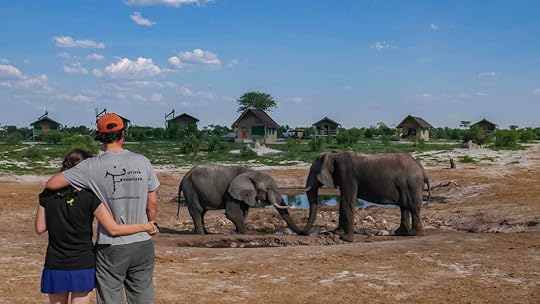 Since today is Valentine's day, I've decided to focus on my favorite emotion - love. And because we're here in Africa, I'd like to talk about some things that I love about this continent.
Since today is Valentine's day, I've decided to focus on my favorite emotion - love. And because we're here in Africa, I'd like to talk about some things that I love about this continent.
All too often, Africa gets a lot of negative press. You hear about wars and corruption and poverty, but you rarely ever hear about the incredible things that Africa has to offer, and what make this continent magnificent.
The following are my top 5 things that I love about Africa. # 1 - Africans Always Find a Way to Smile Being the world's poorest continent, Africans are no strangers to hardship. And yet, they seem to always find a way to stay positive, make the best of it, and smile.
Being the world's poorest continent, Africans are no strangers to hardship. And yet, they seem to always find a way to stay positive, make the best of it, and smile.
Some of this optimism may come from their tight-knit families and close communities. Oftentimes, several generations will live in a single house. And they don't seem to get annoyed with each other, but instead, they always have a joke ready for whatever life may throw at them. The proof of this is in their music. You never hear a sad sub-Saharan African song. They may sing about their struggles or their worries, but the song itself is always upbeat, in a major key, and will make you want to dance. The music of Africa brings people together, and everyone's always ready to bust out their dance moves, never ashamed of what people might think of them. Just letting the melodies and rhythms of the music flow through them.
The proof of this is in their music. You never hear a sad sub-Saharan African song. They may sing about their struggles or their worries, but the song itself is always upbeat, in a major key, and will make you want to dance. The music of Africa brings people together, and everyone's always ready to bust out their dance moves, never ashamed of what people might think of them. Just letting the melodies and rhythms of the music flow through them.
It's certainly inspiring. # 2 - Africans Are Resourceful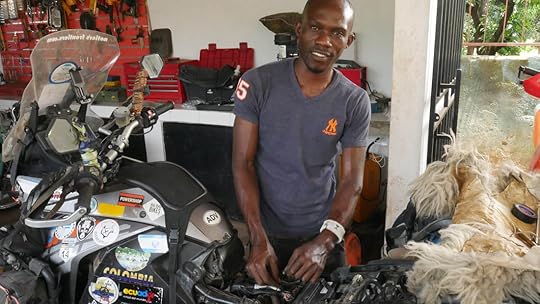 You never hear someone in Africa say, "It can't be done". Whenever they see a problem, they don't think, "Oh, why me?!" but instead see it as a challenge to overcome. And they may not have the right tool, or the right part, but they always seem to be able to figure it out with what they do have.
You never hear someone in Africa say, "It can't be done". Whenever they see a problem, they don't think, "Oh, why me?!" but instead see it as a challenge to overcome. And they may not have the right tool, or the right part, but they always seem to be able to figure it out with what they do have.
Case in point, we've broken down quite a few times while riding our motorcycle in Africa, and every time people seem to just come out of the woodwork and want to help. And they never dwell on the disaster in front of them, but just get right to work with coming up with solutions. When our radiator blew in South Africa, or the electrical system short-circuited in Tanzania, or even when our monoshock broke in Namibia, somebody with a great attitude was always there to help.
Now this is not to say that once it's fixed, the final product is of any quality. In fact, most things here are built on a foundation of string and duct tape (and the cheap Chinese version at that). But in the end it will work. Our friend Braden had a problem with the starter on his bike, and so some guy with a jig saw cut the part to pieces, which worked. But from then on the only way for Braden to start his bike was with a screw driver instead of a key. Still, it got him across the continent! # 3 - Africa is Vibrant Africa is a youthful, colorful land full of energy, passion, and sunshine. The parrots in the trees are as vivid as the fruits of the market stalls. The patterns of the kitenge cloths the women wear dazzle. The foods are bursting with flavor, and the smells of the spices prick at your nose.
Africa is a youthful, colorful land full of energy, passion, and sunshine. The parrots in the trees are as vivid as the fruits of the market stalls. The patterns of the kitenge cloths the women wear dazzle. The foods are bursting with flavor, and the smells of the spices prick at your nose.
It's hard to be sad here. Every morning you hear people sweeping their yards and sidewalks, humming and singing as if they're happy to bring on the new day. The church bells chime, the call to prayer fills the streets, and the children are everywhere, laughing and playing. This year has been hard on us all. And there was a time early on in the pandemic where I felt depressed about the state of the world. The dismal news, the constant checking of case numbers, it all upset me to my core. But I credit this incredible place for bringing me out of that funk. Because Africans know better than anyone that no matter what happens, life goes on. The children will play, the birds will sing, and that music and dancing will never end. # 4 - Africa is an Adventure
This year has been hard on us all. And there was a time early on in the pandemic where I felt depressed about the state of the world. The dismal news, the constant checking of case numbers, it all upset me to my core. But I credit this incredible place for bringing me out of that funk. Because Africans know better than anyone that no matter what happens, life goes on. The children will play, the birds will sing, and that music and dancing will never end. # 4 - Africa is an Adventure  Tim and I are adventure motorcyclists who ride an adventure bike. And it's true that you can have an amazing journey just about anywhere, but you don't have to look too far for an exciting or unusual experience in Africa. It comes to you.
Tim and I are adventure motorcyclists who ride an adventure bike. And it's true that you can have an amazing journey just about anywhere, but you don't have to look too far for an exciting or unusual experience in Africa. It comes to you.
"Don't go to the water's edge, there could be hippos or crocodiles," people tell us. Or, "Don't wear bright colors. A tsetse fly might bite you and you'll get the sleeping sickness." Or how about, "Don't drive at night, because it's amazing how well an elephant can blend into the darkness."
It just feels like Africa has upped the stakes with everything, and I love it.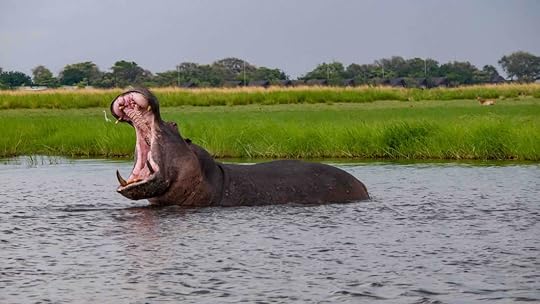 Not to mention, there are few places on earth with lands that are as untamed as Africa's. In fact, when it comes to wild animals, you can't get better than the height of the giraffe, the size of the elephant, the prehistoric look of the rhino, or the sheer numbers of migrating wildebeest and zebra. And these animals could be anywhere. You just never know what you'll find around the next curve in the road. # 5 - Africa Has Brought Tim and I Closer Than Ever Before
Not to mention, there are few places on earth with lands that are as untamed as Africa's. In fact, when it comes to wild animals, you can't get better than the height of the giraffe, the size of the elephant, the prehistoric look of the rhino, or the sheer numbers of migrating wildebeest and zebra. And these animals could be anywhere. You just never know what you'll find around the next curve in the road. # 5 - Africa Has Brought Tim and I Closer Than Ever Before 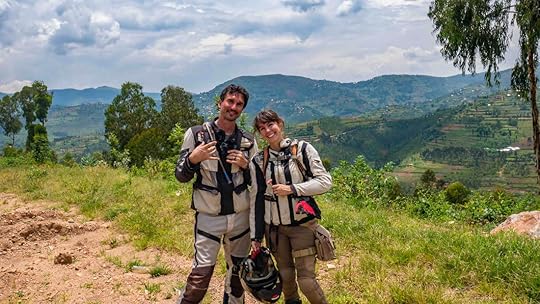 The pandemic has changed all of our lives, but for a couple who used to spend every day traveling, it has flipped our routine completely. Now we're 'stuck', we're sedentary, we don't go anywhere. Now our motorcycle mostly just sits in a garage collecting dust (ok, that's not entirely true since we do take it out on occasion, but it is usually in a sad state of disuse and the battery has died twice from just sitting there).
The pandemic has changed all of our lives, but for a couple who used to spend every day traveling, it has flipped our routine completely. Now we're 'stuck', we're sedentary, we don't go anywhere. Now our motorcycle mostly just sits in a garage collecting dust (ok, that's not entirely true since we do take it out on occasion, but it is usually in a sad state of disuse and the battery has died twice from just sitting there).
But we've been very fortunate. Because if the pandemic had happened while we were on any other continent, I'm not sure we would have been able to financially survive so long while living so well. Also, many regions around the world have closed their borders, tightened their visa policies, but not Africa. Here the people are forgiving and understanding. They've opened their borders to all those who test negative. They've allowed us to stay, and have welcomed us into their home with open arms. And for that we are forever thankful.
We're not the same people we were a year ago, but in some ways, we're even better. And we understand each other better. While traveling together, Tim and I have always been close, but now that I've been cut off from most other social interactions, I appreciate Tim more than ever. He's been my steady rock, the person who I can always turn to with my problems, the person who makes me laugh everyday. He's been right there with me through the thick and thin, and I wouldn't have ever made it this far without him.
I love you Tim!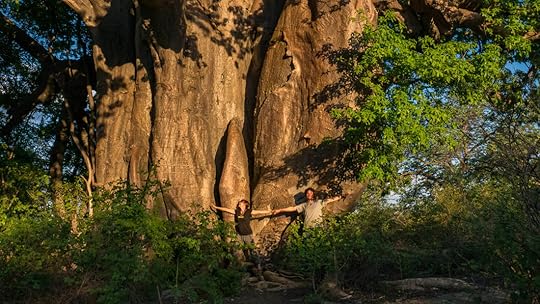 Happy Valentine's Day to everyone! Subscribe to Our Blog
Happy Valentine's Day to everyone! Subscribe to Our Blog
If you missed last week's post on A Day in the Life in Kenya, you can check it out here. We leave you with some flowers from our garden. See you next week!
We leave you with some flowers from our garden. See you next week!
 Since today is Valentine's day, I've decided to focus on my favorite emotion - love. And because we're here in Africa, I'd like to talk about some things that I love about this continent.
Since today is Valentine's day, I've decided to focus on my favorite emotion - love. And because we're here in Africa, I'd like to talk about some things that I love about this continent.All too often, Africa gets a lot of negative press. You hear about wars and corruption and poverty, but you rarely ever hear about the incredible things that Africa has to offer, and what make this continent magnificent.
The following are my top 5 things that I love about Africa. # 1 - Africans Always Find a Way to Smile
 Being the world's poorest continent, Africans are no strangers to hardship. And yet, they seem to always find a way to stay positive, make the best of it, and smile.
Being the world's poorest continent, Africans are no strangers to hardship. And yet, they seem to always find a way to stay positive, make the best of it, and smile.Some of this optimism may come from their tight-knit families and close communities. Oftentimes, several generations will live in a single house. And they don't seem to get annoyed with each other, but instead, they always have a joke ready for whatever life may throw at them.
 The proof of this is in their music. You never hear a sad sub-Saharan African song. They may sing about their struggles or their worries, but the song itself is always upbeat, in a major key, and will make you want to dance. The music of Africa brings people together, and everyone's always ready to bust out their dance moves, never ashamed of what people might think of them. Just letting the melodies and rhythms of the music flow through them.
The proof of this is in their music. You never hear a sad sub-Saharan African song. They may sing about their struggles or their worries, but the song itself is always upbeat, in a major key, and will make you want to dance. The music of Africa brings people together, and everyone's always ready to bust out their dance moves, never ashamed of what people might think of them. Just letting the melodies and rhythms of the music flow through them.It's certainly inspiring. # 2 - Africans Are Resourceful
 You never hear someone in Africa say, "It can't be done". Whenever they see a problem, they don't think, "Oh, why me?!" but instead see it as a challenge to overcome. And they may not have the right tool, or the right part, but they always seem to be able to figure it out with what they do have.
You never hear someone in Africa say, "It can't be done". Whenever they see a problem, they don't think, "Oh, why me?!" but instead see it as a challenge to overcome. And they may not have the right tool, or the right part, but they always seem to be able to figure it out with what they do have.Case in point, we've broken down quite a few times while riding our motorcycle in Africa, and every time people seem to just come out of the woodwork and want to help. And they never dwell on the disaster in front of them, but just get right to work with coming up with solutions. When our radiator blew in South Africa, or the electrical system short-circuited in Tanzania, or even when our monoshock broke in Namibia, somebody with a great attitude was always there to help.
Now this is not to say that once it's fixed, the final product is of any quality. In fact, most things here are built on a foundation of string and duct tape (and the cheap Chinese version at that). But in the end it will work. Our friend Braden had a problem with the starter on his bike, and so some guy with a jig saw cut the part to pieces, which worked. But from then on the only way for Braden to start his bike was with a screw driver instead of a key. Still, it got him across the continent! # 3 - Africa is Vibrant
 Africa is a youthful, colorful land full of energy, passion, and sunshine. The parrots in the trees are as vivid as the fruits of the market stalls. The patterns of the kitenge cloths the women wear dazzle. The foods are bursting with flavor, and the smells of the spices prick at your nose.
Africa is a youthful, colorful land full of energy, passion, and sunshine. The parrots in the trees are as vivid as the fruits of the market stalls. The patterns of the kitenge cloths the women wear dazzle. The foods are bursting with flavor, and the smells of the spices prick at your nose.It's hard to be sad here. Every morning you hear people sweeping their yards and sidewalks, humming and singing as if they're happy to bring on the new day. The church bells chime, the call to prayer fills the streets, and the children are everywhere, laughing and playing.
 This year has been hard on us all. And there was a time early on in the pandemic where I felt depressed about the state of the world. The dismal news, the constant checking of case numbers, it all upset me to my core. But I credit this incredible place for bringing me out of that funk. Because Africans know better than anyone that no matter what happens, life goes on. The children will play, the birds will sing, and that music and dancing will never end. # 4 - Africa is an Adventure
This year has been hard on us all. And there was a time early on in the pandemic where I felt depressed about the state of the world. The dismal news, the constant checking of case numbers, it all upset me to my core. But I credit this incredible place for bringing me out of that funk. Because Africans know better than anyone that no matter what happens, life goes on. The children will play, the birds will sing, and that music and dancing will never end. # 4 - Africa is an Adventure  Tim and I are adventure motorcyclists who ride an adventure bike. And it's true that you can have an amazing journey just about anywhere, but you don't have to look too far for an exciting or unusual experience in Africa. It comes to you.
Tim and I are adventure motorcyclists who ride an adventure bike. And it's true that you can have an amazing journey just about anywhere, but you don't have to look too far for an exciting or unusual experience in Africa. It comes to you."Don't go to the water's edge, there could be hippos or crocodiles," people tell us. Or, "Don't wear bright colors. A tsetse fly might bite you and you'll get the sleeping sickness." Or how about, "Don't drive at night, because it's amazing how well an elephant can blend into the darkness."
It just feels like Africa has upped the stakes with everything, and I love it.
 Not to mention, there are few places on earth with lands that are as untamed as Africa's. In fact, when it comes to wild animals, you can't get better than the height of the giraffe, the size of the elephant, the prehistoric look of the rhino, or the sheer numbers of migrating wildebeest and zebra. And these animals could be anywhere. You just never know what you'll find around the next curve in the road. # 5 - Africa Has Brought Tim and I Closer Than Ever Before
Not to mention, there are few places on earth with lands that are as untamed as Africa's. In fact, when it comes to wild animals, you can't get better than the height of the giraffe, the size of the elephant, the prehistoric look of the rhino, or the sheer numbers of migrating wildebeest and zebra. And these animals could be anywhere. You just never know what you'll find around the next curve in the road. # 5 - Africa Has Brought Tim and I Closer Than Ever Before  The pandemic has changed all of our lives, but for a couple who used to spend every day traveling, it has flipped our routine completely. Now we're 'stuck', we're sedentary, we don't go anywhere. Now our motorcycle mostly just sits in a garage collecting dust (ok, that's not entirely true since we do take it out on occasion, but it is usually in a sad state of disuse and the battery has died twice from just sitting there).
The pandemic has changed all of our lives, but for a couple who used to spend every day traveling, it has flipped our routine completely. Now we're 'stuck', we're sedentary, we don't go anywhere. Now our motorcycle mostly just sits in a garage collecting dust (ok, that's not entirely true since we do take it out on occasion, but it is usually in a sad state of disuse and the battery has died twice from just sitting there).But we've been very fortunate. Because if the pandemic had happened while we were on any other continent, I'm not sure we would have been able to financially survive so long while living so well. Also, many regions around the world have closed their borders, tightened their visa policies, but not Africa. Here the people are forgiving and understanding. They've opened their borders to all those who test negative. They've allowed us to stay, and have welcomed us into their home with open arms. And for that we are forever thankful.
We're not the same people we were a year ago, but in some ways, we're even better. And we understand each other better. While traveling together, Tim and I have always been close, but now that I've been cut off from most other social interactions, I appreciate Tim more than ever. He's been my steady rock, the person who I can always turn to with my problems, the person who makes me laugh everyday. He's been right there with me through the thick and thin, and I wouldn't have ever made it this far without him.
I love you Tim!
 Happy Valentine's Day to everyone! Subscribe to Our Blog
Happy Valentine's Day to everyone! Subscribe to Our Blog If you missed last week's post on A Day in the Life in Kenya, you can check it out here.
 We leave you with some flowers from our garden. See you next week!
We leave you with some flowers from our garden. See you next week!
Published on February 13, 2021 20:59
February 6, 2021
A Day in the Life in Kenya
By Marisa Notier The Notier Notes Our Sunday Scoop 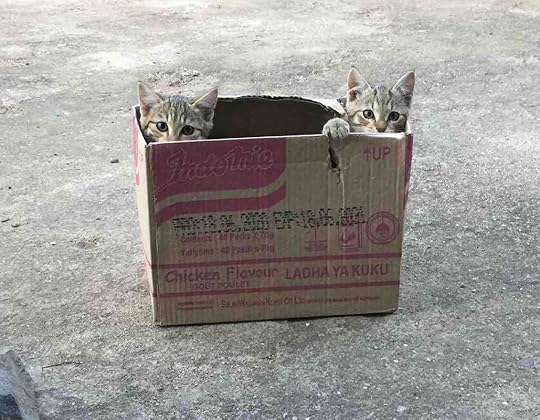 A lot of people wonder what our typical day looks like here in Kenya. In some ways, it's probably not so different from yours in that due to the pandemic, we're unable to travel much. So we mostly just stay at home watching Netflix. But even though we're not on the road, it's always an exotic adventure to be in Africa, and some of the stranger things of living in Kenya include a nightly barrage of nightmarish screecher-creatures, and the occasional UFO sighting.
A lot of people wonder what our typical day looks like here in Kenya. In some ways, it's probably not so different from yours in that due to the pandemic, we're unable to travel much. So we mostly just stay at home watching Netflix. But even though we're not on the road, it's always an exotic adventure to be in Africa, and some of the stranger things of living in Kenya include a nightly barrage of nightmarish screecher-creatures, and the occasional UFO sighting.
Don't worry, I'll explain.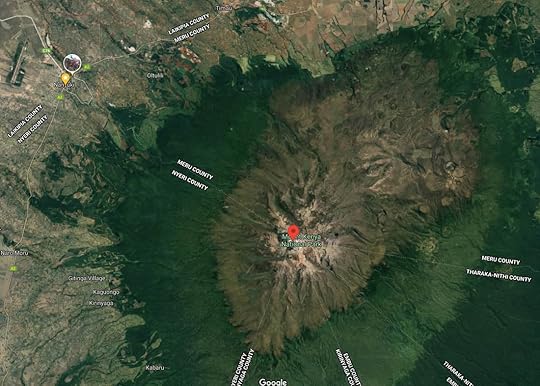 This satellite image shows Mount Kenya, and Nanyuki is in the upper left. We live in a town called Nanyuki which is right next to Kenya's largest mountain, and the place for which the entire country of Kenya is named - Mount Kenya. Similar to Mount Kilimanjaro in Tanzania, Mount Kenya is an old volcano. But unlike "Kili" which looks like a rounded loaf of bread, Mount Kenya is stunningly jagged on top. It has glaciers year round, and all the water in Nanyuki comes from this glacial runoff.
This satellite image shows Mount Kenya, and Nanyuki is in the upper left. We live in a town called Nanyuki which is right next to Kenya's largest mountain, and the place for which the entire country of Kenya is named - Mount Kenya. Similar to Mount Kilimanjaro in Tanzania, Mount Kenya is an old volcano. But unlike "Kili" which looks like a rounded loaf of bread, Mount Kenya is stunningly jagged on top. It has glaciers year round, and all the water in Nanyuki comes from this glacial runoff. 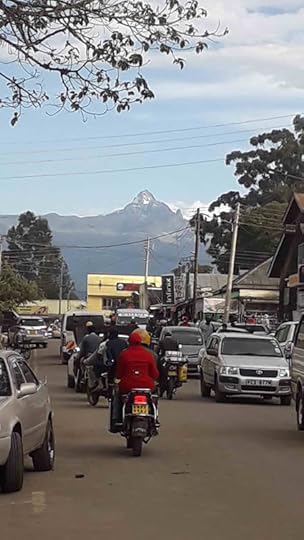 The view from Nanyuki. In normal times, Mount Kenya is a huge draw for tourists who want to hike up it (it's 17,000 feet high, over 5,000 meters). So the town of Nanyuki is (was) a tourist hot-spot. There are still a lot of foreigners who live here, and you can tell the town caters to foreigners just by walking down the street and seeing the amount of cafes, bakeries, huge Western-style super markets, safari agencies, and little stores selling hand-made crafts.
The view from Nanyuki. In normal times, Mount Kenya is a huge draw for tourists who want to hike up it (it's 17,000 feet high, over 5,000 meters). So the town of Nanyuki is (was) a tourist hot-spot. There are still a lot of foreigners who live here, and you can tell the town caters to foreigners just by walking down the street and seeing the amount of cafes, bakeries, huge Western-style super markets, safari agencies, and little stores selling hand-made crafts. 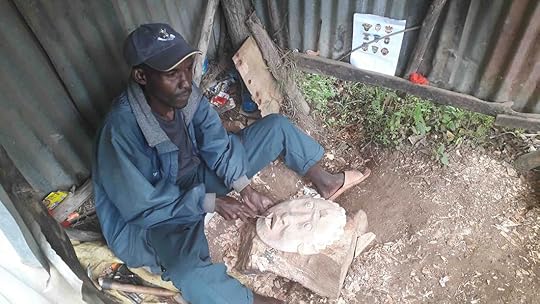 Even our next-door neighbor makes masks.
Even our next-door neighbor makes masks. 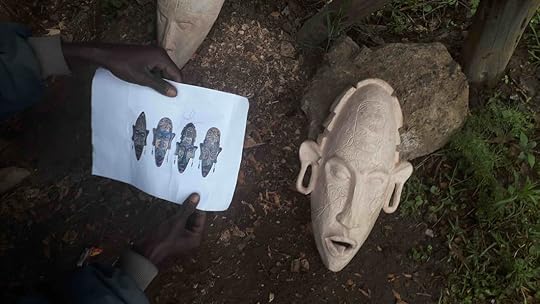 Our typical day in Nanyuki starts out just after dawn, which is always at the same time here on the equator. The equator line actually runs through Nanyuki, and it's so close to our house, for a while I wondered if it was possible to change hemispheres when walking from our kitchen to our living room.
Our typical day in Nanyuki starts out just after dawn, which is always at the same time here on the equator. The equator line actually runs through Nanyuki, and it's so close to our house, for a while I wondered if it was possible to change hemispheres when walking from our kitchen to our living room. 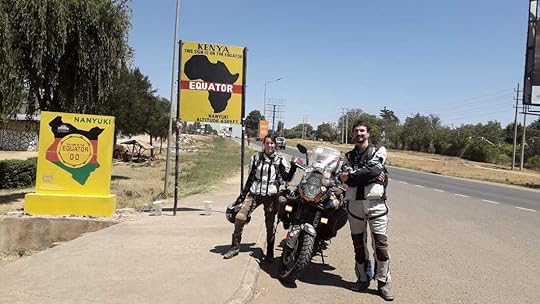 This is the nearest equator line right down the street from our house. In the mornings it's cold enough to wear jackets, sometimes we can even see our breath. This coldness is due to the high altitude of nearby Mount Kenya (we're at an elevation of 6,700 feet here / 2,000 meters).
This is the nearest equator line right down the street from our house. In the mornings it's cold enough to wear jackets, sometimes we can even see our breath. This coldness is due to the high altitude of nearby Mount Kenya (we're at an elevation of 6,700 feet here / 2,000 meters).
Every morning, we like to take our camping chairs and sit outside to have tea and coffee, and feed our cats - a mama cat and her two kittens. They're strays who live outside, but have befriended us. Since we're huge fans of cats, our new feline-buddies really solidified this place for us as a perfect home-away-from-home. And I believe there's no better way to start off the day than playing with cuddly kittens.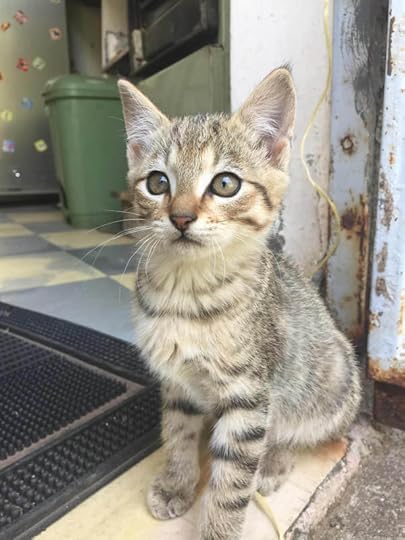
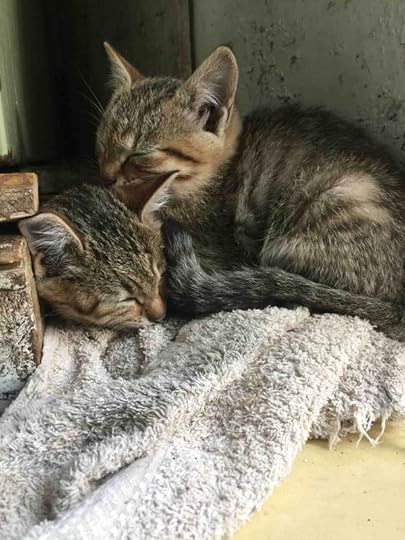 But one morning, things took a very strange turn. We were sitting outside having our tea and coffee when Tim saw something in the sky, like a bright, silvery disc-like saucer just hovering way way up there, higher than an airplane. Actually, there were two of them, and they were moving very slowly across the sky.
But one morning, things took a very strange turn. We were sitting outside having our tea and coffee when Tim saw something in the sky, like a bright, silvery disc-like saucer just hovering way way up there, higher than an airplane. Actually, there were two of them, and they were moving very slowly across the sky. 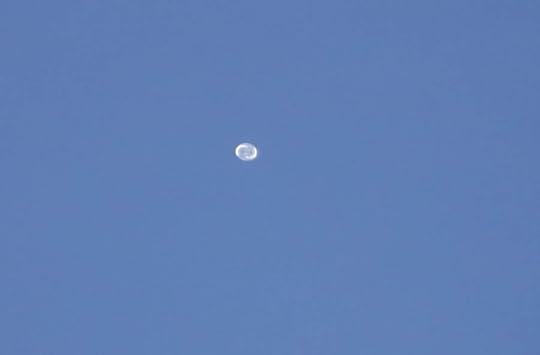 This is a zoomed-in picture we took of the thing in the sky. Weird, right? Tim and I are not huge believers in UFOs... but these were definitely UFOs as in they were 100% 'Unidentified Floating Objects'. They weren't zipping around the sky like flying saucers, but instead, they lazily bobbed around in the atmosphere like arial jellyfish. This wasn't the first time Tim questioned reality, but I had no real counter argument to disprove his otherworldly suspicions.
This is a zoomed-in picture we took of the thing in the sky. Weird, right? Tim and I are not huge believers in UFOs... but these were definitely UFOs as in they were 100% 'Unidentified Floating Objects'. They weren't zipping around the sky like flying saucers, but instead, they lazily bobbed around in the atmosphere like arial jellyfish. This wasn't the first time Tim questioned reality, but I had no real counter argument to disprove his otherworldly suspicions.
But finally, I heard about some Google internet balloons that were being tested in Kenya, and I realized I'd solved the mystery. These Google Loon Balloons are huge, the size of a tennis court. They're silver, and are flown at extremely high altitudes (sometimes as high as 17 miles up, twice that of commercial planes). So it's not aliens or spy drones, but it's still pretty fascinating. There's an article on them here.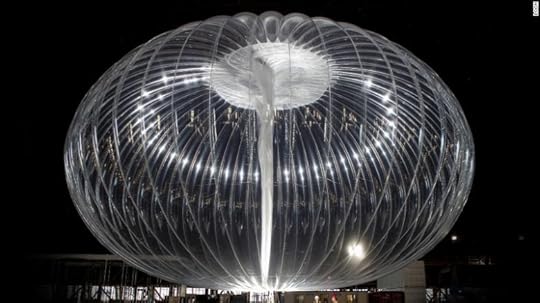 Photo from CNN. But I digress. Back to our typical day.
Photo from CNN. But I digress. Back to our typical day.
After coffee time and waving to the spying aliens in the sky, we work on our writing until lunch. Tim is finishing up his next book on our trip through South America (super exciting!), and I've been writing screenplays. We both just really enjoy writing and are trying our best to make it into a career for ourselves, and we've taken this downtime during the pandemic to focus on our writing dreams.
Since we live in a house with a kitchen, we usually cook our own food. When the electricity is on, we can use the electric oven (the electricity goes out a lot), so sometimes I can make awesome feasts, like roasted chicken for Thanksgiving and Christmas dinner. But most of the time, we are not nearly as elaborate with our meals, and end up eating ramen, or peanut butter and jelly sandwiches.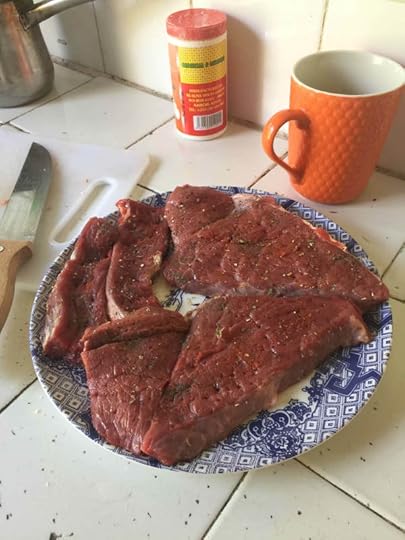 All this steak only costs about $2 here!
All this steak only costs about $2 here!  For more delicious recipes like this one, follow Tim on social media! After a bit more writing in the afternoons, we have a nice dinner together and watch some Netflix. And then, as night falls over Nanyuki, we turn on our security lights, lock ourselves into the house, crawl into bed with our mosquito net tucked around us, and wait for the freaky screecher-creatures to come out.
For more delicious recipes like this one, follow Tim on social media! After a bit more writing in the afternoons, we have a nice dinner together and watch some Netflix. And then, as night falls over Nanyuki, we turn on our security lights, lock ourselves into the house, crawl into bed with our mosquito net tucked around us, and wait for the freaky screecher-creatures to come out.
It gets eerily quiet here at night, until the screams start. They sound like banshees, or like a demon-possessed-griffin giving birth to a live, and very unhappy demon-possessed-griffin child. Actually, these blood-curdling screeches can be easily mistaken for a human cry, like a six-year-old being woken from a nightmare. And until you know what it is, it's extremely disturbing.
You'd think it would be a bird, like an ugly vulture, or maybe a poison-spitting lizard. But in fact, the perpetrator of this horror-show mating call is a cute little rodent called a Tree Hyrax. Tim refers to them as Dr, Seuss's 'Evil Lorax' as they speak from the trees, but instead of a rhyming environmental lesson, they emit a spine-chilling sound that will send your pulse racing. They look like a fat prairie dog, and you can find them across Africa in the more temperate regions.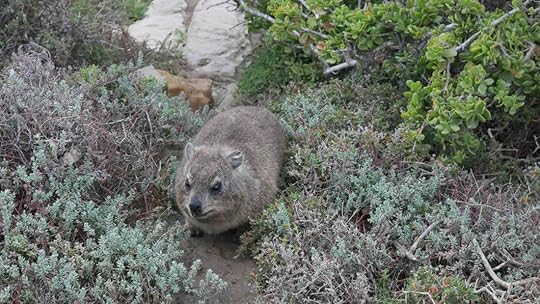 These little guys are distant cousins of elephants! And so every night, to the wailings of our worst nightmares, we finally get to sleep, dreaming about playing with kittens in the morning.
These little guys are distant cousins of elephants! And so every night, to the wailings of our worst nightmares, we finally get to sleep, dreaming about playing with kittens in the morning.
Next week, I'll talk about safety and security issues here in Africa. Until then, I hope you have a great week! Tim received a pretty exciting email when we woke up this morning! His book '2Up and Overloaded' just got a five-star review from AdvMoto magazine! What a huge honor!
A five-star review that speaks to the entertainment value of Tim's writing, which is descriptive and humorous, bringing the reader along eagerly on the couple’s motorcycle journey from Chicago to Colombia. - ADVMoto Magazine
We would love to hear what you thought if you have read Tim's books! Please do leave a review here: Amazon Reviews.
Thank you so much for the support!
Subscribe to Our Blog
 A lot of people wonder what our typical day looks like here in Kenya. In some ways, it's probably not so different from yours in that due to the pandemic, we're unable to travel much. So we mostly just stay at home watching Netflix. But even though we're not on the road, it's always an exotic adventure to be in Africa, and some of the stranger things of living in Kenya include a nightly barrage of nightmarish screecher-creatures, and the occasional UFO sighting.
A lot of people wonder what our typical day looks like here in Kenya. In some ways, it's probably not so different from yours in that due to the pandemic, we're unable to travel much. So we mostly just stay at home watching Netflix. But even though we're not on the road, it's always an exotic adventure to be in Africa, and some of the stranger things of living in Kenya include a nightly barrage of nightmarish screecher-creatures, and the occasional UFO sighting.Don't worry, I'll explain.
 This satellite image shows Mount Kenya, and Nanyuki is in the upper left. We live in a town called Nanyuki which is right next to Kenya's largest mountain, and the place for which the entire country of Kenya is named - Mount Kenya. Similar to Mount Kilimanjaro in Tanzania, Mount Kenya is an old volcano. But unlike "Kili" which looks like a rounded loaf of bread, Mount Kenya is stunningly jagged on top. It has glaciers year round, and all the water in Nanyuki comes from this glacial runoff.
This satellite image shows Mount Kenya, and Nanyuki is in the upper left. We live in a town called Nanyuki which is right next to Kenya's largest mountain, and the place for which the entire country of Kenya is named - Mount Kenya. Similar to Mount Kilimanjaro in Tanzania, Mount Kenya is an old volcano. But unlike "Kili" which looks like a rounded loaf of bread, Mount Kenya is stunningly jagged on top. It has glaciers year round, and all the water in Nanyuki comes from this glacial runoff.  The view from Nanyuki. In normal times, Mount Kenya is a huge draw for tourists who want to hike up it (it's 17,000 feet high, over 5,000 meters). So the town of Nanyuki is (was) a tourist hot-spot. There are still a lot of foreigners who live here, and you can tell the town caters to foreigners just by walking down the street and seeing the amount of cafes, bakeries, huge Western-style super markets, safari agencies, and little stores selling hand-made crafts.
The view from Nanyuki. In normal times, Mount Kenya is a huge draw for tourists who want to hike up it (it's 17,000 feet high, over 5,000 meters). So the town of Nanyuki is (was) a tourist hot-spot. There are still a lot of foreigners who live here, and you can tell the town caters to foreigners just by walking down the street and seeing the amount of cafes, bakeries, huge Western-style super markets, safari agencies, and little stores selling hand-made crafts.  Even our next-door neighbor makes masks.
Even our next-door neighbor makes masks.  Our typical day in Nanyuki starts out just after dawn, which is always at the same time here on the equator. The equator line actually runs through Nanyuki, and it's so close to our house, for a while I wondered if it was possible to change hemispheres when walking from our kitchen to our living room.
Our typical day in Nanyuki starts out just after dawn, which is always at the same time here on the equator. The equator line actually runs through Nanyuki, and it's so close to our house, for a while I wondered if it was possible to change hemispheres when walking from our kitchen to our living room.  This is the nearest equator line right down the street from our house. In the mornings it's cold enough to wear jackets, sometimes we can even see our breath. This coldness is due to the high altitude of nearby Mount Kenya (we're at an elevation of 6,700 feet here / 2,000 meters).
This is the nearest equator line right down the street from our house. In the mornings it's cold enough to wear jackets, sometimes we can even see our breath. This coldness is due to the high altitude of nearby Mount Kenya (we're at an elevation of 6,700 feet here / 2,000 meters).Every morning, we like to take our camping chairs and sit outside to have tea and coffee, and feed our cats - a mama cat and her two kittens. They're strays who live outside, but have befriended us. Since we're huge fans of cats, our new feline-buddies really solidified this place for us as a perfect home-away-from-home. And I believe there's no better way to start off the day than playing with cuddly kittens.

 But one morning, things took a very strange turn. We were sitting outside having our tea and coffee when Tim saw something in the sky, like a bright, silvery disc-like saucer just hovering way way up there, higher than an airplane. Actually, there were two of them, and they were moving very slowly across the sky.
But one morning, things took a very strange turn. We were sitting outside having our tea and coffee when Tim saw something in the sky, like a bright, silvery disc-like saucer just hovering way way up there, higher than an airplane. Actually, there were two of them, and they were moving very slowly across the sky.  This is a zoomed-in picture we took of the thing in the sky. Weird, right? Tim and I are not huge believers in UFOs... but these were definitely UFOs as in they were 100% 'Unidentified Floating Objects'. They weren't zipping around the sky like flying saucers, but instead, they lazily bobbed around in the atmosphere like arial jellyfish. This wasn't the first time Tim questioned reality, but I had no real counter argument to disprove his otherworldly suspicions.
This is a zoomed-in picture we took of the thing in the sky. Weird, right? Tim and I are not huge believers in UFOs... but these were definitely UFOs as in they were 100% 'Unidentified Floating Objects'. They weren't zipping around the sky like flying saucers, but instead, they lazily bobbed around in the atmosphere like arial jellyfish. This wasn't the first time Tim questioned reality, but I had no real counter argument to disprove his otherworldly suspicions.But finally, I heard about some Google internet balloons that were being tested in Kenya, and I realized I'd solved the mystery. These Google Loon Balloons are huge, the size of a tennis court. They're silver, and are flown at extremely high altitudes (sometimes as high as 17 miles up, twice that of commercial planes). So it's not aliens or spy drones, but it's still pretty fascinating. There's an article on them here.
 Photo from CNN. But I digress. Back to our typical day.
Photo from CNN. But I digress. Back to our typical day.After coffee time and waving to the spying aliens in the sky, we work on our writing until lunch. Tim is finishing up his next book on our trip through South America (super exciting!), and I've been writing screenplays. We both just really enjoy writing and are trying our best to make it into a career for ourselves, and we've taken this downtime during the pandemic to focus on our writing dreams.
Since we live in a house with a kitchen, we usually cook our own food. When the electricity is on, we can use the electric oven (the electricity goes out a lot), so sometimes I can make awesome feasts, like roasted chicken for Thanksgiving and Christmas dinner. But most of the time, we are not nearly as elaborate with our meals, and end up eating ramen, or peanut butter and jelly sandwiches.
 All this steak only costs about $2 here!
All this steak only costs about $2 here!  For more delicious recipes like this one, follow Tim on social media! After a bit more writing in the afternoons, we have a nice dinner together and watch some Netflix. And then, as night falls over Nanyuki, we turn on our security lights, lock ourselves into the house, crawl into bed with our mosquito net tucked around us, and wait for the freaky screecher-creatures to come out.
For more delicious recipes like this one, follow Tim on social media! After a bit more writing in the afternoons, we have a nice dinner together and watch some Netflix. And then, as night falls over Nanyuki, we turn on our security lights, lock ourselves into the house, crawl into bed with our mosquito net tucked around us, and wait for the freaky screecher-creatures to come out.It gets eerily quiet here at night, until the screams start. They sound like banshees, or like a demon-possessed-griffin giving birth to a live, and very unhappy demon-possessed-griffin child. Actually, these blood-curdling screeches can be easily mistaken for a human cry, like a six-year-old being woken from a nightmare. And until you know what it is, it's extremely disturbing.
You'd think it would be a bird, like an ugly vulture, or maybe a poison-spitting lizard. But in fact, the perpetrator of this horror-show mating call is a cute little rodent called a Tree Hyrax. Tim refers to them as Dr, Seuss's 'Evil Lorax' as they speak from the trees, but instead of a rhyming environmental lesson, they emit a spine-chilling sound that will send your pulse racing. They look like a fat prairie dog, and you can find them across Africa in the more temperate regions.
 These little guys are distant cousins of elephants! And so every night, to the wailings of our worst nightmares, we finally get to sleep, dreaming about playing with kittens in the morning.
These little guys are distant cousins of elephants! And so every night, to the wailings of our worst nightmares, we finally get to sleep, dreaming about playing with kittens in the morning.Next week, I'll talk about safety and security issues here in Africa. Until then, I hope you have a great week! Tim received a pretty exciting email when we woke up this morning! His book '2Up and Overloaded' just got a five-star review from AdvMoto magazine! What a huge honor!
A five-star review that speaks to the entertainment value of Tim's writing, which is descriptive and humorous, bringing the reader along eagerly on the couple’s motorcycle journey from Chicago to Colombia. - ADVMoto Magazine
We would love to hear what you thought if you have read Tim's books! Please do leave a review here: Amazon Reviews.
Thank you so much for the support!
Subscribe to Our Blog
Published on February 06, 2021 21:02
January 30, 2021
Adventures in African Food
By Marisa Notier The Notier Notes Our Sunday Scoop 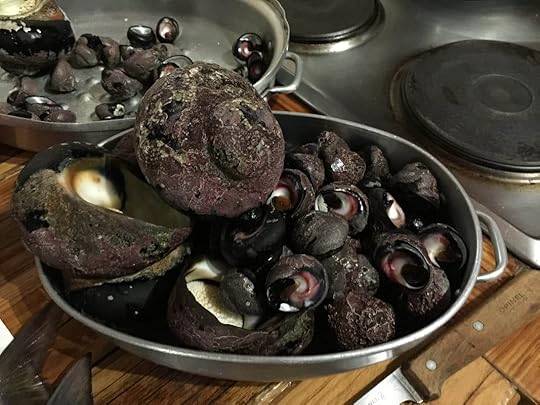 Snails anyone? These are South African periwinkles, and apparently they get to be HUGE! Before coming to Africa, I realized I had no idea what a typical African dish was. Everyone knows Chinese food, Mexican food, Italian food, and Indian food, but what in the world was African food? And why was it that we didn't have an African restaurant on every other block in America like we do with so many other types of cuisine?
Snails anyone? These are South African periwinkles, and apparently they get to be HUGE! Before coming to Africa, I realized I had no idea what a typical African dish was. Everyone knows Chinese food, Mexican food, Italian food, and Indian food, but what in the world was African food? And why was it that we didn't have an African restaurant on every other block in America like we do with so many other types of cuisine?
Well, I was about to find out that we really should have an African restaurant on every other block, because African cuisine is delicious.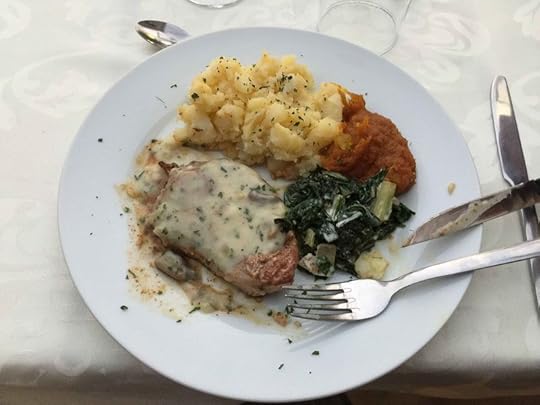 This is an eland steak with a side of garlic potatoes, cinnamon-spiced sweet potatoes, and cooked kale. We started off in South Africa, which has some of the most diverse food on the continent. This is probably due to its melting pot heritage of different cultures - you've got your German breads, your English meat pies, your Indian curries, and your hearty African stews of squash and greens.
This is an eland steak with a side of garlic potatoes, cinnamon-spiced sweet potatoes, and cooked kale. We started off in South Africa, which has some of the most diverse food on the continent. This is probably due to its melting pot heritage of different cultures - you've got your German breads, your English meat pies, your Indian curries, and your hearty African stews of squash and greens.
Average households in Africa usually reserve meat for special occasions, but perhaps because of the European influence on the country, South Africa has thrown that all out the window. Meat is their specialty. In fact, South Africa's greatest pastime is something called braai.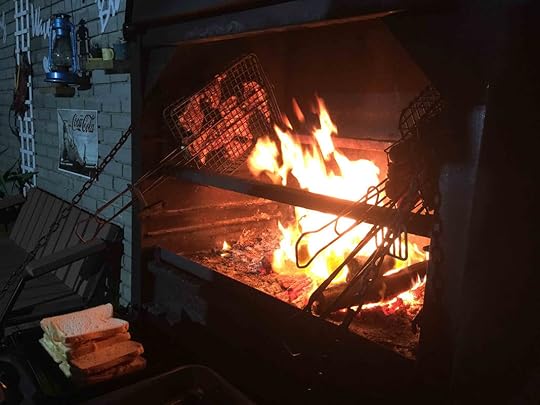 This is braai.
This is braai. 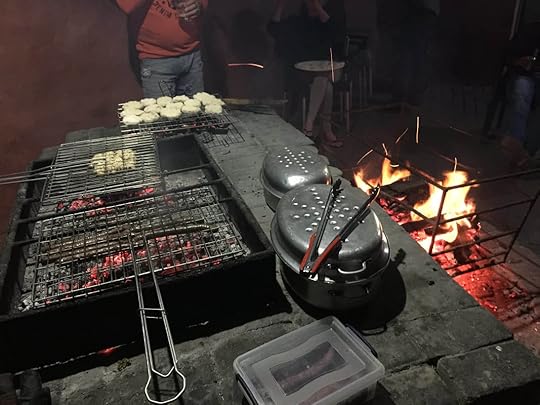 Braai can be an elaborate operation. Said like "fry", braai basically just means barbecue, and it's an integral part of South African life.
Braai can be an elaborate operation. Said like "fry", braai basically just means barbecue, and it's an integral part of South African life. 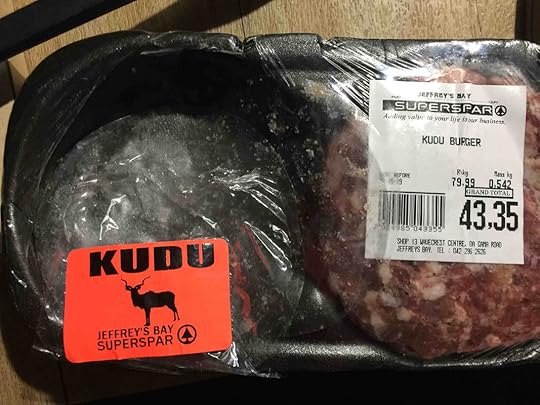 Don't forget to buy some kudu burgers from the local supermarket for your evening braai. Braai isn't just your typical barbecue of hotdogs and hamburgers. They cook up grilled cheese with tomato sandwiches (braaibroodjie), bread on a stick (stokbrood), and most importantly, boerewors (BOO-reh-vorsh) which is a coriander-spiced sausage in a spiral. Then there's all the game meats - different animals such as oryx, springbok, kudu, ostrich (oh that stuff is good!), and eland.
Don't forget to buy some kudu burgers from the local supermarket for your evening braai. Braai isn't just your typical barbecue of hotdogs and hamburgers. They cook up grilled cheese with tomato sandwiches (braaibroodjie), bread on a stick (stokbrood), and most importantly, boerewors (BOO-reh-vorsh) which is a coriander-spiced sausage in a spiral. Then there's all the game meats - different animals such as oryx, springbok, kudu, ostrich (oh that stuff is good!), and eland. 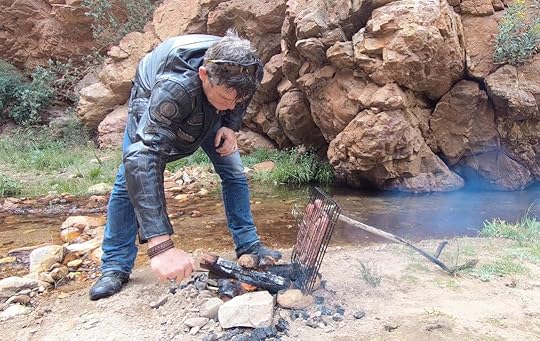 This is our friend Jacques cooking boerewors on a portable braai grill.
This is our friend Jacques cooking boerewors on a portable braai grill. 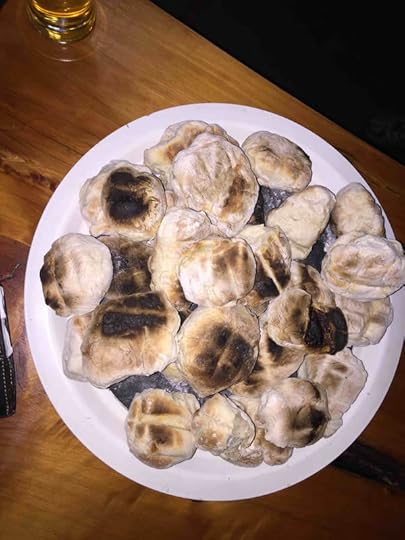 You don't just cook meat on a braai. Bread rolls baked over the flames is fantastic.
You don't just cook meat on a braai. Bread rolls baked over the flames is fantastic. 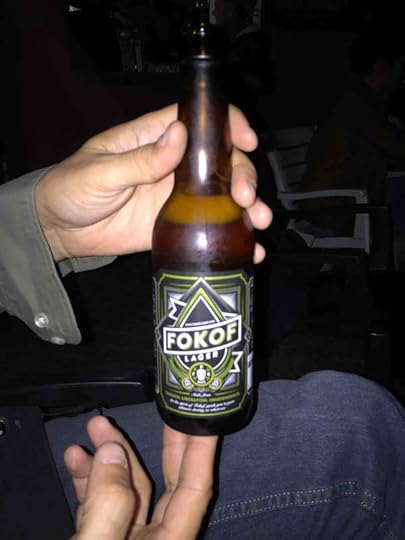 And it's always good to pair your braai with some well-named South African beer. And let's not forget all the meat jerkies you can buy throughout South Africa. Jerky is called biltong (BUL-tong) there, and you'll see entire biltong stalls at every mall and supermarket. That's where you can get your teriyaki jerky, chili jerky, fatty jerky, fresh jerky, or take home a döerwors (DROO-eh-vorsh) sausage which is like a Slim Jim with oryx meat.
And it's always good to pair your braai with some well-named South African beer. And let's not forget all the meat jerkies you can buy throughout South Africa. Jerky is called biltong (BUL-tong) there, and you'll see entire biltong stalls at every mall and supermarket. That's where you can get your teriyaki jerky, chili jerky, fatty jerky, fresh jerky, or take home a döerwors (DROO-eh-vorsh) sausage which is like a Slim Jim with oryx meat. 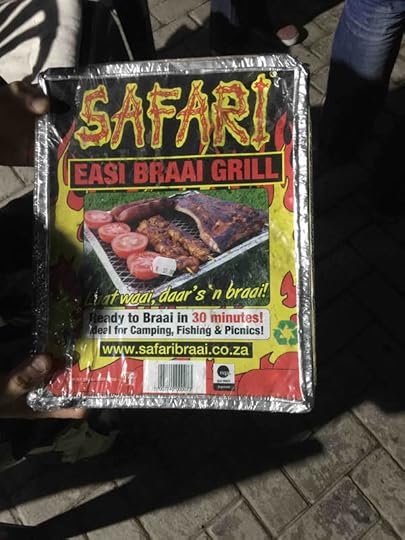 While on the road, you can just buy portable braai grills from any gas station, coals included.
While on the road, you can just buy portable braai grills from any gas station, coals included. 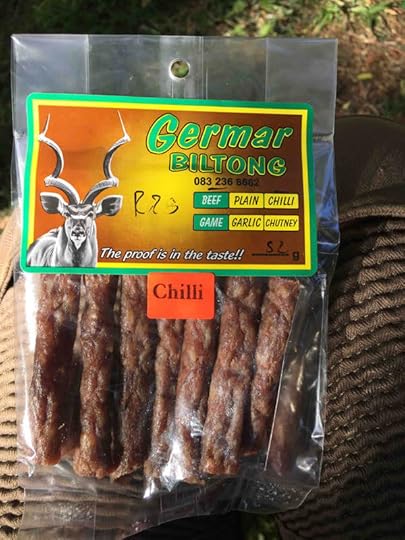 Snap into a biltong. Once outside of South Africa, you start to get less of a meat-obsessed presence, and more of a carb-obsessed one. There is a staple starch that can be found throughout the continent that is basically just mashed up corn cooked until it forms a hardened play-dough ball. It's like grits, but not so watery. It goes by many names - in South Africa it's pap, in Zimbabwe it's sadza, in Zambia it's nshima, in Tanzania and Kenya it's ugali, and in Uganda it's called posho. Yeah, it's been hard keeping it all straight.
Snap into a biltong. Once outside of South Africa, you start to get less of a meat-obsessed presence, and more of a carb-obsessed one. There is a staple starch that can be found throughout the continent that is basically just mashed up corn cooked until it forms a hardened play-dough ball. It's like grits, but not so watery. It goes by many names - in South Africa it's pap, in Zimbabwe it's sadza, in Zambia it's nshima, in Tanzania and Kenya it's ugali, and in Uganda it's called posho. Yeah, it's been hard keeping it all straight.
This pap is eaten with the hands along with a flavorful meat or vegetable sauce. Before corn was brought to Africa from the Americas, they made it out of African grains such as millet or sorghum. But once corn came along with all its sweetness, it became the favorite stuff of pap. You can see the pap in the plastic bags on the left. Africans love sweets and starches (who doesn't?). Their fruits are always mouth-watering, such as watermelons, guavas, mangoes, or passion fruit. And meals often come with starchy yams, squash, sweet potatoes, and cooked bananas.
You can see the pap in the plastic bags on the left. Africans love sweets and starches (who doesn't?). Their fruits are always mouth-watering, such as watermelons, guavas, mangoes, or passion fruit. And meals often come with starchy yams, squash, sweet potatoes, and cooked bananas.
While I was living in Uganda, our neighbor taught me how to make a traditional Ugandan dish called matoke. Basically, it's a banana smorgasbord of bananas (actually, plantains) wrapped in banana leaves, steamed over the fire for hours, and then mashed together. You can eat it with a side of bananas (just kidding, though that has probably happened).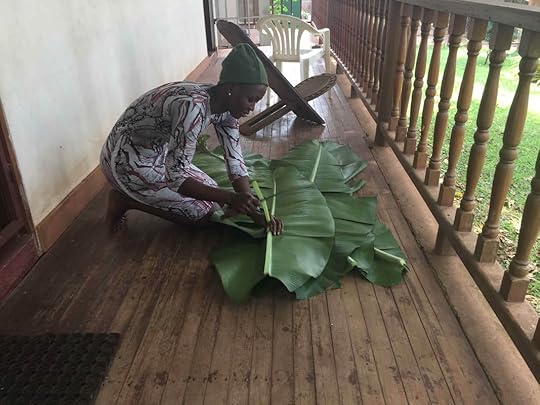 Here Irene is preparing the banana leaves for matoke.
Here Irene is preparing the banana leaves for matoke. 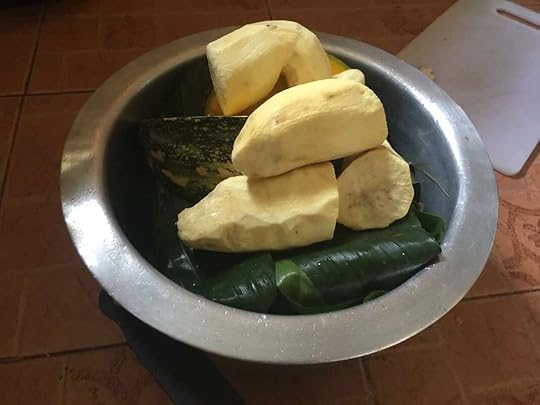 These are yams with squash. The matoke bananas are underneath. As you can imagine with their love for carbs, ever since potatoes have been brought over from the Americas, they've become all the rage in Africa. You'll find chipsi everywhere (fries), as well as Irish (boiled potatoes). And you can't go to Tanzania without coming across chipsi mayai which is scrambled eggs and fries. It sounds weird, but it's actually an ingenious combo.
These are yams with squash. The matoke bananas are underneath. As you can imagine with their love for carbs, ever since potatoes have been brought over from the Americas, they've become all the rage in Africa. You'll find chipsi everywhere (fries), as well as Irish (boiled potatoes). And you can't go to Tanzania without coming across chipsi mayai which is scrambled eggs and fries. It sounds weird, but it's actually an ingenious combo.
East Africa has been trading with India for centuries, long before Europeans ever did. And so spices play a large role in the cuisine. It's not necessarily spicy food, just flavorful food. India has also brought chapati over to East Africa, which is a flat bread like a tortilla, and you can find someone cooking chapati on almost any street corner. Ask for a rolex in Uganda and you'll get a scrambled egg chapati wrap, which is delish. Why it's called a rolex, I have no idea.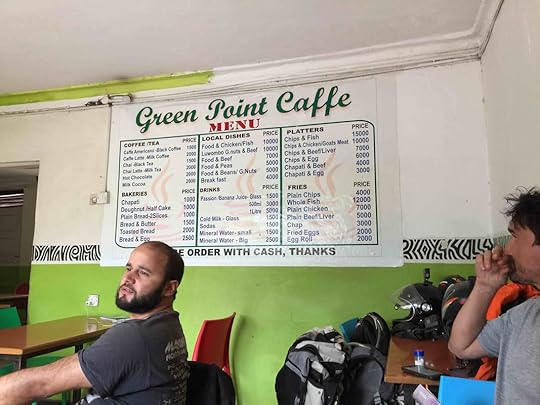 Hmm... yes, I would like to order the "Food & Beef" please. And finally, what you've all been waiting for - the weird stuff.
Hmm... yes, I would like to order the "Food & Beef" please. And finally, what you've all been waiting for - the weird stuff.
If you've been following our travels for a while, you might have noticed that I like to eat the strangest things I can find. You might remember me eating guinea pig in Peru, and maggot grubs in Ecuador. Well, Africa's got worms. But they're not actually worms, they're caterpillars, but are called worms on menus. That's right, worms on menus. You sometimes find menu items listed as chicken with worms, or green sauce with worms.
So what's it like to eat them? Well, like most insects marinated in a good sauce, they don't taste so bad. They can be a bit large, which is definitely intimidating, and the fact that you can see their little stubs for legs and colorful rippling bodies is also not very reassuring. But they taste decent. The texture is a bit chewy and you can feel the strange body parts crunching around in your mouth, but if you just remember that this is a locally-produced, environmentally-friendly, all-organic, and extremely-nutritious traditional cuisine, then it's not so bad.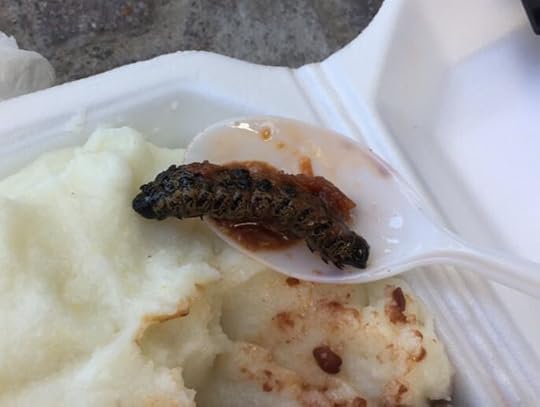
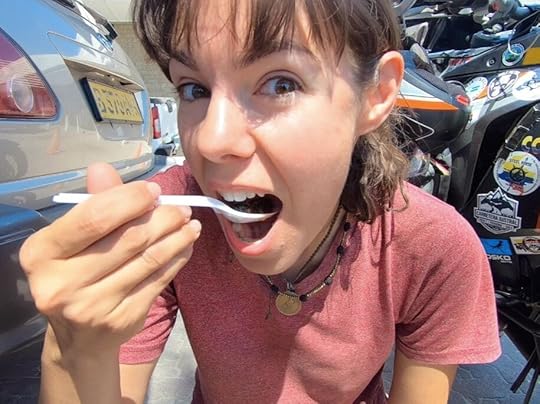 I hope everyone out there has a great week, and that if you ever find yourself near an African restaurant, you check it out (maybe minus the worms). Subscribe to Our Blog Next week, I'll go over a day in the life in Nanyuki. See you then!
I hope everyone out there has a great week, and that if you ever find yourself near an African restaurant, you check it out (maybe minus the worms). Subscribe to Our Blog Next week, I'll go over a day in the life in Nanyuki. See you then!
 Snails anyone? These are South African periwinkles, and apparently they get to be HUGE! Before coming to Africa, I realized I had no idea what a typical African dish was. Everyone knows Chinese food, Mexican food, Italian food, and Indian food, but what in the world was African food? And why was it that we didn't have an African restaurant on every other block in America like we do with so many other types of cuisine?
Snails anyone? These are South African periwinkles, and apparently they get to be HUGE! Before coming to Africa, I realized I had no idea what a typical African dish was. Everyone knows Chinese food, Mexican food, Italian food, and Indian food, but what in the world was African food? And why was it that we didn't have an African restaurant on every other block in America like we do with so many other types of cuisine?Well, I was about to find out that we really should have an African restaurant on every other block, because African cuisine is delicious.
 This is an eland steak with a side of garlic potatoes, cinnamon-spiced sweet potatoes, and cooked kale. We started off in South Africa, which has some of the most diverse food on the continent. This is probably due to its melting pot heritage of different cultures - you've got your German breads, your English meat pies, your Indian curries, and your hearty African stews of squash and greens.
This is an eland steak with a side of garlic potatoes, cinnamon-spiced sweet potatoes, and cooked kale. We started off in South Africa, which has some of the most diverse food on the continent. This is probably due to its melting pot heritage of different cultures - you've got your German breads, your English meat pies, your Indian curries, and your hearty African stews of squash and greens.Average households in Africa usually reserve meat for special occasions, but perhaps because of the European influence on the country, South Africa has thrown that all out the window. Meat is their specialty. In fact, South Africa's greatest pastime is something called braai.
 This is braai.
This is braai.  Braai can be an elaborate operation. Said like "fry", braai basically just means barbecue, and it's an integral part of South African life.
Braai can be an elaborate operation. Said like "fry", braai basically just means barbecue, and it's an integral part of South African life.  Don't forget to buy some kudu burgers from the local supermarket for your evening braai. Braai isn't just your typical barbecue of hotdogs and hamburgers. They cook up grilled cheese with tomato sandwiches (braaibroodjie), bread on a stick (stokbrood), and most importantly, boerewors (BOO-reh-vorsh) which is a coriander-spiced sausage in a spiral. Then there's all the game meats - different animals such as oryx, springbok, kudu, ostrich (oh that stuff is good!), and eland.
Don't forget to buy some kudu burgers from the local supermarket for your evening braai. Braai isn't just your typical barbecue of hotdogs and hamburgers. They cook up grilled cheese with tomato sandwiches (braaibroodjie), bread on a stick (stokbrood), and most importantly, boerewors (BOO-reh-vorsh) which is a coriander-spiced sausage in a spiral. Then there's all the game meats - different animals such as oryx, springbok, kudu, ostrich (oh that stuff is good!), and eland.  This is our friend Jacques cooking boerewors on a portable braai grill.
This is our friend Jacques cooking boerewors on a portable braai grill.  You don't just cook meat on a braai. Bread rolls baked over the flames is fantastic.
You don't just cook meat on a braai. Bread rolls baked over the flames is fantastic.  And it's always good to pair your braai with some well-named South African beer. And let's not forget all the meat jerkies you can buy throughout South Africa. Jerky is called biltong (BUL-tong) there, and you'll see entire biltong stalls at every mall and supermarket. That's where you can get your teriyaki jerky, chili jerky, fatty jerky, fresh jerky, or take home a döerwors (DROO-eh-vorsh) sausage which is like a Slim Jim with oryx meat.
And it's always good to pair your braai with some well-named South African beer. And let's not forget all the meat jerkies you can buy throughout South Africa. Jerky is called biltong (BUL-tong) there, and you'll see entire biltong stalls at every mall and supermarket. That's where you can get your teriyaki jerky, chili jerky, fatty jerky, fresh jerky, or take home a döerwors (DROO-eh-vorsh) sausage which is like a Slim Jim with oryx meat.  While on the road, you can just buy portable braai grills from any gas station, coals included.
While on the road, you can just buy portable braai grills from any gas station, coals included.  Snap into a biltong. Once outside of South Africa, you start to get less of a meat-obsessed presence, and more of a carb-obsessed one. There is a staple starch that can be found throughout the continent that is basically just mashed up corn cooked until it forms a hardened play-dough ball. It's like grits, but not so watery. It goes by many names - in South Africa it's pap, in Zimbabwe it's sadza, in Zambia it's nshima, in Tanzania and Kenya it's ugali, and in Uganda it's called posho. Yeah, it's been hard keeping it all straight.
Snap into a biltong. Once outside of South Africa, you start to get less of a meat-obsessed presence, and more of a carb-obsessed one. There is a staple starch that can be found throughout the continent that is basically just mashed up corn cooked until it forms a hardened play-dough ball. It's like grits, but not so watery. It goes by many names - in South Africa it's pap, in Zimbabwe it's sadza, in Zambia it's nshima, in Tanzania and Kenya it's ugali, and in Uganda it's called posho. Yeah, it's been hard keeping it all straight.This pap is eaten with the hands along with a flavorful meat or vegetable sauce. Before corn was brought to Africa from the Americas, they made it out of African grains such as millet or sorghum. But once corn came along with all its sweetness, it became the favorite stuff of pap.
 You can see the pap in the plastic bags on the left. Africans love sweets and starches (who doesn't?). Their fruits are always mouth-watering, such as watermelons, guavas, mangoes, or passion fruit. And meals often come with starchy yams, squash, sweet potatoes, and cooked bananas.
You can see the pap in the plastic bags on the left. Africans love sweets and starches (who doesn't?). Their fruits are always mouth-watering, such as watermelons, guavas, mangoes, or passion fruit. And meals often come with starchy yams, squash, sweet potatoes, and cooked bananas.While I was living in Uganda, our neighbor taught me how to make a traditional Ugandan dish called matoke. Basically, it's a banana smorgasbord of bananas (actually, plantains) wrapped in banana leaves, steamed over the fire for hours, and then mashed together. You can eat it with a side of bananas (just kidding, though that has probably happened).
 Here Irene is preparing the banana leaves for matoke.
Here Irene is preparing the banana leaves for matoke.  These are yams with squash. The matoke bananas are underneath. As you can imagine with their love for carbs, ever since potatoes have been brought over from the Americas, they've become all the rage in Africa. You'll find chipsi everywhere (fries), as well as Irish (boiled potatoes). And you can't go to Tanzania without coming across chipsi mayai which is scrambled eggs and fries. It sounds weird, but it's actually an ingenious combo.
These are yams with squash. The matoke bananas are underneath. As you can imagine with their love for carbs, ever since potatoes have been brought over from the Americas, they've become all the rage in Africa. You'll find chipsi everywhere (fries), as well as Irish (boiled potatoes). And you can't go to Tanzania without coming across chipsi mayai which is scrambled eggs and fries. It sounds weird, but it's actually an ingenious combo.East Africa has been trading with India for centuries, long before Europeans ever did. And so spices play a large role in the cuisine. It's not necessarily spicy food, just flavorful food. India has also brought chapati over to East Africa, which is a flat bread like a tortilla, and you can find someone cooking chapati on almost any street corner. Ask for a rolex in Uganda and you'll get a scrambled egg chapati wrap, which is delish. Why it's called a rolex, I have no idea.
 Hmm... yes, I would like to order the "Food & Beef" please. And finally, what you've all been waiting for - the weird stuff.
Hmm... yes, I would like to order the "Food & Beef" please. And finally, what you've all been waiting for - the weird stuff.If you've been following our travels for a while, you might have noticed that I like to eat the strangest things I can find. You might remember me eating guinea pig in Peru, and maggot grubs in Ecuador. Well, Africa's got worms. But they're not actually worms, they're caterpillars, but are called worms on menus. That's right, worms on menus. You sometimes find menu items listed as chicken with worms, or green sauce with worms.
So what's it like to eat them? Well, like most insects marinated in a good sauce, they don't taste so bad. They can be a bit large, which is definitely intimidating, and the fact that you can see their little stubs for legs and colorful rippling bodies is also not very reassuring. But they taste decent. The texture is a bit chewy and you can feel the strange body parts crunching around in your mouth, but if you just remember that this is a locally-produced, environmentally-friendly, all-organic, and extremely-nutritious traditional cuisine, then it's not so bad.

 I hope everyone out there has a great week, and that if you ever find yourself near an African restaurant, you check it out (maybe minus the worms). Subscribe to Our Blog Next week, I'll go over a day in the life in Nanyuki. See you then!
I hope everyone out there has a great week, and that if you ever find yourself near an African restaurant, you check it out (maybe minus the worms). Subscribe to Our Blog Next week, I'll go over a day in the life in Nanyuki. See you then!
Published on January 30, 2021 20:31
January 23, 2021
Our Journey to Nairobi
By Marisa Notier The Notier Notes Our Sunday Scoop 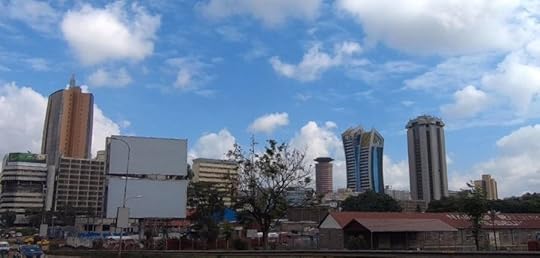 Unless a city has some particular draw for us, Tim and I try to avoid big metropolitan areas as much as we can. And since Nairobi is Kenya's capital city, and is known to be a congested industrial center famous for its slums and insane traffic, we were dead set on never going there.
Unless a city has some particular draw for us, Tim and I try to avoid big metropolitan areas as much as we can. And since Nairobi is Kenya's capital city, and is known to be a congested industrial center famous for its slums and insane traffic, we were dead set on never going there.
But we also had some questions about visa extensions that needed to be answered, and no one in the Kenyan immigration offices were picking up their phones or responding to emails. We've learned that this is typical for Africa, and the best way to get things done is to show up in person.
Also, Nairobi has the only KTM dealership between South Africa and Egypt, and our bike's back brakes were getting soft. Some fresh brake fluid would surely make our motorcycle very happy.
So last Sunday, we headed off to Nairobi for a three day trip.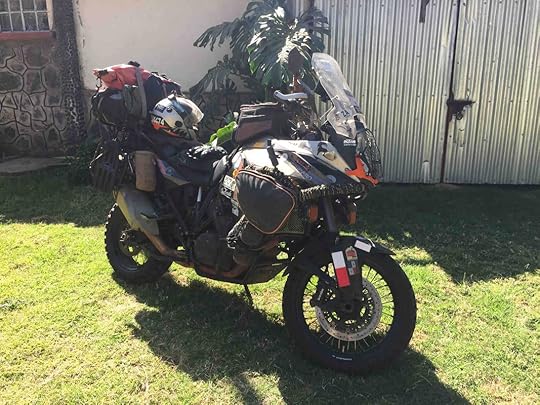 Because we didn't need any camping gear, we were able to pack light with just a back bag and a bunch of food. It felt very liberating to not have our panniers on the bike, and we could squeeze through traffic like never before. But I also realized that without our side bags, if the bike were to fall, my legs would be crushed. Kind of a scary thought. Personally, I prefer having the panniers on.
Because we didn't need any camping gear, we were able to pack light with just a back bag and a bunch of food. It felt very liberating to not have our panniers on the bike, and we could squeeze through traffic like never before. But I also realized that without our side bags, if the bike were to fall, my legs would be crushed. Kind of a scary thought. Personally, I prefer having the panniers on.
It was only a 3.5 hour ride from our home in Nanyuki to Nairobi, and we had beautiful weather and beautiful views of the countryside.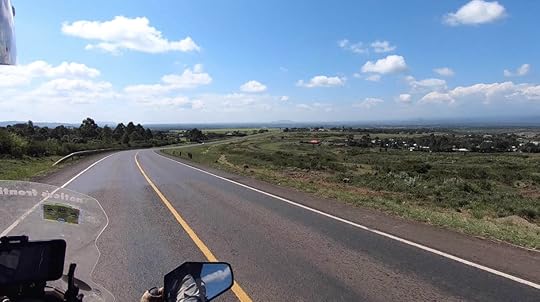 This is typical rural Kenya. To avoid traffic, we booked an Airbnb on the outskirts of town by the airport, and I really appreciated the fact that by using Airbnb, we were able to live amongst the locals. You got to hear the children playing, the dogs barking, the TVs blaring, and the music pumping. You could definitely smell the spices of the neighbor's cooking, or the perfumes of the laundry hung out to dry. This was the real Africa, and I loved it.
This is typical rural Kenya. To avoid traffic, we booked an Airbnb on the outskirts of town by the airport, and I really appreciated the fact that by using Airbnb, we were able to live amongst the locals. You got to hear the children playing, the dogs barking, the TVs blaring, and the music pumping. You could definitely smell the spices of the neighbor's cooking, or the perfumes of the laundry hung out to dry. This was the real Africa, and I loved it.
When we first pulled up, a friendly gentleman came outside another apartment building to help us find where we were going (there are no addresses here), saying his daughter wanted to see what these two lost white people were doing. He seemed to know all the neighbors' names, and pointed us in the right direction. I could tell that this was definitely a tight-knit, lively community here, which made the experience of being in Nairobi even that much better.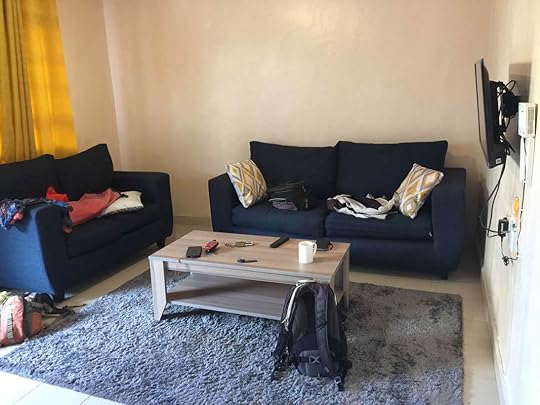 The apartment was clean and stylish.
The apartment was clean and stylish. 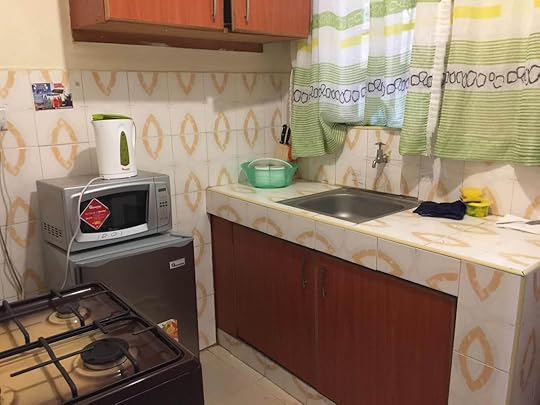 We even had a little kitchen. The next day, we rode the bike to KTM, then took an Uber into the city (you can even hire motorcycle taxis called boda bodas on the Uber app).
We even had a little kitchen. The next day, we rode the bike to KTM, then took an Uber into the city (you can even hire motorcycle taxis called boda bodas on the Uber app).
Downtown Nairobi is glitzy with high-rise glass buildings of modern architecture. The streets are filled with lots of fancy businesspeople strutting around briskly in suits or heels, like they're late for their next meeting. It felt like a sunny and colorfully-African version of Chicago.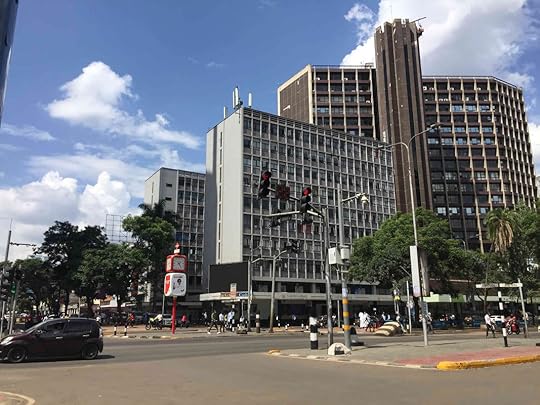 I remember once watching a documentary on poverty that said it's a shame that so many people around the world only think of Africa as a place where children look longingly at the camera with flies on their faces. They said that we are often missing this other side of Africa, one like downtown Nairobi, which is a bustling, beautiful city full of culture, innovation, entrepreneurialism, and modern-day luxuries.
I remember once watching a documentary on poverty that said it's a shame that so many people around the world only think of Africa as a place where children look longingly at the camera with flies on their faces. They said that we are often missing this other side of Africa, one like downtown Nairobi, which is a bustling, beautiful city full of culture, innovation, entrepreneurialism, and modern-day luxuries.
So as I stood there on the street corner, looking up at the skyscrapers glittering in the equatorial sun, I reminded myself to keep this picture of Africa in my head.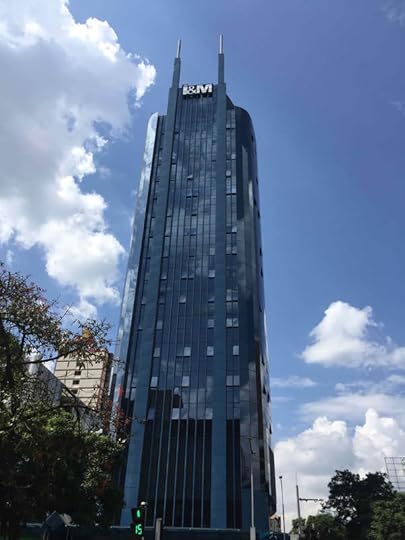 One of my favorite things about Nairobi were the buses. These public buses are famous for being brightly colored and painted with whatever designs the bus owner wants. This often includes portraits of rappers such as Tupac, Snoop Dogg, Post Malone, or Rihanna and Beyoncé. But sometimes you'll see other weird, random things.
One of my favorite things about Nairobi were the buses. These public buses are famous for being brightly colored and painted with whatever designs the bus owner wants. This often includes portraits of rappers such as Tupac, Snoop Dogg, Post Malone, or Rihanna and Beyoncé. But sometimes you'll see other weird, random things. 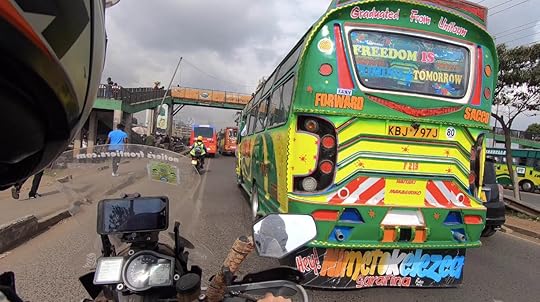 This bus's theme is "Freedom is Coming Tomorrow".
This bus's theme is "Freedom is Coming Tomorrow". 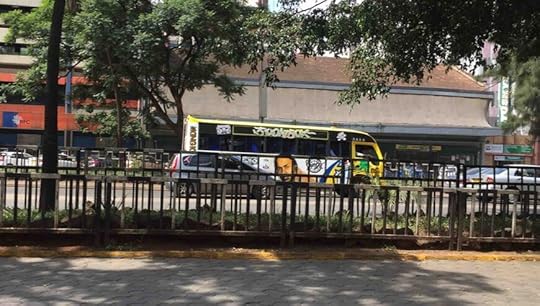 American hip hop seems to be very popular amongst Kenyan bus drivers. As far as Coronavirus went, Nairobi has strict mask-wearing rules in place, along with touch-free hand sanitizing stations and a mandatory temperature check at every door to every establishment. There's a nightly curfew in place, and restaurants have to be open to the elements, but that's easy to do here since the weather is so good.
American hip hop seems to be very popular amongst Kenyan bus drivers. As far as Coronavirus went, Nairobi has strict mask-wearing rules in place, along with touch-free hand sanitizing stations and a mandatory temperature check at every door to every establishment. There's a nightly curfew in place, and restaurants have to be open to the elements, but that's easy to do here since the weather is so good.  Tim snapped this pic of me at the immigration office. Look at all those papers!
Tim snapped this pic of me at the immigration office. Look at all those papers!  Tim and the owner of KTM Kenya. It was a tiring day in Nairobi. Like most bureaucracy, the immigration office took way longer than we'd wanted, but we got done what we needed. And the KTM dealership did a fine job on our fresh new brakes. But at long last, we were able to get back to our cozy Airbnb and shower off all that city grime.
Tim and the owner of KTM Kenya. It was a tiring day in Nairobi. Like most bureaucracy, the immigration office took way longer than we'd wanted, but we got done what we needed. And the KTM dealership did a fine job on our fresh new brakes. But at long last, we were able to get back to our cozy Airbnb and shower off all that city grime.
That evening, Tim and I were watching some TV when he went into the kitchen to grab the last of a bag of chips we'd opened earlier. He walked back into the living room with his hand in the bag when his face suddenly went white. He pulled his hand out, looked into the bag, then immediately started closing it up.
"What?" I asked.
"You don't want to know," he told me with total seriousness.
Of course, I insisted he tell me, and finally he confessed that inside the chip bag were two huge cockroaches, each about two inches long.
Yeah, he was right. I didn't want to know. All I could think of was thank God it wasn't me eating those chips.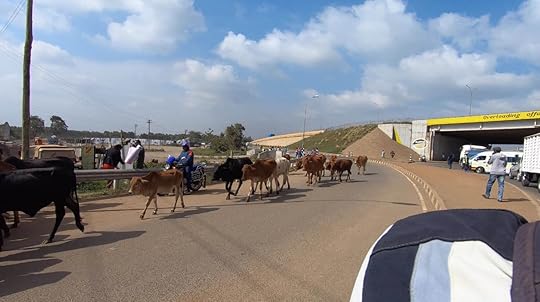 There was a bit of traffic on the highways leaving the city. Overall, our trip to Nairobi was a fun, interesting experience that I'm grateful for. Next week, I'll go over what African food is like.
There was a bit of traffic on the highways leaving the city. Overall, our trip to Nairobi was a fun, interesting experience that I'm grateful for. Next week, I'll go over what African food is like.
Until then, have a great week! Subscribe to Our Blog It has almost been a full year since Tim released '2Up and Overloaded'. If you've read it, it would be fantastic if you left a review on Amazon by clicking here! Tim is trying to get a hundred reviews in the first year, which would surely boost his confidence while writing the next segment!
I also want to give a big shout out to our fellow motorcycle traveling friends Travis and Chantil at viajarmoto.com (they're currently in Montenegro!), and my good friends Terri and Jacqueline back in the States.
 Unless a city has some particular draw for us, Tim and I try to avoid big metropolitan areas as much as we can. And since Nairobi is Kenya's capital city, and is known to be a congested industrial center famous for its slums and insane traffic, we were dead set on never going there.
Unless a city has some particular draw for us, Tim and I try to avoid big metropolitan areas as much as we can. And since Nairobi is Kenya's capital city, and is known to be a congested industrial center famous for its slums and insane traffic, we were dead set on never going there.But we also had some questions about visa extensions that needed to be answered, and no one in the Kenyan immigration offices were picking up their phones or responding to emails. We've learned that this is typical for Africa, and the best way to get things done is to show up in person.
Also, Nairobi has the only KTM dealership between South Africa and Egypt, and our bike's back brakes were getting soft. Some fresh brake fluid would surely make our motorcycle very happy.
So last Sunday, we headed off to Nairobi for a three day trip.
 Because we didn't need any camping gear, we were able to pack light with just a back bag and a bunch of food. It felt very liberating to not have our panniers on the bike, and we could squeeze through traffic like never before. But I also realized that without our side bags, if the bike were to fall, my legs would be crushed. Kind of a scary thought. Personally, I prefer having the panniers on.
Because we didn't need any camping gear, we were able to pack light with just a back bag and a bunch of food. It felt very liberating to not have our panniers on the bike, and we could squeeze through traffic like never before. But I also realized that without our side bags, if the bike were to fall, my legs would be crushed. Kind of a scary thought. Personally, I prefer having the panniers on.It was only a 3.5 hour ride from our home in Nanyuki to Nairobi, and we had beautiful weather and beautiful views of the countryside.
 This is typical rural Kenya. To avoid traffic, we booked an Airbnb on the outskirts of town by the airport, and I really appreciated the fact that by using Airbnb, we were able to live amongst the locals. You got to hear the children playing, the dogs barking, the TVs blaring, and the music pumping. You could definitely smell the spices of the neighbor's cooking, or the perfumes of the laundry hung out to dry. This was the real Africa, and I loved it.
This is typical rural Kenya. To avoid traffic, we booked an Airbnb on the outskirts of town by the airport, and I really appreciated the fact that by using Airbnb, we were able to live amongst the locals. You got to hear the children playing, the dogs barking, the TVs blaring, and the music pumping. You could definitely smell the spices of the neighbor's cooking, or the perfumes of the laundry hung out to dry. This was the real Africa, and I loved it.When we first pulled up, a friendly gentleman came outside another apartment building to help us find where we were going (there are no addresses here), saying his daughter wanted to see what these two lost white people were doing. He seemed to know all the neighbors' names, and pointed us in the right direction. I could tell that this was definitely a tight-knit, lively community here, which made the experience of being in Nairobi even that much better.
 The apartment was clean and stylish.
The apartment was clean and stylish.  We even had a little kitchen. The next day, we rode the bike to KTM, then took an Uber into the city (you can even hire motorcycle taxis called boda bodas on the Uber app).
We even had a little kitchen. The next day, we rode the bike to KTM, then took an Uber into the city (you can even hire motorcycle taxis called boda bodas on the Uber app).Downtown Nairobi is glitzy with high-rise glass buildings of modern architecture. The streets are filled with lots of fancy businesspeople strutting around briskly in suits or heels, like they're late for their next meeting. It felt like a sunny and colorfully-African version of Chicago.
 I remember once watching a documentary on poverty that said it's a shame that so many people around the world only think of Africa as a place where children look longingly at the camera with flies on their faces. They said that we are often missing this other side of Africa, one like downtown Nairobi, which is a bustling, beautiful city full of culture, innovation, entrepreneurialism, and modern-day luxuries.
I remember once watching a documentary on poverty that said it's a shame that so many people around the world only think of Africa as a place where children look longingly at the camera with flies on their faces. They said that we are often missing this other side of Africa, one like downtown Nairobi, which is a bustling, beautiful city full of culture, innovation, entrepreneurialism, and modern-day luxuries.So as I stood there on the street corner, looking up at the skyscrapers glittering in the equatorial sun, I reminded myself to keep this picture of Africa in my head.
 One of my favorite things about Nairobi were the buses. These public buses are famous for being brightly colored and painted with whatever designs the bus owner wants. This often includes portraits of rappers such as Tupac, Snoop Dogg, Post Malone, or Rihanna and Beyoncé. But sometimes you'll see other weird, random things.
One of my favorite things about Nairobi were the buses. These public buses are famous for being brightly colored and painted with whatever designs the bus owner wants. This often includes portraits of rappers such as Tupac, Snoop Dogg, Post Malone, or Rihanna and Beyoncé. But sometimes you'll see other weird, random things.  This bus's theme is "Freedom is Coming Tomorrow".
This bus's theme is "Freedom is Coming Tomorrow".  American hip hop seems to be very popular amongst Kenyan bus drivers. As far as Coronavirus went, Nairobi has strict mask-wearing rules in place, along with touch-free hand sanitizing stations and a mandatory temperature check at every door to every establishment. There's a nightly curfew in place, and restaurants have to be open to the elements, but that's easy to do here since the weather is so good.
American hip hop seems to be very popular amongst Kenyan bus drivers. As far as Coronavirus went, Nairobi has strict mask-wearing rules in place, along with touch-free hand sanitizing stations and a mandatory temperature check at every door to every establishment. There's a nightly curfew in place, and restaurants have to be open to the elements, but that's easy to do here since the weather is so good.  Tim snapped this pic of me at the immigration office. Look at all those papers!
Tim snapped this pic of me at the immigration office. Look at all those papers!  Tim and the owner of KTM Kenya. It was a tiring day in Nairobi. Like most bureaucracy, the immigration office took way longer than we'd wanted, but we got done what we needed. And the KTM dealership did a fine job on our fresh new brakes. But at long last, we were able to get back to our cozy Airbnb and shower off all that city grime.
Tim and the owner of KTM Kenya. It was a tiring day in Nairobi. Like most bureaucracy, the immigration office took way longer than we'd wanted, but we got done what we needed. And the KTM dealership did a fine job on our fresh new brakes. But at long last, we were able to get back to our cozy Airbnb and shower off all that city grime.That evening, Tim and I were watching some TV when he went into the kitchen to grab the last of a bag of chips we'd opened earlier. He walked back into the living room with his hand in the bag when his face suddenly went white. He pulled his hand out, looked into the bag, then immediately started closing it up.
"What?" I asked.
"You don't want to know," he told me with total seriousness.
Of course, I insisted he tell me, and finally he confessed that inside the chip bag were two huge cockroaches, each about two inches long.
Yeah, he was right. I didn't want to know. All I could think of was thank God it wasn't me eating those chips.
 There was a bit of traffic on the highways leaving the city. Overall, our trip to Nairobi was a fun, interesting experience that I'm grateful for. Next week, I'll go over what African food is like.
There was a bit of traffic on the highways leaving the city. Overall, our trip to Nairobi was a fun, interesting experience that I'm grateful for. Next week, I'll go over what African food is like.Until then, have a great week! Subscribe to Our Blog It has almost been a full year since Tim released '2Up and Overloaded'. If you've read it, it would be fantastic if you left a review on Amazon by clicking here! Tim is trying to get a hundred reviews in the first year, which would surely boost his confidence while writing the next segment!
I also want to give a big shout out to our fellow motorcycle traveling friends Travis and Chantil at viajarmoto.com (they're currently in Montenegro!), and my good friends Terri and Jacqueline back in the States.
Published on January 23, 2021 22:31
January 16, 2021
How Has Covid Affected Africa?
By Marisa Notier The Notier Notes Our Sunday Scoop  Me getting tested in Uganda. When the pandemic first hit back in March, we were in Uganda, and I was definitely freaking out. My first instinct was to go home to the US where the health care infrastructure is leaps and bounds what they have here, where the government can financially sustain a prolonged lockdown, and where most people can social distance.
Me getting tested in Uganda. When the pandemic first hit back in March, we were in Uganda, and I was definitely freaking out. My first instinct was to go home to the US where the health care infrastructure is leaps and bounds what they have here, where the government can financially sustain a prolonged lockdown, and where most people can social distance.
Uganda, on the other hand, is the complete opposite. Extended families often live cramped together in single-room dwellings, the vast majority of people can't work from home, and the health care system... well let me just put it this way - the entire country of Uganda had three ventilators. They've since received donations of many more, but the expectation was that once Covid-19 hit sub-Saharan Africa, this region was going to be a humanitarian catastrophe.
But strangely enough, that didn't happen. Source: Bing 1/16/21 For many reasons (which I outline in this post), we ended up staying in Africa, and I've been very thankful that we did. Because amazingly, the Coronavirus hasn't hit most of Africa as hard as everyone feared.
Source: Bing 1/16/21 For many reasons (which I outline in this post), we ended up staying in Africa, and I've been very thankful that we did. Because amazingly, the Coronavirus hasn't hit most of Africa as hard as everyone feared.
But why? It sort of defies logic, and there's not a day that goes by where I don't think about it.
It should be noted that most countries in Africa are not testing at the same capacity as other regions of the world. Some simply don't have the resources, and there are even reports of Corona deaths being labeled as malaria or other illnesses.
Tanzania, for example, claimed that they got rid of Coronavirus back in April and haven't reported a single case since. Of course, we know this isn't true, since Tanzanian truck drivers test positive at the Ugandan border all the time. But Tanzania is a country that has done absolutely nothing to combat the virus. No testing, no lockdown. Simply denial. It feels like we were just in neighboring Tanzania. But actually, this photo was taken a full year ago! But at the same time, you don't hear any stories of overwhelmed hospitals in Tanzania either. And from my own personal experience on the ground in Uganda and Kenya, I think the numbers that are reported here are fairly accurate (unlike Tanzania, they send out daily reports). Life goes on like normal (minus the lack of tourists), people wear masks, but nobody on the street we meet has ever known anyone who's gotten sick. Whereas when I talk to friends in the States, almost all of them know of someone who has died.
It feels like we were just in neighboring Tanzania. But actually, this photo was taken a full year ago! But at the same time, you don't hear any stories of overwhelmed hospitals in Tanzania either. And from my own personal experience on the ground in Uganda and Kenya, I think the numbers that are reported here are fairly accurate (unlike Tanzania, they send out daily reports). Life goes on like normal (minus the lack of tourists), people wear masks, but nobody on the street we meet has ever known anyone who's gotten sick. Whereas when I talk to friends in the States, almost all of them know of someone who has died.
So what is going on here? This is a typical view of our town of Nanyuki, Kenya with beautiful Mt. Kenya in the background. People do wear masks on the streets, but they carry on with life as normal. The truth is, no one knows the answer to this question. One day we might do enough studies to figure it out definitively, but until then, we can only speculate. The Obvious Answers Africa does have some advantages in tackling viral outbreaks since they've done it before (ebola, AIDS, malaria, dengue...). But also, many African countries had a head-start on the rest of the world and cracked down hard at the beginning of the pandemic, slowing the spread immediately.
This is a typical view of our town of Nanyuki, Kenya with beautiful Mt. Kenya in the background. People do wear masks on the streets, but they carry on with life as normal. The truth is, no one knows the answer to this question. One day we might do enough studies to figure it out definitively, but until then, we can only speculate. The Obvious Answers Africa does have some advantages in tackling viral outbreaks since they've done it before (ebola, AIDS, malaria, dengue...). But also, many African countries had a head-start on the rest of the world and cracked down hard at the beginning of the pandemic, slowing the spread immediately.
And demographics also play a part. Many people here are young and healthy, with few co-morbidities such as obesity or smoking. And the climate of the region, being near the equator with no winters, no flu season, lots of sunlight, and also a lifestyle that's predominantly outdoors, has really helped.
But this doesn't explain everything, because look at Brazil. They have similar demographics, living conditions, and climate, and they've been hit very hard. We live right on the equator now (we can walk there from our house). This picture was from our ride over here from Uganda, during which we crossed the equator four times in one day. The Less-Obvious Answers There is also a theory about people living in close-quarters together where lots of diseases spread easily, such as in shanty towns. Could it be that because these people are constantly exposed to other viruses, like the common cold, that they are more resistant to the Coronavirus?
We live right on the equator now (we can walk there from our house). This picture was from our ride over here from Uganda, during which we crossed the equator four times in one day. The Less-Obvious Answers There is also a theory about people living in close-quarters together where lots of diseases spread easily, such as in shanty towns. Could it be that because these people are constantly exposed to other viruses, like the common cold, that they are more resistant to the Coronavirus?
But again, Brazil has the same conditions, but have also had terrible outbreaks. There's got to be more to it.
Some people have noted that when you look at a map of Covid outbreaks, and a map of countries with malaria, it looks that places with lots of malaria also seem to have fared well against the Coronavirus. In sub-Saharan Africa, South Africa has had the most Covid outbreaks by far, and they're also the only country in the region without malaria.
We also know that because of the constant exposure to malaria here, Africans have a small resistance to it (they are not immune though). But maybe this resistance to a virus such as malaria has helped them to also resist a virus such as Covid-19?
But there is no proof of any of this yet.
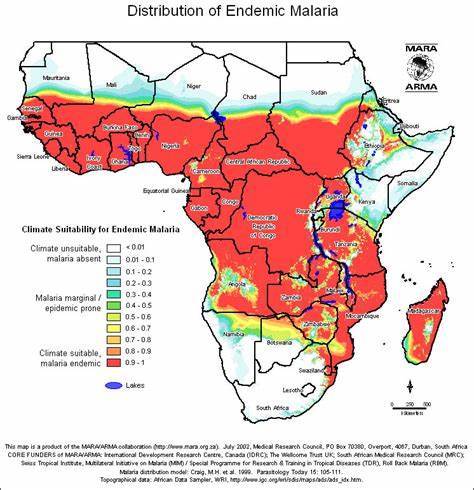 Most likely, the answer is a combination of these theories, and only time will tell what is right and wrong. But until then, I'm happy to be in a place that has so far avoided the worst of this pandemic.
Most likely, the answer is a combination of these theories, and only time will tell what is right and wrong. But until then, I'm happy to be in a place that has so far avoided the worst of this pandemic.
Today we're traveling to Nairobi to renew our visas, so next week I'll tell you about our adventures in the big city. Of course, just because Africa has done well with the virus, doesn't mean we're completely safe from it here. We will take every precaution we can on our journey. We'll let you know how it goes.
Be safe and have a great week!
And I leave you with a guaranteed smile - Marco, one of our twin kittens!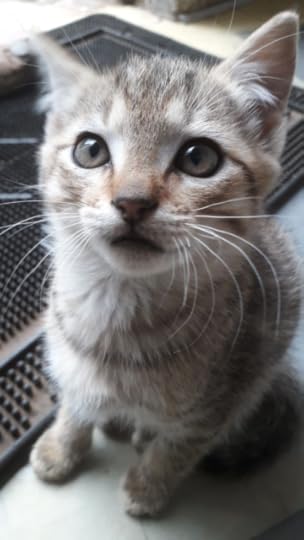 Subscribe to Our Blog
Subscribe to Our Blog
 Me getting tested in Uganda. When the pandemic first hit back in March, we were in Uganda, and I was definitely freaking out. My first instinct was to go home to the US where the health care infrastructure is leaps and bounds what they have here, where the government can financially sustain a prolonged lockdown, and where most people can social distance.
Me getting tested in Uganda. When the pandemic first hit back in March, we were in Uganda, and I was definitely freaking out. My first instinct was to go home to the US where the health care infrastructure is leaps and bounds what they have here, where the government can financially sustain a prolonged lockdown, and where most people can social distance.Uganda, on the other hand, is the complete opposite. Extended families often live cramped together in single-room dwellings, the vast majority of people can't work from home, and the health care system... well let me just put it this way - the entire country of Uganda had three ventilators. They've since received donations of many more, but the expectation was that once Covid-19 hit sub-Saharan Africa, this region was going to be a humanitarian catastrophe.
But strangely enough, that didn't happen.
 Source: Bing 1/16/21 For many reasons (which I outline in this post), we ended up staying in Africa, and I've been very thankful that we did. Because amazingly, the Coronavirus hasn't hit most of Africa as hard as everyone feared.
Source: Bing 1/16/21 For many reasons (which I outline in this post), we ended up staying in Africa, and I've been very thankful that we did. Because amazingly, the Coronavirus hasn't hit most of Africa as hard as everyone feared.But why? It sort of defies logic, and there's not a day that goes by where I don't think about it.
It should be noted that most countries in Africa are not testing at the same capacity as other regions of the world. Some simply don't have the resources, and there are even reports of Corona deaths being labeled as malaria or other illnesses.
Tanzania, for example, claimed that they got rid of Coronavirus back in April and haven't reported a single case since. Of course, we know this isn't true, since Tanzanian truck drivers test positive at the Ugandan border all the time. But Tanzania is a country that has done absolutely nothing to combat the virus. No testing, no lockdown. Simply denial.
 It feels like we were just in neighboring Tanzania. But actually, this photo was taken a full year ago! But at the same time, you don't hear any stories of overwhelmed hospitals in Tanzania either. And from my own personal experience on the ground in Uganda and Kenya, I think the numbers that are reported here are fairly accurate (unlike Tanzania, they send out daily reports). Life goes on like normal (minus the lack of tourists), people wear masks, but nobody on the street we meet has ever known anyone who's gotten sick. Whereas when I talk to friends in the States, almost all of them know of someone who has died.
It feels like we were just in neighboring Tanzania. But actually, this photo was taken a full year ago! But at the same time, you don't hear any stories of overwhelmed hospitals in Tanzania either. And from my own personal experience on the ground in Uganda and Kenya, I think the numbers that are reported here are fairly accurate (unlike Tanzania, they send out daily reports). Life goes on like normal (minus the lack of tourists), people wear masks, but nobody on the street we meet has ever known anyone who's gotten sick. Whereas when I talk to friends in the States, almost all of them know of someone who has died.So what is going on here?
 This is a typical view of our town of Nanyuki, Kenya with beautiful Mt. Kenya in the background. People do wear masks on the streets, but they carry on with life as normal. The truth is, no one knows the answer to this question. One day we might do enough studies to figure it out definitively, but until then, we can only speculate. The Obvious Answers Africa does have some advantages in tackling viral outbreaks since they've done it before (ebola, AIDS, malaria, dengue...). But also, many African countries had a head-start on the rest of the world and cracked down hard at the beginning of the pandemic, slowing the spread immediately.
This is a typical view of our town of Nanyuki, Kenya with beautiful Mt. Kenya in the background. People do wear masks on the streets, but they carry on with life as normal. The truth is, no one knows the answer to this question. One day we might do enough studies to figure it out definitively, but until then, we can only speculate. The Obvious Answers Africa does have some advantages in tackling viral outbreaks since they've done it before (ebola, AIDS, malaria, dengue...). But also, many African countries had a head-start on the rest of the world and cracked down hard at the beginning of the pandemic, slowing the spread immediately.And demographics also play a part. Many people here are young and healthy, with few co-morbidities such as obesity or smoking. And the climate of the region, being near the equator with no winters, no flu season, lots of sunlight, and also a lifestyle that's predominantly outdoors, has really helped.
But this doesn't explain everything, because look at Brazil. They have similar demographics, living conditions, and climate, and they've been hit very hard.
 We live right on the equator now (we can walk there from our house). This picture was from our ride over here from Uganda, during which we crossed the equator four times in one day. The Less-Obvious Answers There is also a theory about people living in close-quarters together where lots of diseases spread easily, such as in shanty towns. Could it be that because these people are constantly exposed to other viruses, like the common cold, that they are more resistant to the Coronavirus?
We live right on the equator now (we can walk there from our house). This picture was from our ride over here from Uganda, during which we crossed the equator four times in one day. The Less-Obvious Answers There is also a theory about people living in close-quarters together where lots of diseases spread easily, such as in shanty towns. Could it be that because these people are constantly exposed to other viruses, like the common cold, that they are more resistant to the Coronavirus?But again, Brazil has the same conditions, but have also had terrible outbreaks. There's got to be more to it.
Some people have noted that when you look at a map of Covid outbreaks, and a map of countries with malaria, it looks that places with lots of malaria also seem to have fared well against the Coronavirus. In sub-Saharan Africa, South Africa has had the most Covid outbreaks by far, and they're also the only country in the region without malaria.
We also know that because of the constant exposure to malaria here, Africans have a small resistance to it (they are not immune though). But maybe this resistance to a virus such as malaria has helped them to also resist a virus such as Covid-19?
But there is no proof of any of this yet.

 Most likely, the answer is a combination of these theories, and only time will tell what is right and wrong. But until then, I'm happy to be in a place that has so far avoided the worst of this pandemic.
Most likely, the answer is a combination of these theories, and only time will tell what is right and wrong. But until then, I'm happy to be in a place that has so far avoided the worst of this pandemic.Today we're traveling to Nairobi to renew our visas, so next week I'll tell you about our adventures in the big city. Of course, just because Africa has done well with the virus, doesn't mean we're completely safe from it here. We will take every precaution we can on our journey. We'll let you know how it goes.
Be safe and have a great week!
And I leave you with a guaranteed smile - Marco, one of our twin kittens!
 Subscribe to Our Blog
Subscribe to Our Blog
Published on January 16, 2021 13:00
January 9, 2021
Meeting the Last White Rhinos
By Marisa Notier The Notier Notes Our Sunday Scoop  Welcome to our Sunday Scoop - a five minute escape from the horrible news of the world (yeah, this week was pretty bad), where I will take you to an exotic land far away, a place where the last Northern White Rhinos roam.
Welcome to our Sunday Scoop - a five minute escape from the horrible news of the world (yeah, this week was pretty bad), where I will take you to an exotic land far away, a place where the last Northern White Rhinos roam.
When we first moved to Nanyuki, Kenya a couple of months ago, we had no idea that only 20 minutes away from our house was a nature reserve with the last two Northern White Rhinos. But once we learned about Ol Pejeta Conservancy, and discovered that the park had half-off tickets due to the pandemic, we decided to rent a car for a day and head down the road to have one of the most memorable experiences of our lives.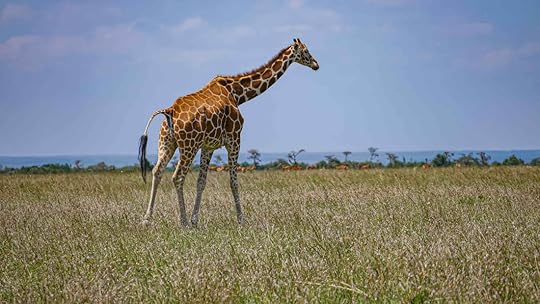 As an extra treat for ourselves, we booked a horseback-riding excursion into the rhino enclosures. Yes, that's right - we went inside with the rhinos. This was not your typical zoo field trip, this was a safari on steroids.
As an extra treat for ourselves, we booked a horseback-riding excursion into the rhino enclosures. Yes, that's right - we went inside with the rhinos. This was not your typical zoo field trip, this was a safari on steroids.
One of the best things about being on a horse as opposed to in a vehicle is that the wildlife treats you like you're a giraffe or antelope, as opposed to a noisy machine they want to run from. It was surreal being surrounded by impalas, warthogs, water buffalo, and zebras all congregating around like we were just members of the herd. They were completely unafraid of us, and without doors or windows, there was a certain freedom and vulnerability that made the experience that much more tactile, visceral, and memorable.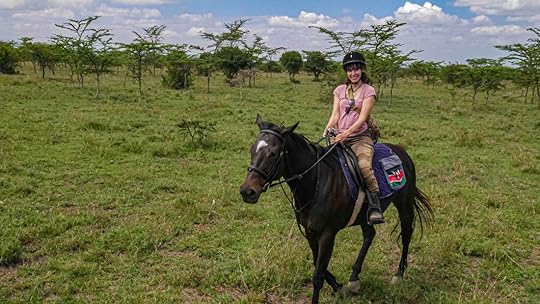
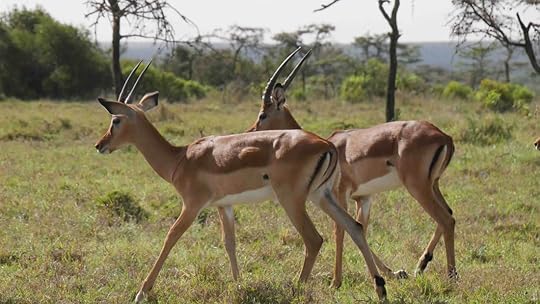 If you one day find yourself going on a safari in Africa, and you like horseback-riding, I would highly recommend combining the two experiences, as it's a whole new way of seeing the natural world around you.
If you one day find yourself going on a safari in Africa, and you like horseback-riding, I would highly recommend combining the two experiences, as it's a whole new way of seeing the natural world around you.
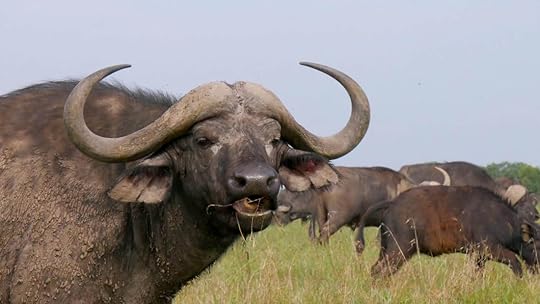
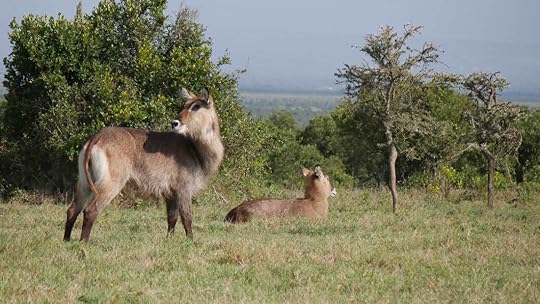 I'd be impressed if you can name this animal.
I'd be impressed if you can name this animal. 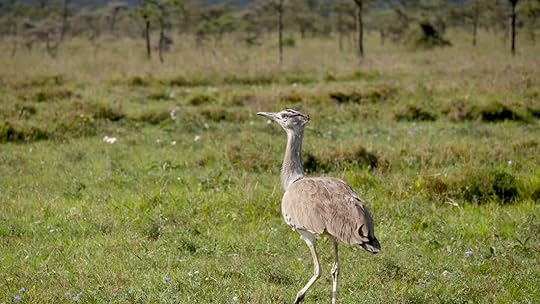 Or how about this 4 foot tall bird? As we rode into the heavily guarded enclosure with the last two Northern White Rhinos, I noticed them laying in the grass taking a morning snooze. They're both females, mother and daughter, and they both have reproductive problems. This may sound as dire as it gets, but fortunately, conservationists have kept some sperm from the last of the males, and by using the eggs from these females, they will artificially inseminate a surrogate mother of another rhino species. So there is still hope that one day, a baby Northern White Rhino will be born.
Or how about this 4 foot tall bird? As we rode into the heavily guarded enclosure with the last two Northern White Rhinos, I noticed them laying in the grass taking a morning snooze. They're both females, mother and daughter, and they both have reproductive problems. This may sound as dire as it gets, but fortunately, conservationists have kept some sperm from the last of the males, and by using the eggs from these females, they will artificially inseminate a surrogate mother of another rhino species. So there is still hope that one day, a baby Northern White Rhino will be born.
If you want to learn more about these two "girls" and what their future holds, there's a great article on them from the NYT that was published just a few days ago.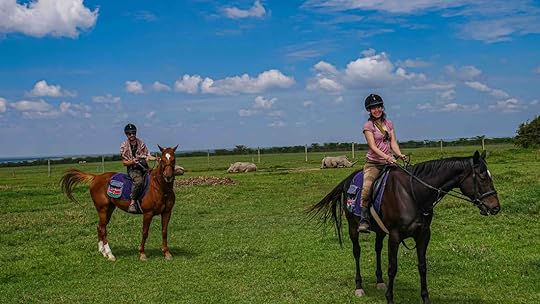 The park has plenty of other rhinos as well, and on our way back to the stables, we almost got charged by two young males who kept snorting at us and taking defensive poses. I was pretty sure I was going to pee my pants. I thought that if my horse bolts, I might fall off, and then I'd certainly get trampled to the death... Even our guide started snorting back to the rhinos, later telling us that he gets charged all the time. Those hefty liability forms we signed at the beginning suddenly made a lot of sense.
The park has plenty of other rhinos as well, and on our way back to the stables, we almost got charged by two young males who kept snorting at us and taking defensive poses. I was pretty sure I was going to pee my pants. I thought that if my horse bolts, I might fall off, and then I'd certainly get trampled to the death... Even our guide started snorting back to the rhinos, later telling us that he gets charged all the time. Those hefty liability forms we signed at the beginning suddenly made a lot of sense.
I also now understood why we had been given huge thoroughbreds to ride, because you need to have a large, fast horse in case you get charged. Slow and steady Mr. Ed just won't do in these circumstances.
As the two hot-headed males got closer, my eyes fixated on their most terrifying part - their long piercing horns. Though some conservation groups choose to cut off the rhinos' horns to prevent pouching, Ol Pejeta doesn't for several reasons. Since the horns keep growing (just like hair and nails), the process of constantly tranquilizing the animals and sawing off their horns can affect their health, and can be dangerous for the workers involved. It can also leave the rhinos defenseless against attacks from other animals, including fellow rhinos.
I have to say, the horns do make them look gorgeous and majestic, but as those two young males threatened to charge us, gorgeous and majestic were not the words running through my head.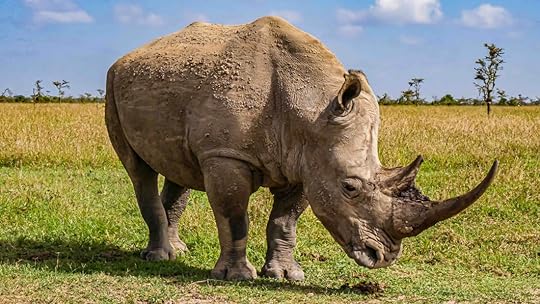 So, yes, we were almost caught in the cross-fire by these ENORMOUS animals that look like the animal version of a medieval battering ram. But luckily, they lost interest in us, and we made it out of the rhino area alive.
So, yes, we were almost caught in the cross-fire by these ENORMOUS animals that look like the animal version of a medieval battering ram. But luckily, they lost interest in us, and we made it out of the rhino area alive.
Back at the stables, we got an up-close-and-personal look at an old blind rhino named Baraka who loves eat carrots. Baraka is now completely reliant on human support for survival, so he's become the park's "ambassador" for rhino conservation, and was truly a gentle giant. I don't know if you've ever touched a rhino, but if you haven't, I will tell you that their skin feels surprisingly soft and warm.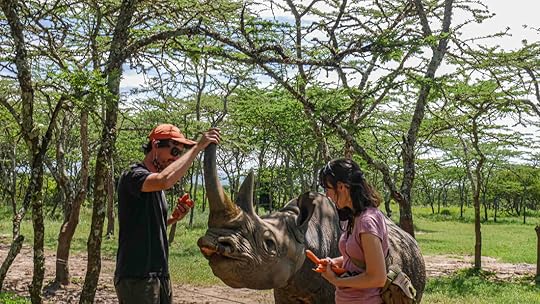 Next, we had lunch back in our car beside a herd of grazing elephants. With the car parked and turned off, the elephants came right up to us, noisily chewing on grass, and ripping it up with their trunks. The crunching sounds of the elephants grazing was very meditative, but their babies seemed to want nothing to do with this monotonous munching, and instead kept playing with each other or flopping around in the mud. How is it possible that a baby that weighs more than me can still be so cute?
Next, we had lunch back in our car beside a herd of grazing elephants. With the car parked and turned off, the elephants came right up to us, noisily chewing on grass, and ripping it up with their trunks. The crunching sounds of the elephants grazing was very meditative, but their babies seemed to want nothing to do with this monotonous munching, and instead kept playing with each other or flopping around in the mud. How is it possible that a baby that weighs more than me can still be so cute? 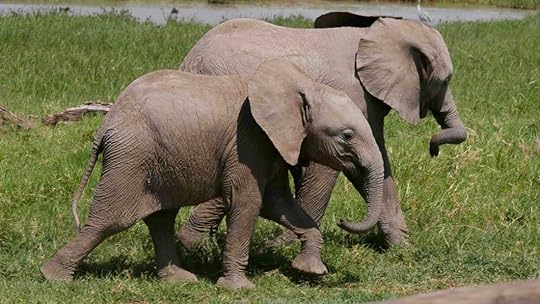 Finally, to top off the day, we got a glimpse of a few chimpanzees in their sanctuary, but it was at a 30 foot distance due to new Covid restrictions (after all, chimps are so closely related to humans, they can get Covid just like us). They are much bigger than I had expected, almost gorilla sized. I kept recalling pictures I'd seen of Jane Goodall with a chimp hanging around her neck, but that must have been a baby, because these guys would've easily wrestled her to the ground without meaning to. And those huge teeth - they were as intimidating as they were fascinating.
Finally, to top off the day, we got a glimpse of a few chimpanzees in their sanctuary, but it was at a 30 foot distance due to new Covid restrictions (after all, chimps are so closely related to humans, they can get Covid just like us). They are much bigger than I had expected, almost gorilla sized. I kept recalling pictures I'd seen of Jane Goodall with a chimp hanging around her neck, but that must have been a baby, because these guys would've easily wrestled her to the ground without meaning to. And those huge teeth - they were as intimidating as they were fascinating. 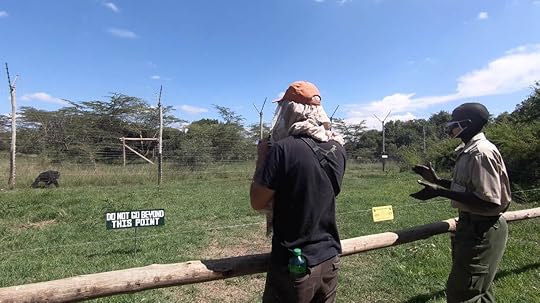 I was surprised to learn that this park is not part of the Kenyan National Park Service, but is actually a private reserve owned by some Texas oil tycoon. Yeah, that gave me a bit of a head-scratching moment, but I suppose if you have to put your money somewhere, investing in the preservation of the world's most endangered species is a great way to spend it. So I'm glad we could help contribute to this incredible cause, even in a small way.
I was surprised to learn that this park is not part of the Kenyan National Park Service, but is actually a private reserve owned by some Texas oil tycoon. Yeah, that gave me a bit of a head-scratching moment, but I suppose if you have to put your money somewhere, investing in the preservation of the world's most endangered species is a great way to spend it. So I'm glad we could help contribute to this incredible cause, even in a small way.
We'll see you again next Sunday when I talk about how the pandemic is being dealt with in Africa, and why I think they've done so well.
Until then, have a great week,
Marisa, Tim, and Baraka Subscribe to Our Blog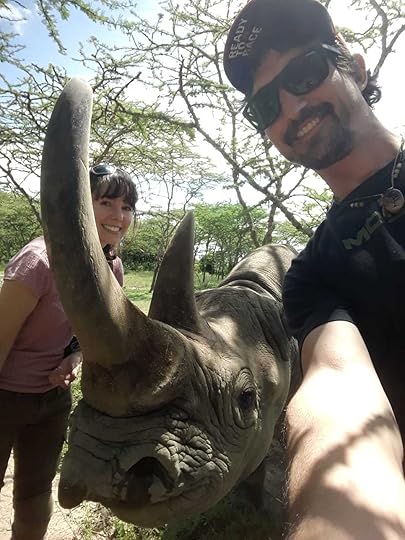
 Welcome to our Sunday Scoop - a five minute escape from the horrible news of the world (yeah, this week was pretty bad), where I will take you to an exotic land far away, a place where the last Northern White Rhinos roam.
Welcome to our Sunday Scoop - a five minute escape from the horrible news of the world (yeah, this week was pretty bad), where I will take you to an exotic land far away, a place where the last Northern White Rhinos roam.When we first moved to Nanyuki, Kenya a couple of months ago, we had no idea that only 20 minutes away from our house was a nature reserve with the last two Northern White Rhinos. But once we learned about Ol Pejeta Conservancy, and discovered that the park had half-off tickets due to the pandemic, we decided to rent a car for a day and head down the road to have one of the most memorable experiences of our lives.
 As an extra treat for ourselves, we booked a horseback-riding excursion into the rhino enclosures. Yes, that's right - we went inside with the rhinos. This was not your typical zoo field trip, this was a safari on steroids.
As an extra treat for ourselves, we booked a horseback-riding excursion into the rhino enclosures. Yes, that's right - we went inside with the rhinos. This was not your typical zoo field trip, this was a safari on steroids.One of the best things about being on a horse as opposed to in a vehicle is that the wildlife treats you like you're a giraffe or antelope, as opposed to a noisy machine they want to run from. It was surreal being surrounded by impalas, warthogs, water buffalo, and zebras all congregating around like we were just members of the herd. They were completely unafraid of us, and without doors or windows, there was a certain freedom and vulnerability that made the experience that much more tactile, visceral, and memorable.

 If you one day find yourself going on a safari in Africa, and you like horseback-riding, I would highly recommend combining the two experiences, as it's a whole new way of seeing the natural world around you.
If you one day find yourself going on a safari in Africa, and you like horseback-riding, I would highly recommend combining the two experiences, as it's a whole new way of seeing the natural world around you.
 I'd be impressed if you can name this animal.
I'd be impressed if you can name this animal.  Or how about this 4 foot tall bird? As we rode into the heavily guarded enclosure with the last two Northern White Rhinos, I noticed them laying in the grass taking a morning snooze. They're both females, mother and daughter, and they both have reproductive problems. This may sound as dire as it gets, but fortunately, conservationists have kept some sperm from the last of the males, and by using the eggs from these females, they will artificially inseminate a surrogate mother of another rhino species. So there is still hope that one day, a baby Northern White Rhino will be born.
Or how about this 4 foot tall bird? As we rode into the heavily guarded enclosure with the last two Northern White Rhinos, I noticed them laying in the grass taking a morning snooze. They're both females, mother and daughter, and they both have reproductive problems. This may sound as dire as it gets, but fortunately, conservationists have kept some sperm from the last of the males, and by using the eggs from these females, they will artificially inseminate a surrogate mother of another rhino species. So there is still hope that one day, a baby Northern White Rhino will be born.If you want to learn more about these two "girls" and what their future holds, there's a great article on them from the NYT that was published just a few days ago.
 The park has plenty of other rhinos as well, and on our way back to the stables, we almost got charged by two young males who kept snorting at us and taking defensive poses. I was pretty sure I was going to pee my pants. I thought that if my horse bolts, I might fall off, and then I'd certainly get trampled to the death... Even our guide started snorting back to the rhinos, later telling us that he gets charged all the time. Those hefty liability forms we signed at the beginning suddenly made a lot of sense.
The park has plenty of other rhinos as well, and on our way back to the stables, we almost got charged by two young males who kept snorting at us and taking defensive poses. I was pretty sure I was going to pee my pants. I thought that if my horse bolts, I might fall off, and then I'd certainly get trampled to the death... Even our guide started snorting back to the rhinos, later telling us that he gets charged all the time. Those hefty liability forms we signed at the beginning suddenly made a lot of sense. I also now understood why we had been given huge thoroughbreds to ride, because you need to have a large, fast horse in case you get charged. Slow and steady Mr. Ed just won't do in these circumstances.
As the two hot-headed males got closer, my eyes fixated on their most terrifying part - their long piercing horns. Though some conservation groups choose to cut off the rhinos' horns to prevent pouching, Ol Pejeta doesn't for several reasons. Since the horns keep growing (just like hair and nails), the process of constantly tranquilizing the animals and sawing off their horns can affect their health, and can be dangerous for the workers involved. It can also leave the rhinos defenseless against attacks from other animals, including fellow rhinos.
I have to say, the horns do make them look gorgeous and majestic, but as those two young males threatened to charge us, gorgeous and majestic were not the words running through my head.
 So, yes, we were almost caught in the cross-fire by these ENORMOUS animals that look like the animal version of a medieval battering ram. But luckily, they lost interest in us, and we made it out of the rhino area alive.
So, yes, we were almost caught in the cross-fire by these ENORMOUS animals that look like the animal version of a medieval battering ram. But luckily, they lost interest in us, and we made it out of the rhino area alive.Back at the stables, we got an up-close-and-personal look at an old blind rhino named Baraka who loves eat carrots. Baraka is now completely reliant on human support for survival, so he's become the park's "ambassador" for rhino conservation, and was truly a gentle giant. I don't know if you've ever touched a rhino, but if you haven't, I will tell you that their skin feels surprisingly soft and warm.
 Next, we had lunch back in our car beside a herd of grazing elephants. With the car parked and turned off, the elephants came right up to us, noisily chewing on grass, and ripping it up with their trunks. The crunching sounds of the elephants grazing was very meditative, but their babies seemed to want nothing to do with this monotonous munching, and instead kept playing with each other or flopping around in the mud. How is it possible that a baby that weighs more than me can still be so cute?
Next, we had lunch back in our car beside a herd of grazing elephants. With the car parked and turned off, the elephants came right up to us, noisily chewing on grass, and ripping it up with their trunks. The crunching sounds of the elephants grazing was very meditative, but their babies seemed to want nothing to do with this monotonous munching, and instead kept playing with each other or flopping around in the mud. How is it possible that a baby that weighs more than me can still be so cute?  Finally, to top off the day, we got a glimpse of a few chimpanzees in their sanctuary, but it was at a 30 foot distance due to new Covid restrictions (after all, chimps are so closely related to humans, they can get Covid just like us). They are much bigger than I had expected, almost gorilla sized. I kept recalling pictures I'd seen of Jane Goodall with a chimp hanging around her neck, but that must have been a baby, because these guys would've easily wrestled her to the ground without meaning to. And those huge teeth - they were as intimidating as they were fascinating.
Finally, to top off the day, we got a glimpse of a few chimpanzees in their sanctuary, but it was at a 30 foot distance due to new Covid restrictions (after all, chimps are so closely related to humans, they can get Covid just like us). They are much bigger than I had expected, almost gorilla sized. I kept recalling pictures I'd seen of Jane Goodall with a chimp hanging around her neck, but that must have been a baby, because these guys would've easily wrestled her to the ground without meaning to. And those huge teeth - they were as intimidating as they were fascinating.  I was surprised to learn that this park is not part of the Kenyan National Park Service, but is actually a private reserve owned by some Texas oil tycoon. Yeah, that gave me a bit of a head-scratching moment, but I suppose if you have to put your money somewhere, investing in the preservation of the world's most endangered species is a great way to spend it. So I'm glad we could help contribute to this incredible cause, even in a small way.
I was surprised to learn that this park is not part of the Kenyan National Park Service, but is actually a private reserve owned by some Texas oil tycoon. Yeah, that gave me a bit of a head-scratching moment, but I suppose if you have to put your money somewhere, investing in the preservation of the world's most endangered species is a great way to spend it. So I'm glad we could help contribute to this incredible cause, even in a small way.We'll see you again next Sunday when I talk about how the pandemic is being dealt with in Africa, and why I think they've done so well.
Until then, have a great week,
Marisa, Tim, and Baraka Subscribe to Our Blog

Published on January 09, 2021 20:50
January 2, 2021
Our Home in Kenya
By Marisa Notier The Notier Notes Our Sunday Scoop  We snapped this picture at a reserve just 20 minutes away from where we live. Ever since the pandemic started, we've had to settle down as opposed to travel full-time, which means I've unfortunately been neglecting our blog. Tim and I have been stuck in Uganda and Kenya for nine months now, waiting for the world to go back to normal. And even though it might still be a while before "normal" is back for good, I realized that you don't have to be on the road every day to have interesting adventures. Living in Africa during these crazy times is an adventure in and of itself.
We snapped this picture at a reserve just 20 minutes away from where we live. Ever since the pandemic started, we've had to settle down as opposed to travel full-time, which means I've unfortunately been neglecting our blog. Tim and I have been stuck in Uganda and Kenya for nine months now, waiting for the world to go back to normal. And even though it might still be a while before "normal" is back for good, I realized that you don't have to be on the road every day to have interesting adventures. Living in Africa during these crazy times is an adventure in and of itself.
So I've decided to do a Sunday Scoop about our lives which will just be a short weekly update about how things are here, from the bizarre to the ordinary. And since we're all pretty much stuck at home, I'm hoping it can bring you to a far away land on the other side of the globe, even if it's just for a moment.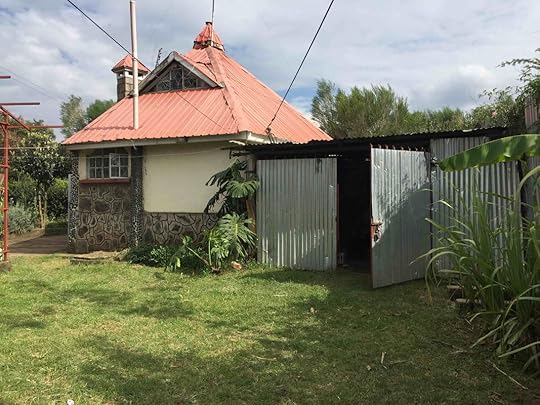 This is our house in Nanyuki, Kenya. This week I've decided to introduce you to our home in Kenya. We're renting a haphazard house in an even more haphazard town called Nanyuki, which is within sight of Mt. Kenya, Africa's second tallest mountain after Mt. Kilimanjaro. The weather here is cool due to the altitude, but we're on the equator, so the sun can be intense.
This is our house in Nanyuki, Kenya. This week I've decided to introduce you to our home in Kenya. We're renting a haphazard house in an even more haphazard town called Nanyuki, which is within sight of Mt. Kenya, Africa's second tallest mountain after Mt. Kilimanjaro. The weather here is cool due to the altitude, but we're on the equator, so the sun can be intense. 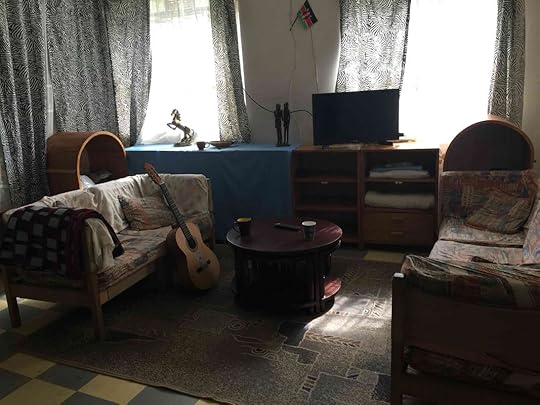 If you're going to have zebra print curtains, then Kenya is definitely the place to do it. This is the house we're renting from a friend of a friend from Uganda. I would definitely call the place a "fixer-upper" even though it was built only nine years ago, but I think African construction is a bit like making gingerbread houses - you put some concrete walls up, paste on some wooden beams, cover it all in plywood boards, and then top it off with a tin roof, and voilà! You have a house. Sort of.
If you're going to have zebra print curtains, then Kenya is definitely the place to do it. This is the house we're renting from a friend of a friend from Uganda. I would definitely call the place a "fixer-upper" even though it was built only nine years ago, but I think African construction is a bit like making gingerbread houses - you put some concrete walls up, paste on some wooden beams, cover it all in plywood boards, and then top it off with a tin roof, and voilà! You have a house. Sort of. 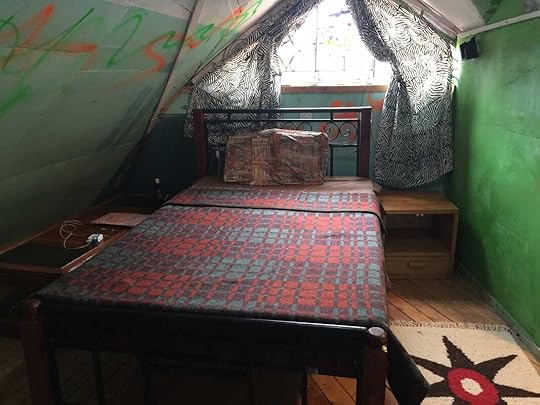 Why the Joker-colored spray paint? Who knows.
Why the Joker-colored spray paint? Who knows.  It can be a little cramped by the kitchen sink. It's not a square house, it's a something-a-gon with not a right angle in the whole place, as if every room was an afterthought. The plumbing is exposed, the wiring looks like a rat's nest, and when we first arrived, it was so filthy and cluttered with other people's belongings, I wanted to leave immediately.
It can be a little cramped by the kitchen sink. It's not a square house, it's a something-a-gon with not a right angle in the whole place, as if every room was an afterthought. The plumbing is exposed, the wiring looks like a rat's nest, and when we first arrived, it was so filthy and cluttered with other people's belongings, I wanted to leave immediately. 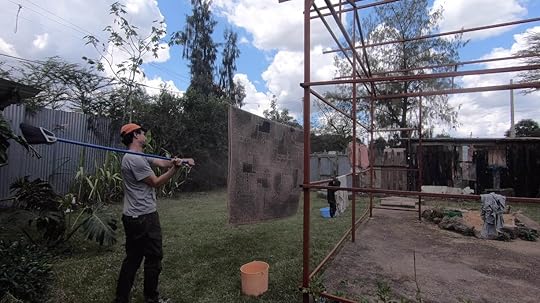 Tim even took the rug out to clean the old-fashioned way (no vacuums here). But Tim saw the potential, and now I couldn't imagine being anywhere else. After washing all the cushions, and mopping up the place (and killing more spiders than I've ever seen in one residence), it's perfect. Well, if you close your eyes, it's pretty much perfect.
Tim even took the rug out to clean the old-fashioned way (no vacuums here). But Tim saw the potential, and now I couldn't imagine being anywhere else. After washing all the cushions, and mopping up the place (and killing more spiders than I've ever seen in one residence), it's perfect. Well, if you close your eyes, it's pretty much perfect.
This house is a real upgrade from where we were living in Uganda which didn't have a washing machine, or a TV, or internet, or an oven, or hot water for a shower... this place is like a palace in comparison. Plus, it has a garden with herbs and tomatoes, sugar cane and bananas, and there's even a tin "garage" to store the bike.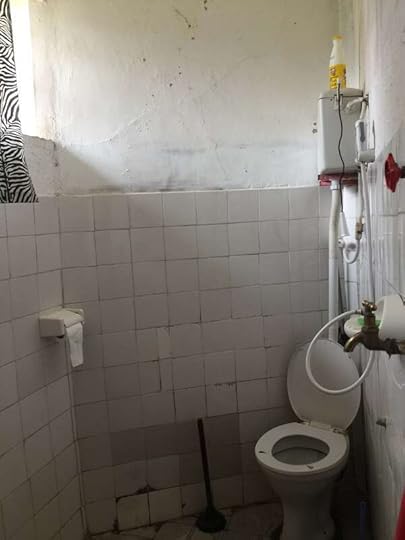 What are African toilets like? Well, pretty normal it turns out.
What are African toilets like? Well, pretty normal it turns out. 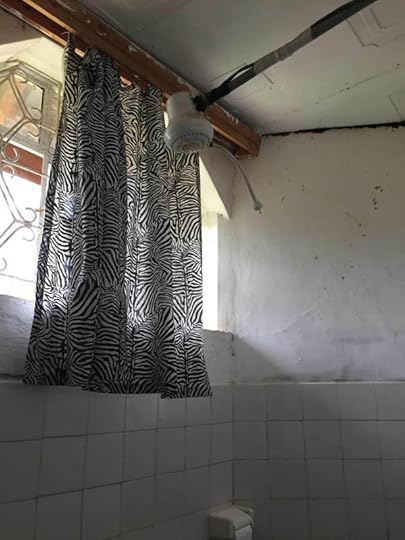 You'll often find electric showers in Kenya, a.k.a. "suicide showers".
You'll often find electric showers in Kenya, a.k.a. "suicide showers". 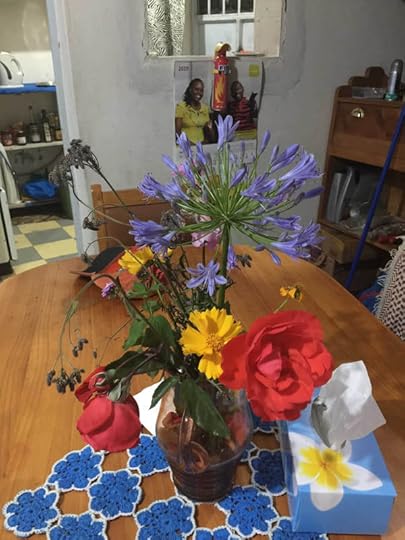 We even get fresh roses from the garden every day. But best of all, there was a stray cat that had kittens a month ago in the garden, so now we have two cute kitties running around. We really couldn't be happier with how things have turned out.
We even get fresh roses from the garden every day. But best of all, there was a stray cat that had kittens a month ago in the garden, so now we have two cute kitties running around. We really couldn't be happier with how things have turned out. 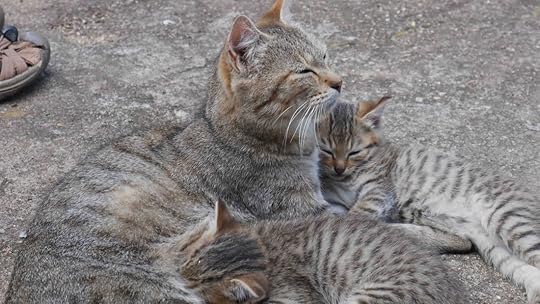 We've named the kittens Marco and Dora, because they like to explore.
We've named the kittens Marco and Dora, because they like to explore. 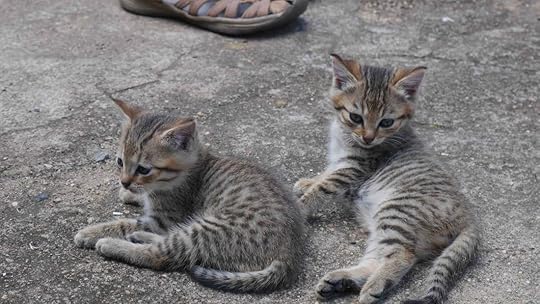 They're almost identical, but we can now tell the difference. Marco's on the left, Dora's on the right. So that's my update this week. Next time I'll take you to Ol Pejeta, the nearby wildlife reserve where we fed a blind rhino and almost got charged by his rhino brethren while riding horses through the park...
They're almost identical, but we can now tell the difference. Marco's on the left, Dora's on the right. So that's my update this week. Next time I'll take you to Ol Pejeta, the nearby wildlife reserve where we fed a blind rhino and almost got charged by his rhino brethren while riding horses through the park...
See you next Sunday! Happy Holidays and a Happy New Year from the Notiers!
Happy Holidays and a Happy New Year from the Notiers!
If you haven't already... Subscribe to Our Blog
 We snapped this picture at a reserve just 20 minutes away from where we live. Ever since the pandemic started, we've had to settle down as opposed to travel full-time, which means I've unfortunately been neglecting our blog. Tim and I have been stuck in Uganda and Kenya for nine months now, waiting for the world to go back to normal. And even though it might still be a while before "normal" is back for good, I realized that you don't have to be on the road every day to have interesting adventures. Living in Africa during these crazy times is an adventure in and of itself.
We snapped this picture at a reserve just 20 minutes away from where we live. Ever since the pandemic started, we've had to settle down as opposed to travel full-time, which means I've unfortunately been neglecting our blog. Tim and I have been stuck in Uganda and Kenya for nine months now, waiting for the world to go back to normal. And even though it might still be a while before "normal" is back for good, I realized that you don't have to be on the road every day to have interesting adventures. Living in Africa during these crazy times is an adventure in and of itself.So I've decided to do a Sunday Scoop about our lives which will just be a short weekly update about how things are here, from the bizarre to the ordinary. And since we're all pretty much stuck at home, I'm hoping it can bring you to a far away land on the other side of the globe, even if it's just for a moment.
 This is our house in Nanyuki, Kenya. This week I've decided to introduce you to our home in Kenya. We're renting a haphazard house in an even more haphazard town called Nanyuki, which is within sight of Mt. Kenya, Africa's second tallest mountain after Mt. Kilimanjaro. The weather here is cool due to the altitude, but we're on the equator, so the sun can be intense.
This is our house in Nanyuki, Kenya. This week I've decided to introduce you to our home in Kenya. We're renting a haphazard house in an even more haphazard town called Nanyuki, which is within sight of Mt. Kenya, Africa's second tallest mountain after Mt. Kilimanjaro. The weather here is cool due to the altitude, but we're on the equator, so the sun can be intense.  If you're going to have zebra print curtains, then Kenya is definitely the place to do it. This is the house we're renting from a friend of a friend from Uganda. I would definitely call the place a "fixer-upper" even though it was built only nine years ago, but I think African construction is a bit like making gingerbread houses - you put some concrete walls up, paste on some wooden beams, cover it all in plywood boards, and then top it off with a tin roof, and voilà! You have a house. Sort of.
If you're going to have zebra print curtains, then Kenya is definitely the place to do it. This is the house we're renting from a friend of a friend from Uganda. I would definitely call the place a "fixer-upper" even though it was built only nine years ago, but I think African construction is a bit like making gingerbread houses - you put some concrete walls up, paste on some wooden beams, cover it all in plywood boards, and then top it off with a tin roof, and voilà! You have a house. Sort of.  Why the Joker-colored spray paint? Who knows.
Why the Joker-colored spray paint? Who knows.  It can be a little cramped by the kitchen sink. It's not a square house, it's a something-a-gon with not a right angle in the whole place, as if every room was an afterthought. The plumbing is exposed, the wiring looks like a rat's nest, and when we first arrived, it was so filthy and cluttered with other people's belongings, I wanted to leave immediately.
It can be a little cramped by the kitchen sink. It's not a square house, it's a something-a-gon with not a right angle in the whole place, as if every room was an afterthought. The plumbing is exposed, the wiring looks like a rat's nest, and when we first arrived, it was so filthy and cluttered with other people's belongings, I wanted to leave immediately.  Tim even took the rug out to clean the old-fashioned way (no vacuums here). But Tim saw the potential, and now I couldn't imagine being anywhere else. After washing all the cushions, and mopping up the place (and killing more spiders than I've ever seen in one residence), it's perfect. Well, if you close your eyes, it's pretty much perfect.
Tim even took the rug out to clean the old-fashioned way (no vacuums here). But Tim saw the potential, and now I couldn't imagine being anywhere else. After washing all the cushions, and mopping up the place (and killing more spiders than I've ever seen in one residence), it's perfect. Well, if you close your eyes, it's pretty much perfect.This house is a real upgrade from where we were living in Uganda which didn't have a washing machine, or a TV, or internet, or an oven, or hot water for a shower... this place is like a palace in comparison. Plus, it has a garden with herbs and tomatoes, sugar cane and bananas, and there's even a tin "garage" to store the bike.
 What are African toilets like? Well, pretty normal it turns out.
What are African toilets like? Well, pretty normal it turns out.  You'll often find electric showers in Kenya, a.k.a. "suicide showers".
You'll often find electric showers in Kenya, a.k.a. "suicide showers".  We even get fresh roses from the garden every day. But best of all, there was a stray cat that had kittens a month ago in the garden, so now we have two cute kitties running around. We really couldn't be happier with how things have turned out.
We even get fresh roses from the garden every day. But best of all, there was a stray cat that had kittens a month ago in the garden, so now we have two cute kitties running around. We really couldn't be happier with how things have turned out.  We've named the kittens Marco and Dora, because they like to explore.
We've named the kittens Marco and Dora, because they like to explore.  They're almost identical, but we can now tell the difference. Marco's on the left, Dora's on the right. So that's my update this week. Next time I'll take you to Ol Pejeta, the nearby wildlife reserve where we fed a blind rhino and almost got charged by his rhino brethren while riding horses through the park...
They're almost identical, but we can now tell the difference. Marco's on the left, Dora's on the right. So that's my update this week. Next time I'll take you to Ol Pejeta, the nearby wildlife reserve where we fed a blind rhino and almost got charged by his rhino brethren while riding horses through the park...See you next Sunday!
 Happy Holidays and a Happy New Year from the Notiers!
Happy Holidays and a Happy New Year from the Notiers! If you haven't already... Subscribe to Our Blog
Published on January 02, 2021 23:40
August 14, 2020
Rwanda - A Country that Overcame the Worst
By Marisa 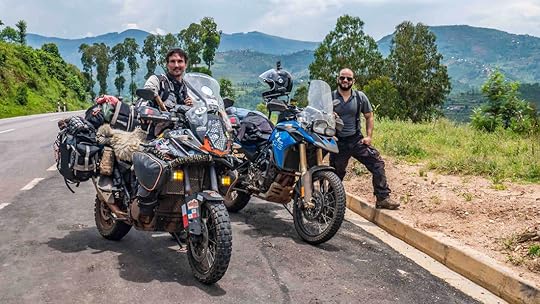 I don't like to admit it to myself, but it has become harder for me to sleep. I find myself staring at the ceiling at night, worrying about what will become of the US, how things will progress here in Uganda with the Corona Virus, and how the world will overcome such an all-encompassing and heartbreaking disaster as this pandemic. Will things ever be like they once were?
I don't like to admit it to myself, but it has become harder for me to sleep. I find myself staring at the ceiling at night, worrying about what will become of the US, how things will progress here in Uganda with the Corona Virus, and how the world will overcome such an all-encompassing and heartbreaking disaster as this pandemic. Will things ever be like they once were?
But right before Tim and I arrived here in Uganda (where the border closed around us due to the pandemic), we had the opportunity to travel through a small country that could really teach the world something about getting back on your feet after tragedy strikes: Rwanda.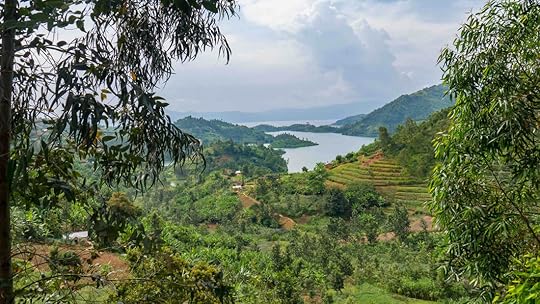 There is no shortage of beautiful views in Rwanda. It's hard to think of something that could be worse than this pandemic, but the Rwandan Genocide was just that. For three months in 1994, decades of brewing tensions between two ethnic groups, the Hutus and the Tutsis, boiled over into an explosive series of mass killings, mostly with machetes. By the end of it, more than 800,000 people had died, with nearly 70% of the Tutsi population slaughtered, as the rest of the world pretty much just stood idly and watched. And what makes this genocide all the more visceral is that it happened a mere 26 years ago.
There is no shortage of beautiful views in Rwanda. It's hard to think of something that could be worse than this pandemic, but the Rwandan Genocide was just that. For three months in 1994, decades of brewing tensions between two ethnic groups, the Hutus and the Tutsis, boiled over into an explosive series of mass killings, mostly with machetes. By the end of it, more than 800,000 people had died, with nearly 70% of the Tutsi population slaughtered, as the rest of the world pretty much just stood idly and watched. And what makes this genocide all the more visceral is that it happened a mere 26 years ago.
I used to teach my high school students about the Rwandan Genocide every year, showing them the movie Hotel Rwanda, which I've seen more times than I can count. So when Tim and I found ourselves planning our motorcycle route through Africa, we decided to visit Rwanda even though it was a bit out of our way. But I was very interested to see how this tiny country had overcome the unimaginable setback of the genocide.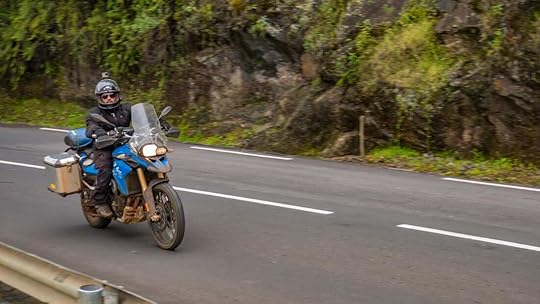 This is Leo on his BMW F800. The night before we were to enter Rwanda, we met up with an American motorcycle traveling friend who we'd first gotten to know in Namibia: Leo. He just happened to pull up to our hotel, and said that he was headed to Rwanda as well. So after a wonderful evening of stories and laughter, we all decided to ride through Rwanda together.
This is Leo on his BMW F800. The night before we were to enter Rwanda, we met up with an American motorcycle traveling friend who we'd first gotten to know in Namibia: Leo. He just happened to pull up to our hotel, and said that he was headed to Rwanda as well. So after a wonderful evening of stories and laughter, we all decided to ride through Rwanda together.
The next day at the border we had perfect weather: intensely sunny (Rwanda is nearly on the equator), but the elevation in the mountains made the wind cool. This was heavenly motorcycle weather, as I love feeling fresh breezes rush through my jacket. To make things even better, when entering Rwanda I realized that they drive on the right side of the road, which is, from my American perspective, the correct side of the road! This is due to the Belgian and German colonial influence over Rwanda as opposed to the British, and for Tim and I, it was extremely exciting since we had been driving on the British side in every single country we've been to from South Africa and up.
So while we glided down an astonishingly well-paved Rwandan highway, I just couldn't stop smiling, as I had this feeling that I was really going to like Rwanda.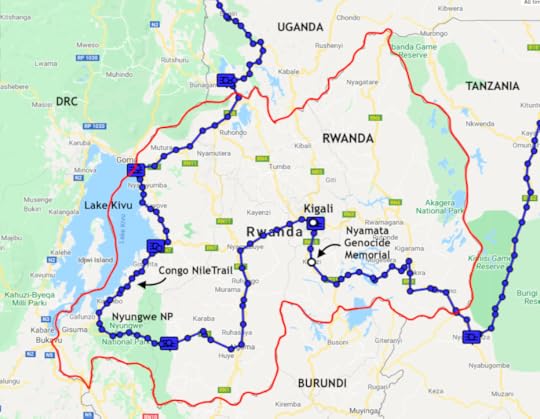 There is a lot of awesomeness packed into this little country. First thing that needs to be noted about Rwanda is that it's tiny. About the size of the state of Maryland, Rwanda is smushed right between the volcanic jungles of Africa's deep interior of the Congo, and the iconic savannah's of Eastern Africa's Serengeti. But because it's incredibly mountainous and highly populated, Rwanda isn't really like either of those sprawling regions. In fact, because of the tight jigsaw of mountains, nothing in Rwanda is sprawling. More like everything has been carved and fitted into place within the rugged landscape.
There is a lot of awesomeness packed into this little country. First thing that needs to be noted about Rwanda is that it's tiny. About the size of the state of Maryland, Rwanda is smushed right between the volcanic jungles of Africa's deep interior of the Congo, and the iconic savannah's of Eastern Africa's Serengeti. But because it's incredibly mountainous and highly populated, Rwanda isn't really like either of those sprawling regions. In fact, because of the tight jigsaw of mountains, nothing in Rwanda is sprawling. More like everything has been carved and fitted into place within the rugged landscape.
Once across the border, I very quickly realized that agriculture reigns king in Rwanda. The entire country is covered in twisty mountain roads that wind their way through lush peaks and valleys, with the steep hills having been terraced and tamed by the myriad of farmers who call this country home. And it was so green! There were tea fields nestled between the fanned-out leaves of banana trees, all hugged into the embrace of steaming and misting mountains of jungles rich with exotic bird calls and the hoots of monkeys.
In less than an hour of riding, I knew that we had made the right choice to come to Rwanda.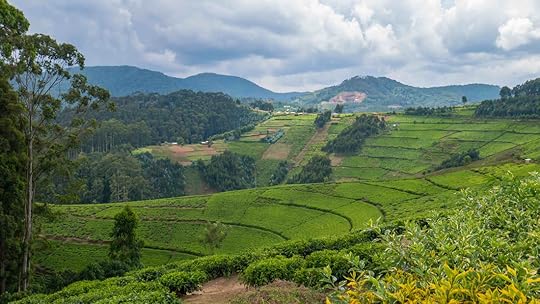 Rwanda's micro climates allow them to be able to grow a variety of crops. These are tea bushes. The road from the Tanzanian border leads straight to Rwanda's capital city of Kigali, but we decided to veer off that perfect highway and get some dirt. We turned from the main road onto what was at first a ramshackle gravel road that very quickly dissolved into an even worse one-track donkey trail. This was tricky riding, but because of the good weather and our good moods, we were loving it, smashing our way through thorny bushes as the local farmers would stare at us with mouth ajar.
Rwanda's micro climates allow them to be able to grow a variety of crops. These are tea bushes. The road from the Tanzanian border leads straight to Rwanda's capital city of Kigali, but we decided to veer off that perfect highway and get some dirt. We turned from the main road onto what was at first a ramshackle gravel road that very quickly dissolved into an even worse one-track donkey trail. This was tricky riding, but because of the good weather and our good moods, we were loving it, smashing our way through thorny bushes as the local farmers would stare at us with mouth ajar. 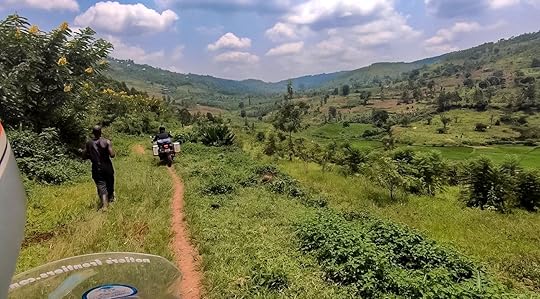 This was actually a marked street on Google!
This was actually a marked street on Google! 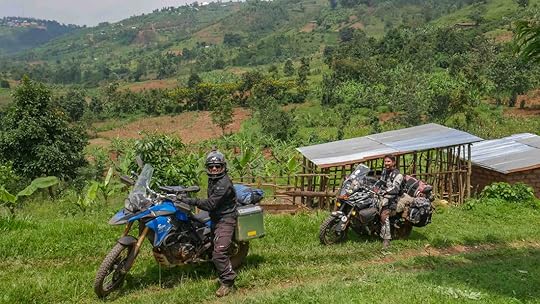 Thankfully, that trail didn't last for too long, and it eventually widened out to become a decent-sized dirt road. For lunch, we stopped at a restaurant that served us a massive meal of cooked bananas and a brothy stew of sheep meat still on the bone, all for a few dollars. And while we ate, we discovered that our bikes outside had gained a bit of attention. In fact, I think the whole village was there to inspect our beastly motorcycles, pointing at things, and stroking our sheepskin seat cover. Then as we mounted our steeds, they all waved at us, calling out “Goodbye!" as we headed off into the dust.
Thankfully, that trail didn't last for too long, and it eventually widened out to become a decent-sized dirt road. For lunch, we stopped at a restaurant that served us a massive meal of cooked bananas and a brothy stew of sheep meat still on the bone, all for a few dollars. And while we ate, we discovered that our bikes outside had gained a bit of attention. In fact, I think the whole village was there to inspect our beastly motorcycles, pointing at things, and stroking our sheepskin seat cover. Then as we mounted our steeds, they all waved at us, calling out “Goodbye!" as we headed off into the dust.  Leo being engulfed by curious onlookers. Before making our way up to the city of Kigali for the night, we visited the Nyamata Genocide Memorial. Rwanda has many genocide museums and memorials, and this is just one of them, located at a burial site of 50,000 people who lost their lives in the genocide, beside which is a village church where more than 5,000 people hid, but were subsequently killed inside.
Leo being engulfed by curious onlookers. Before making our way up to the city of Kigali for the night, we visited the Nyamata Genocide Memorial. Rwanda has many genocide museums and memorials, and this is just one of them, located at a burial site of 50,000 people who lost their lives in the genocide, beside which is a village church where more than 5,000 people hid, but were subsequently killed inside. 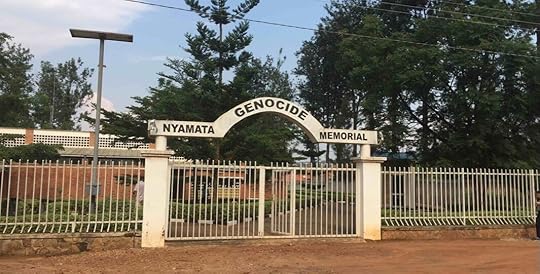 As the people locked themselves into the church, attackers found ways inside to shoot them or kill them with grenades. If you visit this church today you can see the roof dappled in bullet holes, and there is still blood stained on the altar.
As the people locked themselves into the church, attackers found ways inside to shoot them or kill them with grenades. If you visit this church today you can see the roof dappled in bullet holes, and there is still blood stained on the altar.
Pictures and video are not allowed inside the church, but I can describe for you the haunting sensation of stepping through the double doors and unexpectedly seeing piles of clothes everywhere. Fabrics torn apart, bloodied, heaped onto the floor and stacked on top of pews. Women's dresses of what had once been bright yellow florals, and tiny shirts for children, now pink with dried blood. The bodies have since been buried, but their clothes remain in the church.
I kept repeating that number in my head: at least 5,000 people were killed in that church. 800,000 were killed in Rwanda. These numbers can't possibly express the gravity of the weight that they actually bear. Now with the pandemic, I'm getting a new sense of how tragic those zeros are. 170,000 so far in the USA, nearly 800,000 globally... and to think that this same number of fatalities died in an area the size of Maryland. It's incomprehensible.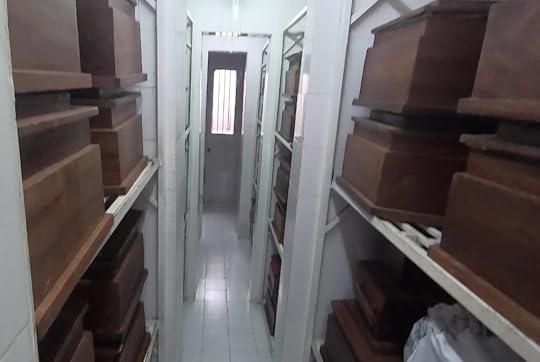 Part of the Nyamata Memorial is a burial ground and mausoleum shown here with rows and rows of coffins. Visiting that church left us feeling heavy and silenced, but as we rode into Kigali, Rwanda's largest city, a sense of hope began to fill me. I noticed right away that this was quite different from any other neighboring African city I had been to. Not only were the roads well-paved, but they had painted lines for lanes, raised curbs with designated pedestrian areas, reflective strips, good signage, and even street lamps! Street lamps! I'd forgotten such things existed... Then I saw the glass buildings of the downtown area that were new and modern, and moto-taxi drivers had on emergency reflective vests, all wearing helmets while carrying an extra one for any potential passengers. Such order!
Part of the Nyamata Memorial is a burial ground and mausoleum shown here with rows and rows of coffins. Visiting that church left us feeling heavy and silenced, but as we rode into Kigali, Rwanda's largest city, a sense of hope began to fill me. I noticed right away that this was quite different from any other neighboring African city I had been to. Not only were the roads well-paved, but they had painted lines for lanes, raised curbs with designated pedestrian areas, reflective strips, good signage, and even street lamps! Street lamps! I'd forgotten such things existed... Then I saw the glass buildings of the downtown area that were new and modern, and moto-taxi drivers had on emergency reflective vests, all wearing helmets while carrying an extra one for any potential passengers. Such order!
And best of all, there was no garbage on the streets. None. Had I entered Wakanda by accident? It was all so much that I called home that night to tell my mother about this clean and orderly civilization that I had come across in the heart of Africa, like I'd discovered the golden city of El Dorado hidden in the jungle.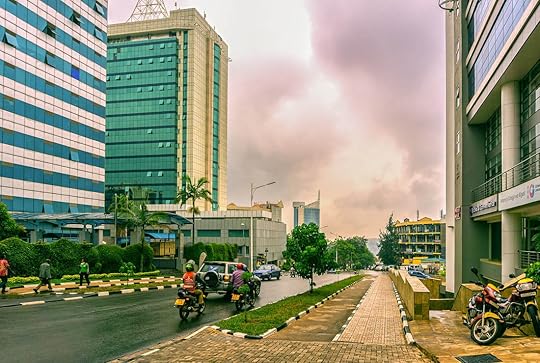 Downtown Kigali, Rwanda. This photo is not ours (photo credit: @Portraitor from Pixabay). It turns out that ever since the genocide, Rwanda has made some massive developmental improvements. You can start a business in Rwanda in 48 hours, and refugees from other countries are not restricted from working, but are instead encouraged to be entrepreneurs. This has helped their economy grow at an astonishing rate, and Rwanda has invested heavily on its healthcare sector and infrastructure (hence the nice roads). Plus, in 2007 Rwanda became the first country in the world to outright ban plastic bags, and there are steep fines for people bringing them in.
Downtown Kigali, Rwanda. This photo is not ours (photo credit: @Portraitor from Pixabay). It turns out that ever since the genocide, Rwanda has made some massive developmental improvements. You can start a business in Rwanda in 48 hours, and refugees from other countries are not restricted from working, but are instead encouraged to be entrepreneurs. This has helped their economy grow at an astonishing rate, and Rwanda has invested heavily on its healthcare sector and infrastructure (hence the nice roads). Plus, in 2007 Rwanda became the first country in the world to outright ban plastic bags, and there are steep fines for people bringing them in.
Interestingly enough, because mostly men died in the genocide, a majority of women were left, and so Rwanda has the world's highest representation of women in parliament. Maybe all these women in government have something to do with why Rwanda is so awesome? Okay, I can't prove it, but it did cross my mind...
But the change I find to be most interesting of all is that Rwanda has a required policy of doing community service work for one Saturday out of the month, a practice called umuganda. Everyone must do it, including the president, and this has helped clean the cities and communities, as well as build medical centers, schools, and even hydroelectric plants. The roads in Rwanda are amazing! Rwanda was starting to sound nicer and nicer, and so even though Tim and I aren't really fans of big cities, we stayed in Kigali for a few days, enjoying luxuries that were hard to find in neighboring countries. Food in Kigali was fantastic, and maybe this had something to do with the Belgian/French influence, but you could find freshly-baked baguettes, pastries, and international meals like beef stroganoff. We splurged on a rooftop restaurant overlooking the city, sipping on cocktails and fruit smoothies while I took in mouthfuls of a fantastic goat cheese and basil chicken panini, but I didn't realize that this would be the last time that we would be able to safely do such things. Bad news was already spreading out of China about COVID-19, but at the time, these worries felt a million miles away.
The roads in Rwanda are amazing! Rwanda was starting to sound nicer and nicer, and so even though Tim and I aren't really fans of big cities, we stayed in Kigali for a few days, enjoying luxuries that were hard to find in neighboring countries. Food in Kigali was fantastic, and maybe this had something to do with the Belgian/French influence, but you could find freshly-baked baguettes, pastries, and international meals like beef stroganoff. We splurged on a rooftop restaurant overlooking the city, sipping on cocktails and fruit smoothies while I took in mouthfuls of a fantastic goat cheese and basil chicken panini, but I didn't realize that this would be the last time that we would be able to safely do such things. Bad news was already spreading out of China about COVID-19, but at the time, these worries felt a million miles away.
From Kigali, we headed on to find a fabled road that we had heard about: the road through Nyungwe Forest. Nyungwe National Park is a tourist hotspot beloved for its mountains, waterfall hikes, suspension canopy tours, and perhaps most of all, its chimpanzee treks. And people had told us that the road through it is not to be missed. So we weaved our way out from Kigali and arrived at Rwanda's western reaches that edge into the Congo to check out this road, hoping the rumors were more than just hype.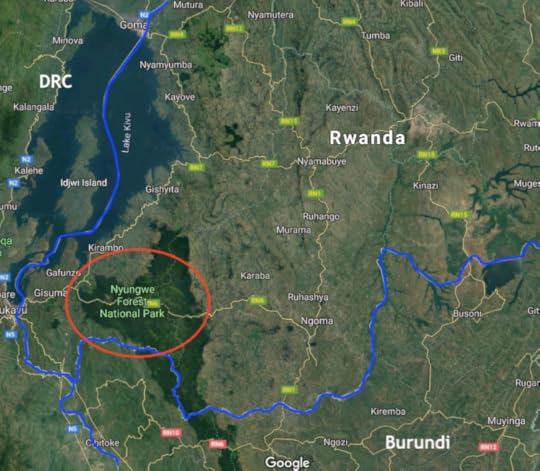 This satellite image really shows the deep green density of Nyungwe's jungle. Also check out Lake Kivu's interesting shape. I've been to jungles before. I've climbed the Mayan temples of Tikal in Guatemala where howler monkeys sound their haunting calls. I've trekked through the sweltering Amazon along highways of leaf-cutter ants, and I've seen the tree roots of Angkor Wat in Cambodia slowly rip apart the abandoned city's stone doorways. But this forest, this Nyungwe of Rwanda, felt more ancestrally-rooted, more prehistoric, and more majestic than anything I had ever seen before.
This satellite image really shows the deep green density of Nyungwe's jungle. Also check out Lake Kivu's interesting shape. I've been to jungles before. I've climbed the Mayan temples of Tikal in Guatemala where howler monkeys sound their haunting calls. I've trekked through the sweltering Amazon along highways of leaf-cutter ants, and I've seen the tree roots of Angkor Wat in Cambodia slowly rip apart the abandoned city's stone doorways. But this forest, this Nyungwe of Rwanda, felt more ancestrally-rooted, more prehistoric, and more majestic than anything I had ever seen before.
Jungles are actually hard to comprehend all at once because they're just so thick, you only get bits and pieces at a time, like glimpses of big-eyed frogs, colorful parrot feathers, or drops of water hovering on the tips of fern leaves. But you never really get the full grandeur.
But this is where the road through Nyungwe shines, because this ancient African rainforest is so mountainous, and the road is so well built, you get unbelievable vistas of the deepest of green mountains layering over one another, with the misty tendrils of clouds curling around their peaks like it's a picture on the welcome sign to Jurassic park. Half-expecting to see a brontosaurus stick its head out of the distant foliage, I felt I just wanted to go swinging through the vines like Tarzan, running like a child, climbing through the branches, and jumping from limb to limb of these immense trees that can only be rivaled by the forests of Avatar.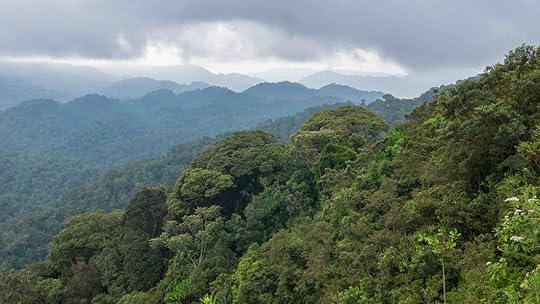 Nyungwe National Park, Rwanda For a rainforest, it was by pure chance that we somehow avoided the rain. The road dipped and turned through one cloud and into the next, separated by sun-filled gaps where the true greens of the trees would be illuminated by the golden sunlight. Until the next cloud would hurl us into a dark fog, reminding us that there are dangerous creatures all around. Watching us. There was no denying that this forest was alive with the buzzing sound of insects and the screeches of hidden animals - a jungle that epitomized the very word wild.
Nyungwe National Park, Rwanda For a rainforest, it was by pure chance that we somehow avoided the rain. The road dipped and turned through one cloud and into the next, separated by sun-filled gaps where the true greens of the trees would be illuminated by the golden sunlight. Until the next cloud would hurl us into a dark fog, reminding us that there are dangerous creatures all around. Watching us. There was no denying that this forest was alive with the buzzing sound of insects and the screeches of hidden animals - a jungle that epitomized the very word wild. 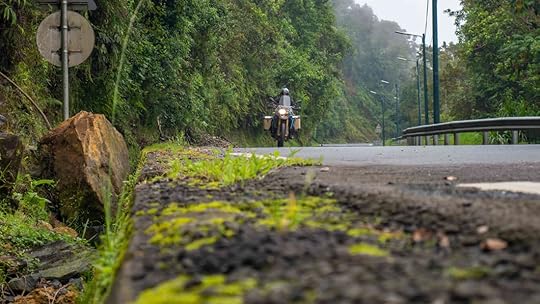 Nyungwe Forest may have been rugged, but this road was as smooth as a dream. As the road snaked and slithered its way through the mountains, we immediately knew that it was not only an incredible road, but it was also the most heavily-militarized road I've ever been on. About every 150 feet there was another young solder. Sometimes his fatigues and matching camo helmet would blend into the greenery, and I could only catch a glimpse of his shiny boots and the black magazine of his AK-47 through all the leaves. It soon became a game for Tim and me to try to “spot the soldier", and we would always wave to these young men, hoping for a wave back, and sometimes we got it. Other times they would just watch us pass. What they were all doing there, I'm not quite sure, but the forest borders Burundi, which has been ravaged by political and economic strife, as well as the DRC, which is the poorest country on earth. And I've heard that refugees and poachers had been known to illegally come through Nyungwe and into Rwanda.
Nyungwe Forest may have been rugged, but this road was as smooth as a dream. As the road snaked and slithered its way through the mountains, we immediately knew that it was not only an incredible road, but it was also the most heavily-militarized road I've ever been on. About every 150 feet there was another young solder. Sometimes his fatigues and matching camo helmet would blend into the greenery, and I could only catch a glimpse of his shiny boots and the black magazine of his AK-47 through all the leaves. It soon became a game for Tim and me to try to “spot the soldier", and we would always wave to these young men, hoping for a wave back, and sometimes we got it. Other times they would just watch us pass. What they were all doing there, I'm not quite sure, but the forest borders Burundi, which has been ravaged by political and economic strife, as well as the DRC, which is the poorest country on earth. And I've heard that refugees and poachers had been known to illegally come through Nyungwe and into Rwanda.
So with a mixture of feeling both way-too-safe, and very unsafe, we rode our way through that incredible forest. And though we did not see any chimpanzees, we did see lots of other monkeys.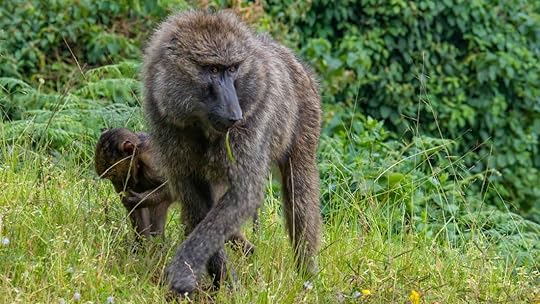 The road through Nyungwe may be built for speed, but you have to be careful and watch out for baboons in the road.
The road through Nyungwe may be built for speed, but you have to be careful and watch out for baboons in the road. 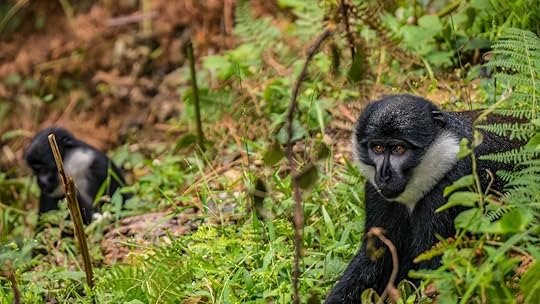 These guys are cute, and they have a secret surprise: bright blue testicles! Outside of Nyungwe, we were once again immersed back into the world of agriculture, where the old forests had all been cut down and the mountains chiseled into the perfect staircase steps of terraces.
These guys are cute, and they have a secret surprise: bright blue testicles! Outside of Nyungwe, we were once again immersed back into the world of agriculture, where the old forests had all been cut down and the mountains chiseled into the perfect staircase steps of terraces.
There was one more site on our list to see in Rwanda before our time there would come to an end, and that was Lake Kivu. Again, I wondered why people were raving so much about a lake when the whole region was speckled in lakes, and I didn't understand how Lake Kivu would be any different from the much larger Lake Victoria which we had just seen in Tanzania.
But it turns out that Lake Kivu is extremely picturesque because of its jagged shape, like an ink blotter test. That gives it a stunning mangled shoreline of green cliffs and hills, with islands dotting the lake as far as the blue horizon.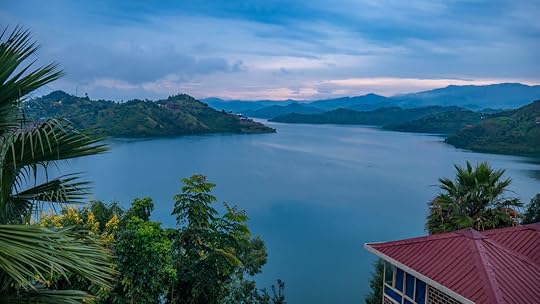 Magnificent Lake Kivu in the evening. To really get a sense of the lake's beauty by motorcycle, we took something called the Congo Nile Trail (best name ever???). Tourists sometimes go on it by bicycle, but we were up for a motorcycle challenge, and even though some washed-out sections were crossable only by riding over logs placed over the gaps, it was an incredible ride. The views simply bathed our eyes in natural wonders, and the weather couldn't have been better. But it was the people that made this journey what it was.
Magnificent Lake Kivu in the evening. To really get a sense of the lake's beauty by motorcycle, we took something called the Congo Nile Trail (best name ever???). Tourists sometimes go on it by bicycle, but we were up for a motorcycle challenge, and even though some washed-out sections were crossable only by riding over logs placed over the gaps, it was an incredible ride. The views simply bathed our eyes in natural wonders, and the weather couldn't have been better. But it was the people that made this journey what it was. 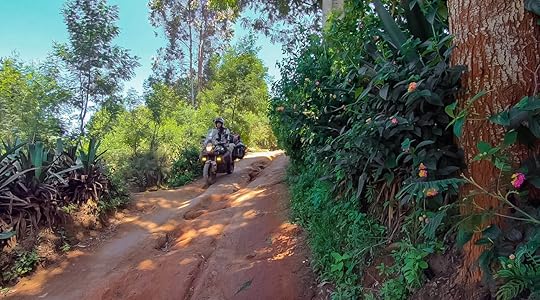 Sometimes the "road" got a little technical.
Sometimes the "road" got a little technical. 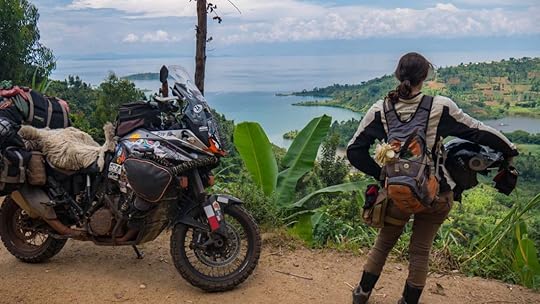 Me, the bike, and the view of Lake Kivu, Rwanda. The Congo Nile Trail cuts through fishing villages, farms, and lumber towns where school children would all wave at us, boys chasing us with huge smiles on their faces. We were definitely the celebrities of the area, and we felt a bit like super heroes as we adventured our way through eucalyptus forests, along cliff sides, and beside the lapping waves of the lake.
Me, the bike, and the view of Lake Kivu, Rwanda. The Congo Nile Trail cuts through fishing villages, farms, and lumber towns where school children would all wave at us, boys chasing us with huge smiles on their faces. We were definitely the celebrities of the area, and we felt a bit like super heroes as we adventured our way through eucalyptus forests, along cliff sides, and beside the lapping waves of the lake.
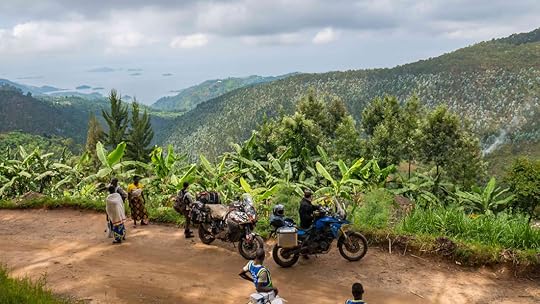 I can't believe the local people found our bikes more interesting to look at than that view! One of our last nights in Rwanda was spent at a lovely hotel overlooking Lake Kivu where we talked with other tourists staying there about their concerns over the virus. So far, there had been no cases reported in Sub-Saharan Africa, though we suspected Nairobi would get it next. A man from Germany said he had paid for a tour in the Congo the next day to see gorillas and that he was not concerned. A French man and an American both said they were going to cut their trips short and were going home. Leo, Tim, and I, all agreed that we would simply keep going to Uganda and see how things played out.
I can't believe the local people found our bikes more interesting to look at than that view! One of our last nights in Rwanda was spent at a lovely hotel overlooking Lake Kivu where we talked with other tourists staying there about their concerns over the virus. So far, there had been no cases reported in Sub-Saharan Africa, though we suspected Nairobi would get it next. A man from Germany said he had paid for a tour in the Congo the next day to see gorillas and that he was not concerned. A French man and an American both said they were going to cut their trips short and were going home. Leo, Tim, and I, all agreed that we would simply keep going to Uganda and see how things played out.
The next day, a confirmed case was discovered in Kinshasa, DRC, and the border to the Congo closed overnight. The German's gorilla tour was cancelled. The others got their flights out of Rwanda, and the three of us carried onto Uganda, but it wasn't long before all the land borders and airports closed. And Tim and I have been stuck in Uganda ever since.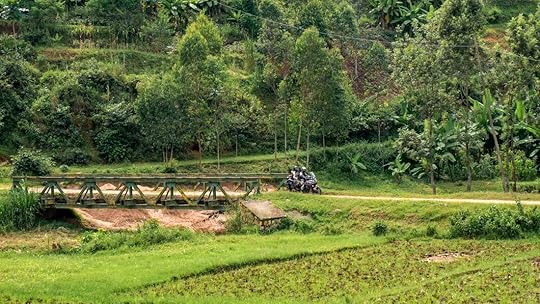 Tim and I riding through the beautiful Rwandan countryside. The world has now been sent into this downward spiral that seems apocalyptic, but whenever I'm feeling I can't sleep at night, I think back to Rwanda. And I wonder, “How did they do it?" How did they overcome such a horrific setback to become one of the leading and most progressive countries in the region?
Tim and I riding through the beautiful Rwandan countryside. The world has now been sent into this downward spiral that seems apocalyptic, but whenever I'm feeling I can't sleep at night, I think back to Rwanda. And I wonder, “How did they do it?" How did they overcome such a horrific setback to become one of the leading and most progressive countries in the region?
And I think it boils down to three things: they have honored the memories of those they've lost without blaming each other, they have embraced a message of unifying and healing the country through community service, and they have taken their tragedy as an opportunity to build again. To build something better than they had before.
So even though I used to only think of Rwanda as a place of devastation, now that I have been there myself, I see it as a place of hope and inspiration. It's a lesson that I can always look back on and smile. Tim and I wish everyone out there the best, and we hope you find yourselves safe and well.
Tim and I wish everyone out there the best, and we hope you find yourselves safe and well.
Our next blog post will be about how things went down here in Uganda, what we've seen so far, and what we plan to do next. Subscribe to Our Blog
 I don't like to admit it to myself, but it has become harder for me to sleep. I find myself staring at the ceiling at night, worrying about what will become of the US, how things will progress here in Uganda with the Corona Virus, and how the world will overcome such an all-encompassing and heartbreaking disaster as this pandemic. Will things ever be like they once were?
I don't like to admit it to myself, but it has become harder for me to sleep. I find myself staring at the ceiling at night, worrying about what will become of the US, how things will progress here in Uganda with the Corona Virus, and how the world will overcome such an all-encompassing and heartbreaking disaster as this pandemic. Will things ever be like they once were?But right before Tim and I arrived here in Uganda (where the border closed around us due to the pandemic), we had the opportunity to travel through a small country that could really teach the world something about getting back on your feet after tragedy strikes: Rwanda.
 There is no shortage of beautiful views in Rwanda. It's hard to think of something that could be worse than this pandemic, but the Rwandan Genocide was just that. For three months in 1994, decades of brewing tensions between two ethnic groups, the Hutus and the Tutsis, boiled over into an explosive series of mass killings, mostly with machetes. By the end of it, more than 800,000 people had died, with nearly 70% of the Tutsi population slaughtered, as the rest of the world pretty much just stood idly and watched. And what makes this genocide all the more visceral is that it happened a mere 26 years ago.
There is no shortage of beautiful views in Rwanda. It's hard to think of something that could be worse than this pandemic, but the Rwandan Genocide was just that. For three months in 1994, decades of brewing tensions between two ethnic groups, the Hutus and the Tutsis, boiled over into an explosive series of mass killings, mostly with machetes. By the end of it, more than 800,000 people had died, with nearly 70% of the Tutsi population slaughtered, as the rest of the world pretty much just stood idly and watched. And what makes this genocide all the more visceral is that it happened a mere 26 years ago.I used to teach my high school students about the Rwandan Genocide every year, showing them the movie Hotel Rwanda, which I've seen more times than I can count. So when Tim and I found ourselves planning our motorcycle route through Africa, we decided to visit Rwanda even though it was a bit out of our way. But I was very interested to see how this tiny country had overcome the unimaginable setback of the genocide.
 This is Leo on his BMW F800. The night before we were to enter Rwanda, we met up with an American motorcycle traveling friend who we'd first gotten to know in Namibia: Leo. He just happened to pull up to our hotel, and said that he was headed to Rwanda as well. So after a wonderful evening of stories and laughter, we all decided to ride through Rwanda together.
This is Leo on his BMW F800. The night before we were to enter Rwanda, we met up with an American motorcycle traveling friend who we'd first gotten to know in Namibia: Leo. He just happened to pull up to our hotel, and said that he was headed to Rwanda as well. So after a wonderful evening of stories and laughter, we all decided to ride through Rwanda together.The next day at the border we had perfect weather: intensely sunny (Rwanda is nearly on the equator), but the elevation in the mountains made the wind cool. This was heavenly motorcycle weather, as I love feeling fresh breezes rush through my jacket. To make things even better, when entering Rwanda I realized that they drive on the right side of the road, which is, from my American perspective, the correct side of the road! This is due to the Belgian and German colonial influence over Rwanda as opposed to the British, and for Tim and I, it was extremely exciting since we had been driving on the British side in every single country we've been to from South Africa and up.
So while we glided down an astonishingly well-paved Rwandan highway, I just couldn't stop smiling, as I had this feeling that I was really going to like Rwanda.
 There is a lot of awesomeness packed into this little country. First thing that needs to be noted about Rwanda is that it's tiny. About the size of the state of Maryland, Rwanda is smushed right between the volcanic jungles of Africa's deep interior of the Congo, and the iconic savannah's of Eastern Africa's Serengeti. But because it's incredibly mountainous and highly populated, Rwanda isn't really like either of those sprawling regions. In fact, because of the tight jigsaw of mountains, nothing in Rwanda is sprawling. More like everything has been carved and fitted into place within the rugged landscape.
There is a lot of awesomeness packed into this little country. First thing that needs to be noted about Rwanda is that it's tiny. About the size of the state of Maryland, Rwanda is smushed right between the volcanic jungles of Africa's deep interior of the Congo, and the iconic savannah's of Eastern Africa's Serengeti. But because it's incredibly mountainous and highly populated, Rwanda isn't really like either of those sprawling regions. In fact, because of the tight jigsaw of mountains, nothing in Rwanda is sprawling. More like everything has been carved and fitted into place within the rugged landscape.Once across the border, I very quickly realized that agriculture reigns king in Rwanda. The entire country is covered in twisty mountain roads that wind their way through lush peaks and valleys, with the steep hills having been terraced and tamed by the myriad of farmers who call this country home. And it was so green! There were tea fields nestled between the fanned-out leaves of banana trees, all hugged into the embrace of steaming and misting mountains of jungles rich with exotic bird calls and the hoots of monkeys.
In less than an hour of riding, I knew that we had made the right choice to come to Rwanda.
 Rwanda's micro climates allow them to be able to grow a variety of crops. These are tea bushes. The road from the Tanzanian border leads straight to Rwanda's capital city of Kigali, but we decided to veer off that perfect highway and get some dirt. We turned from the main road onto what was at first a ramshackle gravel road that very quickly dissolved into an even worse one-track donkey trail. This was tricky riding, but because of the good weather and our good moods, we were loving it, smashing our way through thorny bushes as the local farmers would stare at us with mouth ajar.
Rwanda's micro climates allow them to be able to grow a variety of crops. These are tea bushes. The road from the Tanzanian border leads straight to Rwanda's capital city of Kigali, but we decided to veer off that perfect highway and get some dirt. We turned from the main road onto what was at first a ramshackle gravel road that very quickly dissolved into an even worse one-track donkey trail. This was tricky riding, but because of the good weather and our good moods, we were loving it, smashing our way through thorny bushes as the local farmers would stare at us with mouth ajar.  This was actually a marked street on Google!
This was actually a marked street on Google!  Thankfully, that trail didn't last for too long, and it eventually widened out to become a decent-sized dirt road. For lunch, we stopped at a restaurant that served us a massive meal of cooked bananas and a brothy stew of sheep meat still on the bone, all for a few dollars. And while we ate, we discovered that our bikes outside had gained a bit of attention. In fact, I think the whole village was there to inspect our beastly motorcycles, pointing at things, and stroking our sheepskin seat cover. Then as we mounted our steeds, they all waved at us, calling out “Goodbye!" as we headed off into the dust.
Thankfully, that trail didn't last for too long, and it eventually widened out to become a decent-sized dirt road. For lunch, we stopped at a restaurant that served us a massive meal of cooked bananas and a brothy stew of sheep meat still on the bone, all for a few dollars. And while we ate, we discovered that our bikes outside had gained a bit of attention. In fact, I think the whole village was there to inspect our beastly motorcycles, pointing at things, and stroking our sheepskin seat cover. Then as we mounted our steeds, they all waved at us, calling out “Goodbye!" as we headed off into the dust.  Leo being engulfed by curious onlookers. Before making our way up to the city of Kigali for the night, we visited the Nyamata Genocide Memorial. Rwanda has many genocide museums and memorials, and this is just one of them, located at a burial site of 50,000 people who lost their lives in the genocide, beside which is a village church where more than 5,000 people hid, but were subsequently killed inside.
Leo being engulfed by curious onlookers. Before making our way up to the city of Kigali for the night, we visited the Nyamata Genocide Memorial. Rwanda has many genocide museums and memorials, and this is just one of them, located at a burial site of 50,000 people who lost their lives in the genocide, beside which is a village church where more than 5,000 people hid, but were subsequently killed inside.  As the people locked themselves into the church, attackers found ways inside to shoot them or kill them with grenades. If you visit this church today you can see the roof dappled in bullet holes, and there is still blood stained on the altar.
As the people locked themselves into the church, attackers found ways inside to shoot them or kill them with grenades. If you visit this church today you can see the roof dappled in bullet holes, and there is still blood stained on the altar.Pictures and video are not allowed inside the church, but I can describe for you the haunting sensation of stepping through the double doors and unexpectedly seeing piles of clothes everywhere. Fabrics torn apart, bloodied, heaped onto the floor and stacked on top of pews. Women's dresses of what had once been bright yellow florals, and tiny shirts for children, now pink with dried blood. The bodies have since been buried, but their clothes remain in the church.
I kept repeating that number in my head: at least 5,000 people were killed in that church. 800,000 were killed in Rwanda. These numbers can't possibly express the gravity of the weight that they actually bear. Now with the pandemic, I'm getting a new sense of how tragic those zeros are. 170,000 so far in the USA, nearly 800,000 globally... and to think that this same number of fatalities died in an area the size of Maryland. It's incomprehensible.
 Part of the Nyamata Memorial is a burial ground and mausoleum shown here with rows and rows of coffins. Visiting that church left us feeling heavy and silenced, but as we rode into Kigali, Rwanda's largest city, a sense of hope began to fill me. I noticed right away that this was quite different from any other neighboring African city I had been to. Not only were the roads well-paved, but they had painted lines for lanes, raised curbs with designated pedestrian areas, reflective strips, good signage, and even street lamps! Street lamps! I'd forgotten such things existed... Then I saw the glass buildings of the downtown area that were new and modern, and moto-taxi drivers had on emergency reflective vests, all wearing helmets while carrying an extra one for any potential passengers. Such order!
Part of the Nyamata Memorial is a burial ground and mausoleum shown here with rows and rows of coffins. Visiting that church left us feeling heavy and silenced, but as we rode into Kigali, Rwanda's largest city, a sense of hope began to fill me. I noticed right away that this was quite different from any other neighboring African city I had been to. Not only were the roads well-paved, but they had painted lines for lanes, raised curbs with designated pedestrian areas, reflective strips, good signage, and even street lamps! Street lamps! I'd forgotten such things existed... Then I saw the glass buildings of the downtown area that were new and modern, and moto-taxi drivers had on emergency reflective vests, all wearing helmets while carrying an extra one for any potential passengers. Such order!And best of all, there was no garbage on the streets. None. Had I entered Wakanda by accident? It was all so much that I called home that night to tell my mother about this clean and orderly civilization that I had come across in the heart of Africa, like I'd discovered the golden city of El Dorado hidden in the jungle.
 Downtown Kigali, Rwanda. This photo is not ours (photo credit: @Portraitor from Pixabay). It turns out that ever since the genocide, Rwanda has made some massive developmental improvements. You can start a business in Rwanda in 48 hours, and refugees from other countries are not restricted from working, but are instead encouraged to be entrepreneurs. This has helped their economy grow at an astonishing rate, and Rwanda has invested heavily on its healthcare sector and infrastructure (hence the nice roads). Plus, in 2007 Rwanda became the first country in the world to outright ban plastic bags, and there are steep fines for people bringing them in.
Downtown Kigali, Rwanda. This photo is not ours (photo credit: @Portraitor from Pixabay). It turns out that ever since the genocide, Rwanda has made some massive developmental improvements. You can start a business in Rwanda in 48 hours, and refugees from other countries are not restricted from working, but are instead encouraged to be entrepreneurs. This has helped their economy grow at an astonishing rate, and Rwanda has invested heavily on its healthcare sector and infrastructure (hence the nice roads). Plus, in 2007 Rwanda became the first country in the world to outright ban plastic bags, and there are steep fines for people bringing them in. Interestingly enough, because mostly men died in the genocide, a majority of women were left, and so Rwanda has the world's highest representation of women in parliament. Maybe all these women in government have something to do with why Rwanda is so awesome? Okay, I can't prove it, but it did cross my mind...
But the change I find to be most interesting of all is that Rwanda has a required policy of doing community service work for one Saturday out of the month, a practice called umuganda. Everyone must do it, including the president, and this has helped clean the cities and communities, as well as build medical centers, schools, and even hydroelectric plants.
 The roads in Rwanda are amazing! Rwanda was starting to sound nicer and nicer, and so even though Tim and I aren't really fans of big cities, we stayed in Kigali for a few days, enjoying luxuries that were hard to find in neighboring countries. Food in Kigali was fantastic, and maybe this had something to do with the Belgian/French influence, but you could find freshly-baked baguettes, pastries, and international meals like beef stroganoff. We splurged on a rooftop restaurant overlooking the city, sipping on cocktails and fruit smoothies while I took in mouthfuls of a fantastic goat cheese and basil chicken panini, but I didn't realize that this would be the last time that we would be able to safely do such things. Bad news was already spreading out of China about COVID-19, but at the time, these worries felt a million miles away.
The roads in Rwanda are amazing! Rwanda was starting to sound nicer and nicer, and so even though Tim and I aren't really fans of big cities, we stayed in Kigali for a few days, enjoying luxuries that were hard to find in neighboring countries. Food in Kigali was fantastic, and maybe this had something to do with the Belgian/French influence, but you could find freshly-baked baguettes, pastries, and international meals like beef stroganoff. We splurged on a rooftop restaurant overlooking the city, sipping on cocktails and fruit smoothies while I took in mouthfuls of a fantastic goat cheese and basil chicken panini, but I didn't realize that this would be the last time that we would be able to safely do such things. Bad news was already spreading out of China about COVID-19, but at the time, these worries felt a million miles away.From Kigali, we headed on to find a fabled road that we had heard about: the road through Nyungwe Forest. Nyungwe National Park is a tourist hotspot beloved for its mountains, waterfall hikes, suspension canopy tours, and perhaps most of all, its chimpanzee treks. And people had told us that the road through it is not to be missed. So we weaved our way out from Kigali and arrived at Rwanda's western reaches that edge into the Congo to check out this road, hoping the rumors were more than just hype.
 This satellite image really shows the deep green density of Nyungwe's jungle. Also check out Lake Kivu's interesting shape. I've been to jungles before. I've climbed the Mayan temples of Tikal in Guatemala where howler monkeys sound their haunting calls. I've trekked through the sweltering Amazon along highways of leaf-cutter ants, and I've seen the tree roots of Angkor Wat in Cambodia slowly rip apart the abandoned city's stone doorways. But this forest, this Nyungwe of Rwanda, felt more ancestrally-rooted, more prehistoric, and more majestic than anything I had ever seen before.
This satellite image really shows the deep green density of Nyungwe's jungle. Also check out Lake Kivu's interesting shape. I've been to jungles before. I've climbed the Mayan temples of Tikal in Guatemala where howler monkeys sound their haunting calls. I've trekked through the sweltering Amazon along highways of leaf-cutter ants, and I've seen the tree roots of Angkor Wat in Cambodia slowly rip apart the abandoned city's stone doorways. But this forest, this Nyungwe of Rwanda, felt more ancestrally-rooted, more prehistoric, and more majestic than anything I had ever seen before.Jungles are actually hard to comprehend all at once because they're just so thick, you only get bits and pieces at a time, like glimpses of big-eyed frogs, colorful parrot feathers, or drops of water hovering on the tips of fern leaves. But you never really get the full grandeur.
But this is where the road through Nyungwe shines, because this ancient African rainforest is so mountainous, and the road is so well built, you get unbelievable vistas of the deepest of green mountains layering over one another, with the misty tendrils of clouds curling around their peaks like it's a picture on the welcome sign to Jurassic park. Half-expecting to see a brontosaurus stick its head out of the distant foliage, I felt I just wanted to go swinging through the vines like Tarzan, running like a child, climbing through the branches, and jumping from limb to limb of these immense trees that can only be rivaled by the forests of Avatar.
 Nyungwe National Park, Rwanda For a rainforest, it was by pure chance that we somehow avoided the rain. The road dipped and turned through one cloud and into the next, separated by sun-filled gaps where the true greens of the trees would be illuminated by the golden sunlight. Until the next cloud would hurl us into a dark fog, reminding us that there are dangerous creatures all around. Watching us. There was no denying that this forest was alive with the buzzing sound of insects and the screeches of hidden animals - a jungle that epitomized the very word wild.
Nyungwe National Park, Rwanda For a rainforest, it was by pure chance that we somehow avoided the rain. The road dipped and turned through one cloud and into the next, separated by sun-filled gaps where the true greens of the trees would be illuminated by the golden sunlight. Until the next cloud would hurl us into a dark fog, reminding us that there are dangerous creatures all around. Watching us. There was no denying that this forest was alive with the buzzing sound of insects and the screeches of hidden animals - a jungle that epitomized the very word wild.  Nyungwe Forest may have been rugged, but this road was as smooth as a dream. As the road snaked and slithered its way through the mountains, we immediately knew that it was not only an incredible road, but it was also the most heavily-militarized road I've ever been on. About every 150 feet there was another young solder. Sometimes his fatigues and matching camo helmet would blend into the greenery, and I could only catch a glimpse of his shiny boots and the black magazine of his AK-47 through all the leaves. It soon became a game for Tim and me to try to “spot the soldier", and we would always wave to these young men, hoping for a wave back, and sometimes we got it. Other times they would just watch us pass. What they were all doing there, I'm not quite sure, but the forest borders Burundi, which has been ravaged by political and economic strife, as well as the DRC, which is the poorest country on earth. And I've heard that refugees and poachers had been known to illegally come through Nyungwe and into Rwanda.
Nyungwe Forest may have been rugged, but this road was as smooth as a dream. As the road snaked and slithered its way through the mountains, we immediately knew that it was not only an incredible road, but it was also the most heavily-militarized road I've ever been on. About every 150 feet there was another young solder. Sometimes his fatigues and matching camo helmet would blend into the greenery, and I could only catch a glimpse of his shiny boots and the black magazine of his AK-47 through all the leaves. It soon became a game for Tim and me to try to “spot the soldier", and we would always wave to these young men, hoping for a wave back, and sometimes we got it. Other times they would just watch us pass. What they were all doing there, I'm not quite sure, but the forest borders Burundi, which has been ravaged by political and economic strife, as well as the DRC, which is the poorest country on earth. And I've heard that refugees and poachers had been known to illegally come through Nyungwe and into Rwanda.So with a mixture of feeling both way-too-safe, and very unsafe, we rode our way through that incredible forest. And though we did not see any chimpanzees, we did see lots of other monkeys.
 The road through Nyungwe may be built for speed, but you have to be careful and watch out for baboons in the road.
The road through Nyungwe may be built for speed, but you have to be careful and watch out for baboons in the road.  These guys are cute, and they have a secret surprise: bright blue testicles! Outside of Nyungwe, we were once again immersed back into the world of agriculture, where the old forests had all been cut down and the mountains chiseled into the perfect staircase steps of terraces.
These guys are cute, and they have a secret surprise: bright blue testicles! Outside of Nyungwe, we were once again immersed back into the world of agriculture, where the old forests had all been cut down and the mountains chiseled into the perfect staircase steps of terraces.There was one more site on our list to see in Rwanda before our time there would come to an end, and that was Lake Kivu. Again, I wondered why people were raving so much about a lake when the whole region was speckled in lakes, and I didn't understand how Lake Kivu would be any different from the much larger Lake Victoria which we had just seen in Tanzania.
But it turns out that Lake Kivu is extremely picturesque because of its jagged shape, like an ink blotter test. That gives it a stunning mangled shoreline of green cliffs and hills, with islands dotting the lake as far as the blue horizon.
 Magnificent Lake Kivu in the evening. To really get a sense of the lake's beauty by motorcycle, we took something called the Congo Nile Trail (best name ever???). Tourists sometimes go on it by bicycle, but we were up for a motorcycle challenge, and even though some washed-out sections were crossable only by riding over logs placed over the gaps, it was an incredible ride. The views simply bathed our eyes in natural wonders, and the weather couldn't have been better. But it was the people that made this journey what it was.
Magnificent Lake Kivu in the evening. To really get a sense of the lake's beauty by motorcycle, we took something called the Congo Nile Trail (best name ever???). Tourists sometimes go on it by bicycle, but we were up for a motorcycle challenge, and even though some washed-out sections were crossable only by riding over logs placed over the gaps, it was an incredible ride. The views simply bathed our eyes in natural wonders, and the weather couldn't have been better. But it was the people that made this journey what it was.  Sometimes the "road" got a little technical.
Sometimes the "road" got a little technical.  Me, the bike, and the view of Lake Kivu, Rwanda. The Congo Nile Trail cuts through fishing villages, farms, and lumber towns where school children would all wave at us, boys chasing us with huge smiles on their faces. We were definitely the celebrities of the area, and we felt a bit like super heroes as we adventured our way through eucalyptus forests, along cliff sides, and beside the lapping waves of the lake.
Me, the bike, and the view of Lake Kivu, Rwanda. The Congo Nile Trail cuts through fishing villages, farms, and lumber towns where school children would all wave at us, boys chasing us with huge smiles on their faces. We were definitely the celebrities of the area, and we felt a bit like super heroes as we adventured our way through eucalyptus forests, along cliff sides, and beside the lapping waves of the lake. I can't believe the local people found our bikes more interesting to look at than that view! One of our last nights in Rwanda was spent at a lovely hotel overlooking Lake Kivu where we talked with other tourists staying there about their concerns over the virus. So far, there had been no cases reported in Sub-Saharan Africa, though we suspected Nairobi would get it next. A man from Germany said he had paid for a tour in the Congo the next day to see gorillas and that he was not concerned. A French man and an American both said they were going to cut their trips short and were going home. Leo, Tim, and I, all agreed that we would simply keep going to Uganda and see how things played out.
I can't believe the local people found our bikes more interesting to look at than that view! One of our last nights in Rwanda was spent at a lovely hotel overlooking Lake Kivu where we talked with other tourists staying there about their concerns over the virus. So far, there had been no cases reported in Sub-Saharan Africa, though we suspected Nairobi would get it next. A man from Germany said he had paid for a tour in the Congo the next day to see gorillas and that he was not concerned. A French man and an American both said they were going to cut their trips short and were going home. Leo, Tim, and I, all agreed that we would simply keep going to Uganda and see how things played out.
The next day, a confirmed case was discovered in Kinshasa, DRC, and the border to the Congo closed overnight. The German's gorilla tour was cancelled. The others got their flights out of Rwanda, and the three of us carried onto Uganda, but it wasn't long before all the land borders and airports closed. And Tim and I have been stuck in Uganda ever since.
 Tim and I riding through the beautiful Rwandan countryside. The world has now been sent into this downward spiral that seems apocalyptic, but whenever I'm feeling I can't sleep at night, I think back to Rwanda. And I wonder, “How did they do it?" How did they overcome such a horrific setback to become one of the leading and most progressive countries in the region?
Tim and I riding through the beautiful Rwandan countryside. The world has now been sent into this downward spiral that seems apocalyptic, but whenever I'm feeling I can't sleep at night, I think back to Rwanda. And I wonder, “How did they do it?" How did they overcome such a horrific setback to become one of the leading and most progressive countries in the region?And I think it boils down to three things: they have honored the memories of those they've lost without blaming each other, they have embraced a message of unifying and healing the country through community service, and they have taken their tragedy as an opportunity to build again. To build something better than they had before.
So even though I used to only think of Rwanda as a place of devastation, now that I have been there myself, I see it as a place of hope and inspiration. It's a lesson that I can always look back on and smile.
 Tim and I wish everyone out there the best, and we hope you find yourselves safe and well.
Tim and I wish everyone out there the best, and we hope you find yourselves safe and well.Our next blog post will be about how things went down here in Uganda, what we've seen so far, and what we plan to do next. Subscribe to Our Blog
Published on August 14, 2020 23:36



